








Dear Members,
In this issue of The Correspondent, FCC member Christina Pantin uncovers the story behind the recent renovation of our historic building.
As she reports, it took dozens of people working countless hours behind the scenes to restore our Grade 1 heritage building to its former glory. Like most things worth doing, it took a village to get it done.
One of the things I love most about this Club of ours is that tenacious spirit. From our events programme to the upkeep of our building, the commitment of members dedicating their time and expertise is the glue that runs through the core of the FCC, like a stick of Brighton rock, binding us together as one.
From the Club’s 17 board governors to its 85 committee members and more than 2,000 members, not to mention the 100-plus staff—some of whom have been with us for over three decades—the FCC is more than a Club; it’s a community. And like every community, the more you put in the more you get out.
I’m writing this in early January—a time to look back at the last 12 months as well as to plan for the year ahead. My question to every member at this time of reflection is simple: what do you want to see us accomplish in 2025, and what can you contribute to help us achieve that ambition?
Personally, I am immensely proud of what we were able to achieve in 2024 in service of our mission to defend press freedom, support journalists and facilitate journalism of the highest standard.
We have increasingly spoken out in defence of press freedom, issuing nine statements in 2024, covering everything from the Stand News verdict to visa denials and reports of journalist harassment.
We also brought back the Club’s Journalism Conference after a five-year hiatus, under the theme “Let’s Get to Work”, with talks and workshops programmed to help attendees of the fully booked event add to their skill sets and master the tools they need to be a journalist in a changing Hong Kong.
Our programme of Club lunches, which included talks from speakers such as Stephen Roach and Joseph Kahn, as well as our panel on Article 23—to my knowledge the only public event during the month-long consultation period— upheld our long tradition of bringing newsmakers into the Club to field questions from our members. Our subsidised workshops for early-career journalists also helped to bring new blood through our doors.
When I look ahead, I want to work towards recreating what we repeatedly made happen in 2024: the FCC at its best. I look forward to this year’s Journalism Conference, to the FCC continuing to make its substantial voice count in press freedom issues, and the resumption of our training workshops. After the success of the inaugural Charity Pitch Day, I eagerly anticipate the next moves from the nascent Charity Committee. And naturally, because we’re the FCC, I have no doubt that we will have even more compelling speakers in the coming year to provoke new ideas and debate.
That’s what I want to see my Club accomplish this year, but I’m just one member of this village of more than 2,000 people. As I said in my first email to members 18 months ago, I want to hear from you as much as possible. What do you want to see more of? And most importantly, what are we currently not doing that you want to see from your Club in 2025? I’d love to hear from you.

Lee Williamson President president@fcchk.org
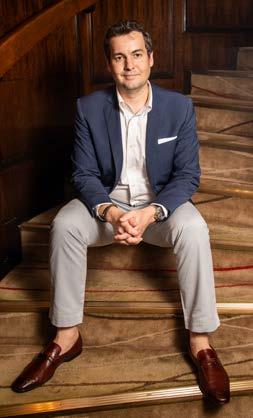
One of the things I love most about this Club of ours is that tenacious spirit. From our events programme to the upkeep of our building, the commitment of members dedicating their time and expertise is the glue that runs through the core of the FCC, like a stick of Brighton rock, binding us together as one.
The Foreign Correspondents’ Club, Hong Kong
2 Lower Albert Road, Central, Hong Kong
Tel: (852) 2521 1511
Fax: (852) 2868 4092
Email: fcc@fcchk.org
Website: www.fcchk.org
President Lee Williamson
First Vice President Morgan Davis
Second Vice President Tim Huxley
Correspondent Member Governors
Karly Cox, Jennifer Jett, Karen Koh, Kristie Lu Stout, Dean Napolitano, Peter Parks, Laura Westbrook, William Zheng
Journalist Member Governors Zela Chin, Joe Pan
Associate Member Governors
Liu Kin-ming, Lynne Mulholland, Christopher Slaughter, Barbara Yu Larsson
Club Treasurer Tim Huxley
Club Secretary Liu Kin-ming
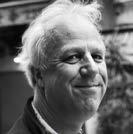

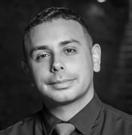

John Batten
John comments, broadcasts and writes on art, culture, urban planning, heritage and policy issues. He is also a director of the arts education group Rooftop Institute and currently President of AICAHK.
Steven Knipp
A long-time Hong Kong resident, Steven is a veteran American journalist and photographer. His work has appeared in The Washington Post, The New York Times and National Geographic, as well as numerous other publications and websites.
Hugo Novales
Hugo is the FCC’s in-house journalist, covering events for the website and social media, contributing to The Correspondent, and helping organise and promote workshops for early/midcareer journalists.
Dickie Suzuki
Dickie has made Hong Kong home for over three decades. He finds joy in photographing the city’s cinematic beauty, as he focuses on capturing a utopian bygone past, framing subjects that seem ambiguous in time and place.
Editor Ann Tsang Email: editor@fcchk.org
Publisher Artmazing! Noel de Guzman Email: artmazingcompany@gmail.com
Cover image Dickie Suzuki
Printing Elite Printing: Tel: 2558 0119
Advertising Enquiries FCC Front Office: Tel: 2521 1511
Professional Committee
Conveners: Lee Williamson, Jennifer Jett, Karen Koh, Joe Pan, William Zheng
Journalism Conference Sub-Committee Convener: Dean Napolitano
Press Freedom Committee
Conveners: Lee Williamson, Morgan Davis, Jennifer Jett, Karen Koh
Constitutional Committee
Conveners: Liu Kin-ming, Peter Parks
Membership Committee
Conveners: Karly Cox, Jennifer Jett, Zela Chin, Dean Napolitano
Communications Committee
Conveners: Zela Chin, Morgan Davis, Dean Napolitano
Finance Committee
Treasurer: Tim Huxley Conveners: Karen Koh, Lynne Mulholland
House/Food and Beverage Committee
Conveners: Lynne Mulholland, Barbara Yu Larsson
Building – Project and Maintenance Committee
Conveners: Liu Kin-ming, Christopher Slaughter
Wall Committee
Conveners: Kristie Lu Stout, Peter Parks
Charity Committee
Convener: Morgan Davis

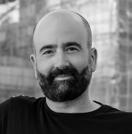
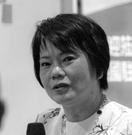

Aaron Busch
Aaron’s career has included radio journalism, print and radio announcing. He currently runs one X account for Hong Kong news, a nightly Substack newsletter and is the X social media manager for the Kowloon Cricket Club.
Ben Marans
Ben has been a freelance photographer for nearly a decade, with most of that time spent in Hong Kong. He has spent countless hours criss-crossing the city, documenting the people and places that make it so special.
Christina Pantin
Christina is a Malaysia-born, U.S. citizen who is fluent in financial journalism and corporate communications. She is the Founder of communications consultancy Toot and a founding member of Global Commtrepreneurs Network and Web3 Women.
Russel Wong
Russel Wong is one of the most prolific portrait photographers in Asia. To date, he has shot 17 covers for TIME magazine and continues working across the world to produce striking images.
The Correspondent ©2025
The Foreign Correspondents’ Club, Hong Kong
TheCorrespondent©2025ispublishedfourtimesayearbyTheForeignCorrespondents’Club, HongKong.Allviewsexpressedinallarticlesarethoseoftheauthorsandarenotnecessarily thoseofTheForeignCorrespondents’Club.AllcontentcontainedwithinTheCorrespondent magazinemaynotbereproducedinanymannerwhatsoeverwithoutauthorisation.


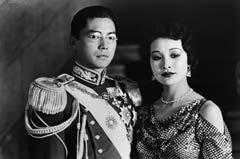

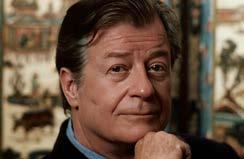
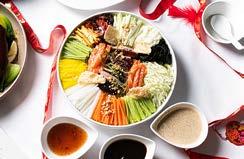
Occupying a Grade 1 historic building that is more than a century old can be both a blessing and a bane, but Members of the FCC probably can never imagine being anywhere else but at 2 Lower Albert Road, our home since 1982. 2024 saw the completion of a five-and-a-half-month renovation project which underscores the Club’s commitment to the maintenance of this Central landmark. 12
Music Man, And Much More
He was a Pulitzer prize winner in 1997, but he’s not a journalist. He was in town to play at a concert, but didn’t play a note at our FCC event. And at the beginning of his 40+ year music career, this jazz maestro didn’t start out playing or even liking jazz (he and his older brother Branford, instead veered into funk). Christina Pantin recalls the legendary Wynton Marsalis's visit to the FCC late last year. 16
Arguably China’s most prolific actress, in 2024 Joan Chen received two Career Achievement Awards from the Newport Beach Film Festival and the Critics’ Choice Celebration of AAPI and her most recent performance in Sean Wang’s ‘Didi’ has also met with critical acclaim. The Correspondent looks back over Chen’s storied career.
With the imminent completion of an iconic new landmark in Central, The Correspondent casts a backward glance at the life and times of the late Zaha Hadid and pays tribute to one of the great visionary architects of our time.
It was 1990 when a tall stranger walked into the FCC one dark and rainy afternoon. Stephen Knipp was an observer sitting at the Main Bar, and much to his chagrin, narrowly missed the opportunity to meet his longtime literary hero.
The FCC has selected Kriti Gandhi and Jay Ganglani as the recipients of the sixth annual Clare Hollingworth Fellowship, named after the pre-eminent and groundbreaking journalist.
The FCC’s Hollingworth Fellowship honours early-career journalists and current journalism school students in Hong Kong. This year’s judges noted that the winners show strong potential as future leaders both within the FCC and the wider journalism community in Hong Kong.
The open competition drew a diverse range of applicants. The adjudicators noted the high standard across the board
and encouraged all to apply again next year. At a reception to welcome the new Fellows, past recipients of the Fellowship, including outgoing Fellows Eudora Wang and Mithil Aggarwal, shared their experiences with Kriti and Jay. Also attending were members of the Board, including President Lee Williamson, First Vice President Morgan Davis, Correspondent Governor Jennifer Jett, and Journalist Governor Zela Chin, as well as Fellowship judge Nick Jones, who all encouraged the two new Fellows to get the most out of their Fellowship over the next year.


Kriti Gandhi
Kriti is a freelance journalist and recent graduate of the University of Hong Kong, holding a Bachelor’s degree in Journalism and Marketing. She has worked with CNN and NBC News in the past and is currently a freelance associate video producer at the South China Morning Post.
“I am truly honoured to be chosen for the Clare Hollingworth Fellowship this year. I applied because it offers an unparalleled opportunity for a young journalist like myself to grow and develop, both professionally and personally. In the coming year, I hope to contribute and give back to the FCC by actively organising and engaging in community initiatives. This experience is a significant milestone in my career, and I intend to make the most of it by further enhancing my skills, expanding my network, and becoming a part of the FCC community.”

Jay Ganglani
Jay is a Hong Kong-based journalist with a passion for covering the city’s ethnic minority communities. His work has appeared in NBC News, Asia Sentinel, Fortune, the South China Morning Post, and other publications. He holds a Master of Journalism degree from the University of Hong Kong.
“It’s an absolute honour to be selected for the Fellowship and to even have my name next to a path-breaking journalist like Clare Hollingworth. As a freelance journalist, I’m really looking forward to meeting some wonderful people and I hope it will lead to more exciting opportunities in the future. I would like to be able to make a meaningful contribution to the FCC by helping to organise events and writing for The Correspondent.”
Save the date! This year’s FCC Journalism Conference is set for Saturday, 3 May 2025.
The day-long event at the FCC will include panels, workshops, and networking opportunities for established reporters and editors, as well as early-career journalists.
As the nature of news gathering continues to evolve, the conference will aim to serve attendees with the foundation they need to do their work accurately, fairly, and ethically.
A list of panellists, moderators, and speakers will be announced in the first quarter of 2025.
The 2024 Journalism Conference included representatives from the South China Morning Post, Hong Kong Free Press, Tatler Hong Kong, The Collective Hong Kong, Agence France-Presse, the Financial Times, The New York Times, Al Jazeera, CNN, NBC News, ProPublica, The Information and Splice Media.

As part of the FCC’s outreach and goal to support global Diversity, Equity, and Inclusion (DEI) initiatives, last October President Lee Williamson hosted a tour and sharing session for students visiting Hong Kong from the University of Westminster as part of the Westminster Working Cultures (WWC) programme. The programme provides students from underrepresented and marginalised backgrounds with international mobility opportunities to 11 locations across the world, including Hong Kong. Through these trips, the programme helps Westminster students gain insights into various job markets, cultural awareness and confidence skills needed for their future careers. Nearly 20 students participated in the WWC’s Hong Kong trip. Williamson spoke about the FCC, the media, and working life in Hong Kong, and answered their many questions. The students also heard directly from Club staff about the FCC’s history and how it provides opportunities for early-career journalists and journalism students across the city. n
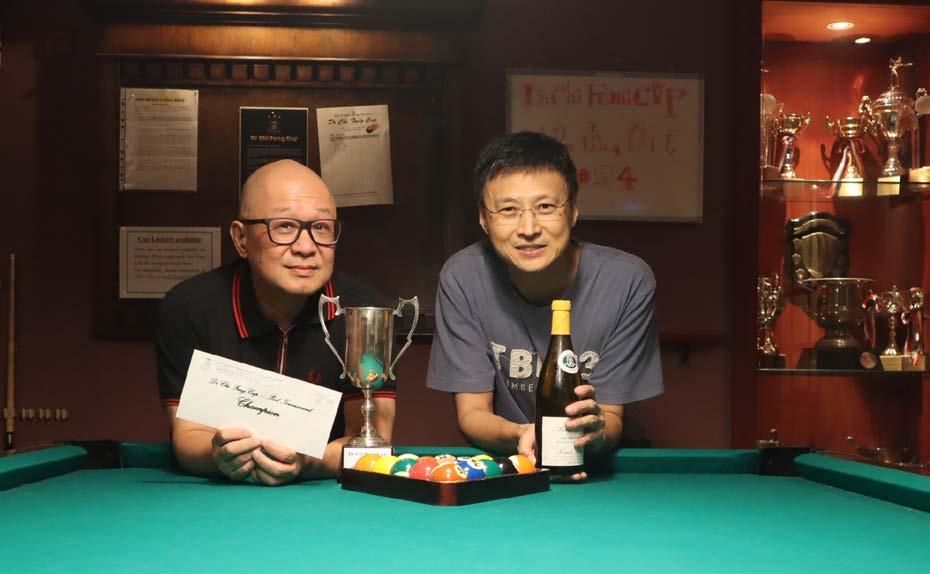
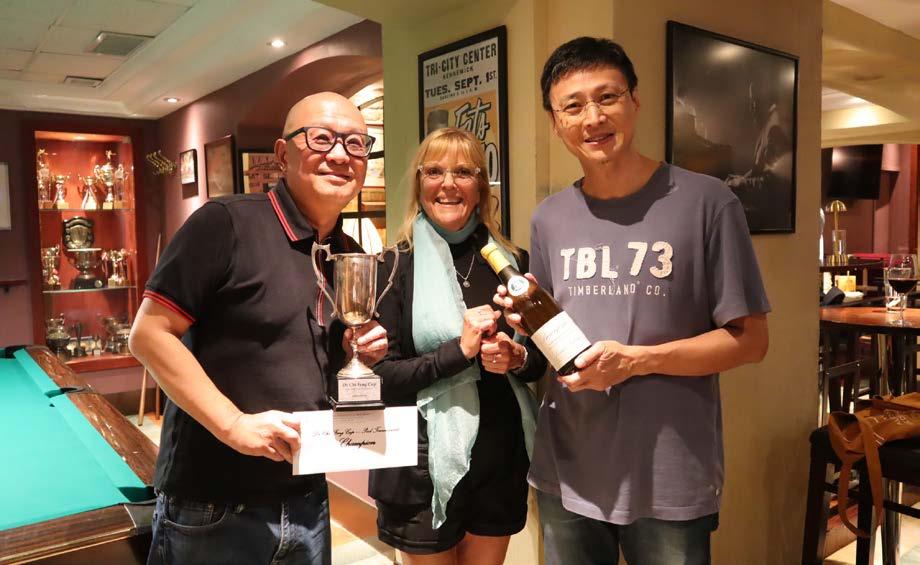
12 October saw the return of the annual pool tournament organised by the FCC Pool Players’ Society. The Dr. Chi Feng Cup honours the late, great cueist who was both loved and feared when he held court at the table. “His skill was a delight to watch, but perhaps not so if you were his opponent!” notes Pool Player Society Chairman, Tony Chan, whose prowess led him to victory this year over Runner-Up Joe Nieh.
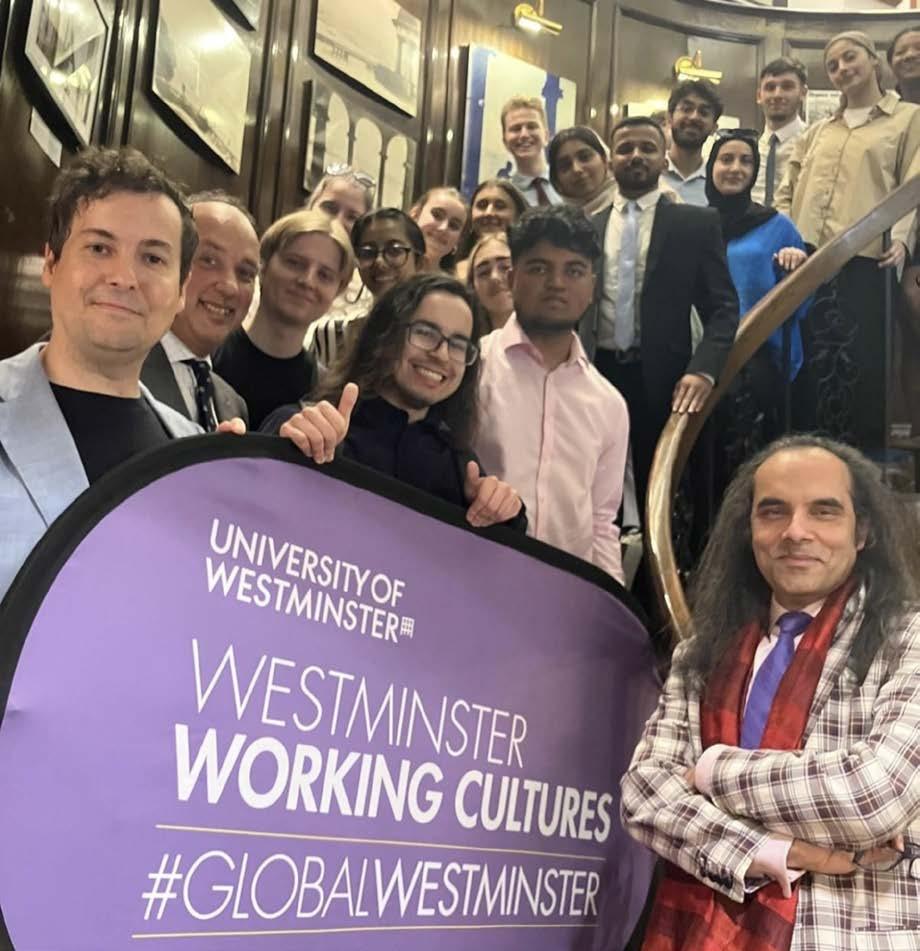
Members think of the Club as a “home away from home”, a respite from the fast pace of Hong Kong life where they can enjoy good food, good friends and good conversation. Your FCC Membership also opens doors to almost 100 reciprocal clubs when you travel. This carefully curated list includes press clubs (like the National Press Club in Washington DC), and military clubs (Clube Militar De Macau); national clubs (Tokyo American Club) and political clubs (The National Liberal Club, London, U.K.); sports clubs (Singapore Cricket Club) and dining and social clubs (Saint James Club of Montreal); special interest clubs (Royal Automobile Club, Sydney, Australia) and artistic, scientific and literary clubs (The Cosmos Club, Washington DC) and many, many more.
Many of these are housed in historic buildings with wonderful locations in the centre of town – in or close to the central business district – and some offer accommodation at much lower rates than nearby hotels, while providing the friendly and welcoming atmospheres for which private clubs are known. One FCC Member stays at a reciprocal club once each year and is greeted personally by name every time. At one club I managed, a local businessman had a very successful meeting with potential clients in New York City. He suggested that they meet at “my club”, meaning his reciprocal club in NYC, which provided an entrée to the city’s business establishment.
Reciprocal clubs are a valuable Member benefit and one that we are promoting through The Correspondent. In the last issue, Member Ray Tsang wrote about his experience visiting the Tokyo American Club. My column in this issue includes a brief profile of our latest reciprocal club, the American Club Taipei, which I managed for three years.
If you would like to share your experience at one of our reciprocal clubs, please write to me at gmoffice@fcchk.org. A full list of these clubs is on our website and Ivan Kwan at the front desk will be pleased to prepare a letter of introduction
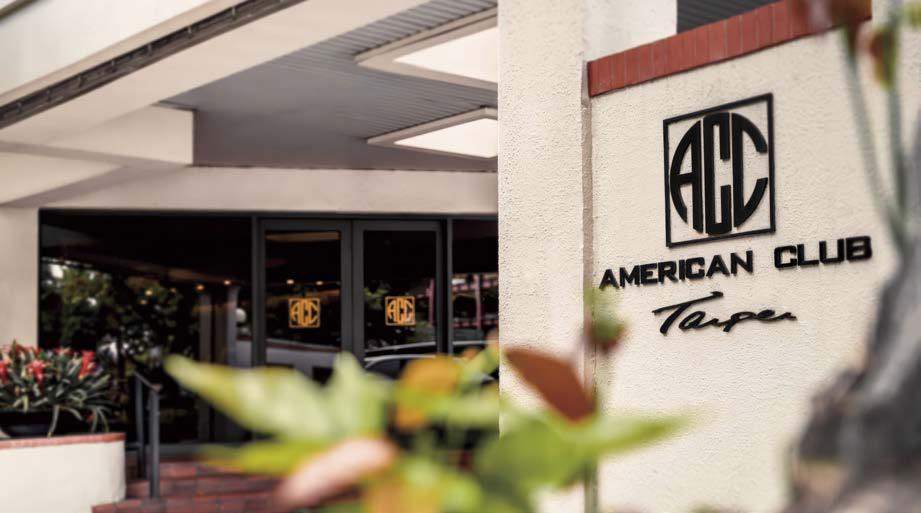
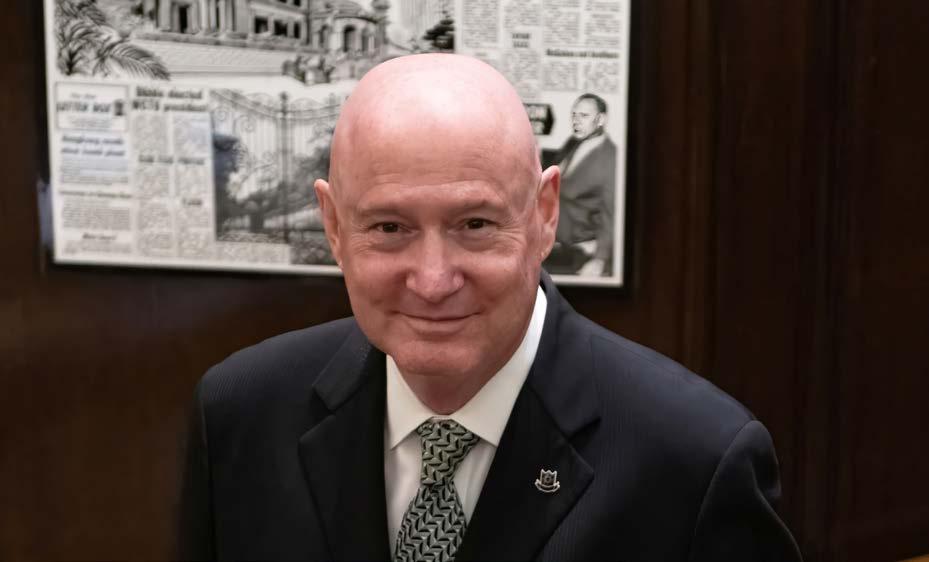
for you so that you can have a “home away from home” wherever your travels take you.
Introducing the American Club Taipei, our newest reciprocal club
Situated between the historic Grand Hotel and the Keelung River, the American Club Taipei (formally the American Club in China, or ACC for short) was established in 1968 in a former American military club. Today it is a vibrant, international family club, with a range of dining options and sports and recreation facilities, all in a friendly, casual and welcoming environment. Dining options include The Terrace, the international all-day dining outlet, Sigis, the Club’s Italian restaurant, and the ever-popular Gyoson, serving fine Japanese cuisine. Rendezvous, the ACC bar, has a similar atmosphere to Bert’s. Like the FCC, the American Club is unpretentious, and you will find it easy to unwind and make new friends.
Joe Pan, Journalist Governor, had the pleasure of visiting the American Club Taipei just before the holidays. He was impressed by the Club’s festive, family-friendly atmosphere. “The food and service at the Italian restaurant were excellent, and the highlight was the full-service deli, stocked with a great selection of imported and local goods.”
For Members planning a visit to Taipei, Joe recommends stopping by the ACC after exploring the Taipei National Palace Museum or the Shilin Official Residence, both just minutes away by car or taxi. Another plus is that there are also ample parking spaces on-site.
While the Club does not have accommodation, it has alliances with several hotels, for members, their visiting family and friends, and reciprocal club visitors from around the world – at special rates. You may preview these – and get a feel for the Club – at the website www.americanclub.org.tw. If you happen to bump into their personable General Manager, Peter Wood, please tell him that David sent you! n
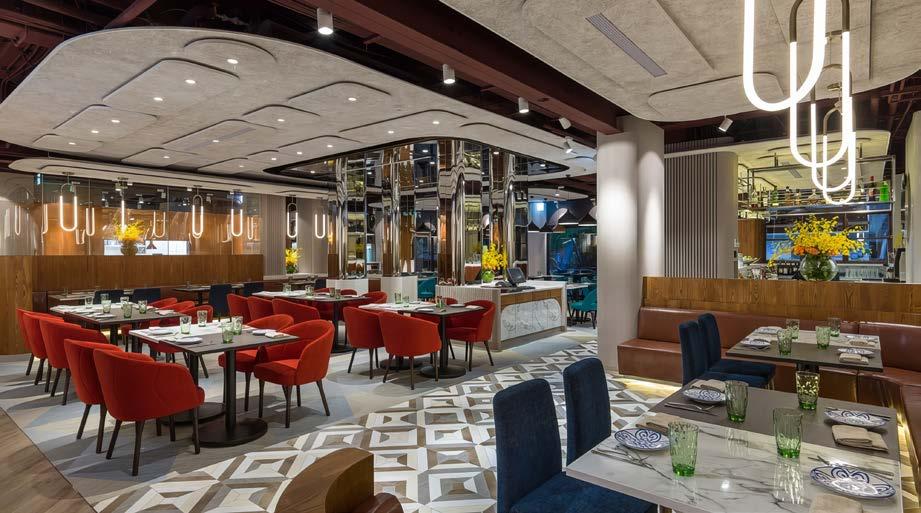
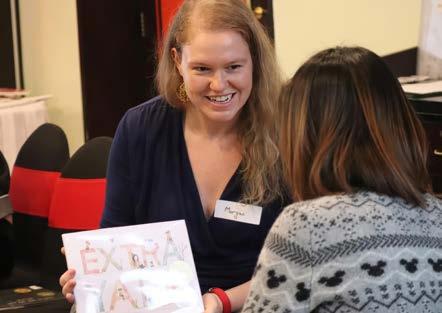
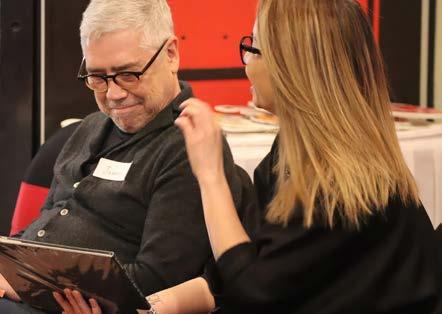
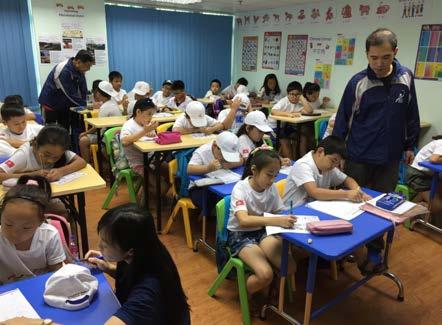
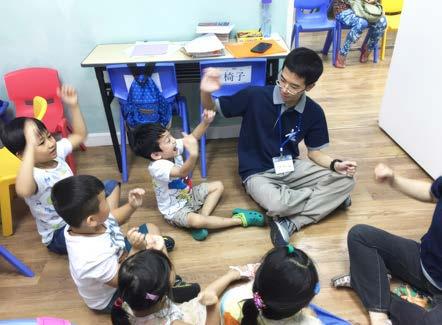
By Morgan M. Davis
Education is free in Hong Kong, but for many families, the basics offered are not enough.
Three of the FCC’s chosen partner charities work to bridge these gaps, giving students additional opportunities and support to succeed in the city.
Integrated Brilliant Education (IBEL) focuses its work on the non-Chinese speaking communities. Since 2015, the organisation has provided Chinese language support, as well as all around skill development to students from these communities as they may often miss out on access to extras outside of the classroom. IBEL’s work is an investment in the future of Hong Kong, as it strives to better all young people, regardless of their ethnicity or language abilities.
Branches of Hope works with refugees, asylum seekers and human trafficking survivors in Hong Kong. As part of its programme, they offer education support for children and teenagers, as well as adult vocational training.
One part of this is the Keeping Kids in Kindergarten programme that enables the children of refugees to attend kindergarten. While these children are often eligible to receive free school tuition, their families are still required to pay for uniforms, books, snacks, activities and other fees that may be prohibitive.
Bring Me a Book Hong Kong looks to help encourage literacy in the city by providing age-appropriate books,
community training and related activities for schools and community centres. Children are given access to both Chinese and English language books and are encouraged to develop a passion for reading from a young age. Bring Me a Book connects directly with children through group reading and activities, and the organisation works closely with parents to train them to participate in reading with their children.
The FCC’s work with these organisations kicked off in 2024. In December, the Club hosted Bring Me a Book for a training day, with Members joining to learn more about the charity, and receiving basic training on active reading to use at future volunteer days.
Also recently, FCC President Lee Williamson facilitated a visit to the South China Morning Post office for IBEL students to learn more about career opportunities.
These charities, along with the six other groups the FCC has partnered with this year, are seeking additional help from FCC Members and are eager to connect in order to share more about their missions.
Members are encouraged to commit to volunteer with a charity of their choice this year, and we will be updating activities through the Club website’s charity page. To join the FCC’s “One Day’s Work” programme, please visit: https://www.fcchk.org/charity-stage-2/ n
Occupying a Grade 1 historic building that is more than a century old can be both a blessing and a bane, but Members of the FCC probably can never imagine being anywhere else but at 2 Lower Albert Road, our home since 1982. 2024 saw the completion of a five-and-a-half-month renovation project which underscores the Club’s commitment to the maintenance of this Central landmark.
By Christina Pantin
Images: Dickie Suzuki
Leased to the FCC by the Hong Kong Government, 2 Lower Albert Road is the Club’s fourth location in the city since 1949, when it relocated from Mainland China. The FCC occupies the north block of the expanded old Dairy Farm depot warehouse originally built in the 19th century that once included a cold storage area and a dairy shop. The Fringe Club takes up the south block of the building and its etched 1913 birth date is clearly visible close to its rooftop.
The building is an example of the eclectic architectural style with strong Neo-Classical and Arts and Crafts influence – something of a rarity in a city where others of its era have not made it through the passage of time.
Originally designed by architects Danby & Leigh in 1892, Number 2 was listed as a Grade 2 historic building in 1981, and in 2009 it reached the coveted Grade 1 status, conferred by the Government’s Antiquities and Monuments Office (AMO).
The grand old lady got a needed facelift last year in a fiveand-a-half-month renovation project that saw the repair of the splatter dashes – the creamy slabs in between the brick bands – as well as a “dentist repair method” (more on that below) to reuse damaged bricks. You might recall seeing scaffolding enclosing the Club during that time, along with colourful “rainbow” tarps that sought to distract, which ended up being a tourist photo attraction (I kid you not!).
For Christopher Slaughter, Co-Convener of the FCC’s Building Project and Maintenance Committee, and a past President, the Club is more than the building it lives in. “The location suits us as a club very well; it has been our home for a long time, and we have an obligation to maintain it as a heritage building.”
The recent project was the first renovation of the exterior of the Club in some time, and also encompassed fixing the pitched roof tiles, iron cast pipes, decorative mouldings and the flat roof. Slaughter says these were not “material
improvements” but were done to maintain the building as a responsible tenant. “It’s a labour of love,” he notes, while adding that there will surely be “more (fixes) to come”, given the age of the edifice.
For John Theofilidis of Blue Stone Management, who managed the renovation project, the length of the assignment from start to finish was a full 15 months, given the need to get various government body approvals (the AMO and the Government Property Agency, among others), work with a heritage consultant, and conduct surveys to assess what needed to be repaired.
Theofilidis was delighted to be selected for the task, noting the rarity of its architecture style, with Neo-Classical flourishes like moulded cornices, bull’s eye windows, architraved windows, keystones, pilasters, pediments, and perhaps the most distinctive feature – the polychromatic bandaged brickwork. To the uninformed eye (including mine), it may look as though little to no work has been done to the building. In a sense, this was exactly the point – to ensure that all of the repairs resulted in a seamless match with the original materials.
In the case of the bandaged brickwork – so called because of the resemblance to bandages around the buildingTheofilidis said that an impressive 95 percent of the original bricks were still in good shape. For those that needed to be fixed, the team went back in time for the solution, ordering new ones from the original maker, Sussex Handmade Brick.
The venerable U.K.-based company founded in 1896 first sent four to five samples “to make sure they were the same colour,” explains Theofilidis. Another solution was the “dentist repair method” which involved extracting the damaged bricks and turning them around so that the protected inward face became the new exterior surface. “We rotated them, as we wanted to use as many of the existing ones as possible,” he notes.
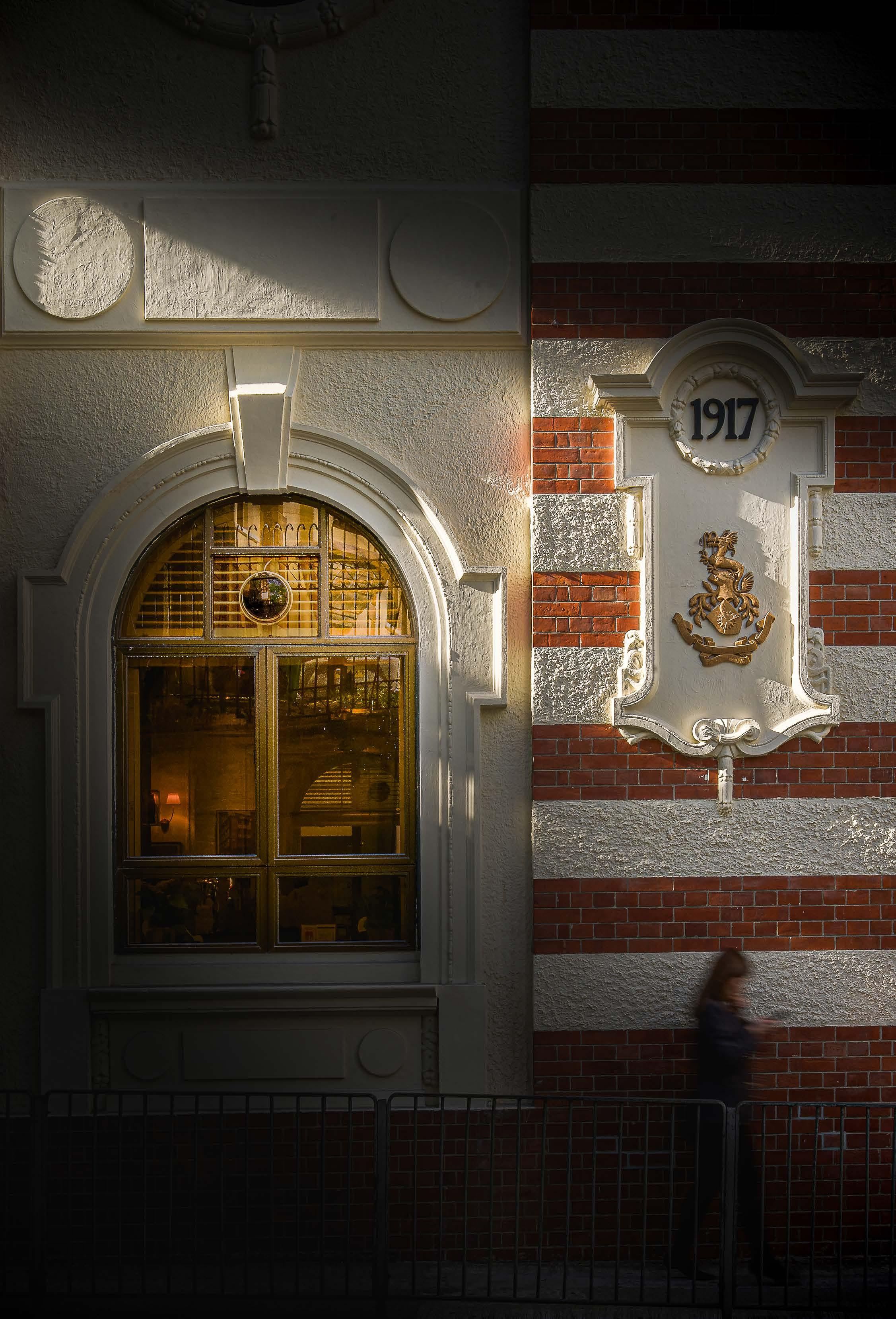
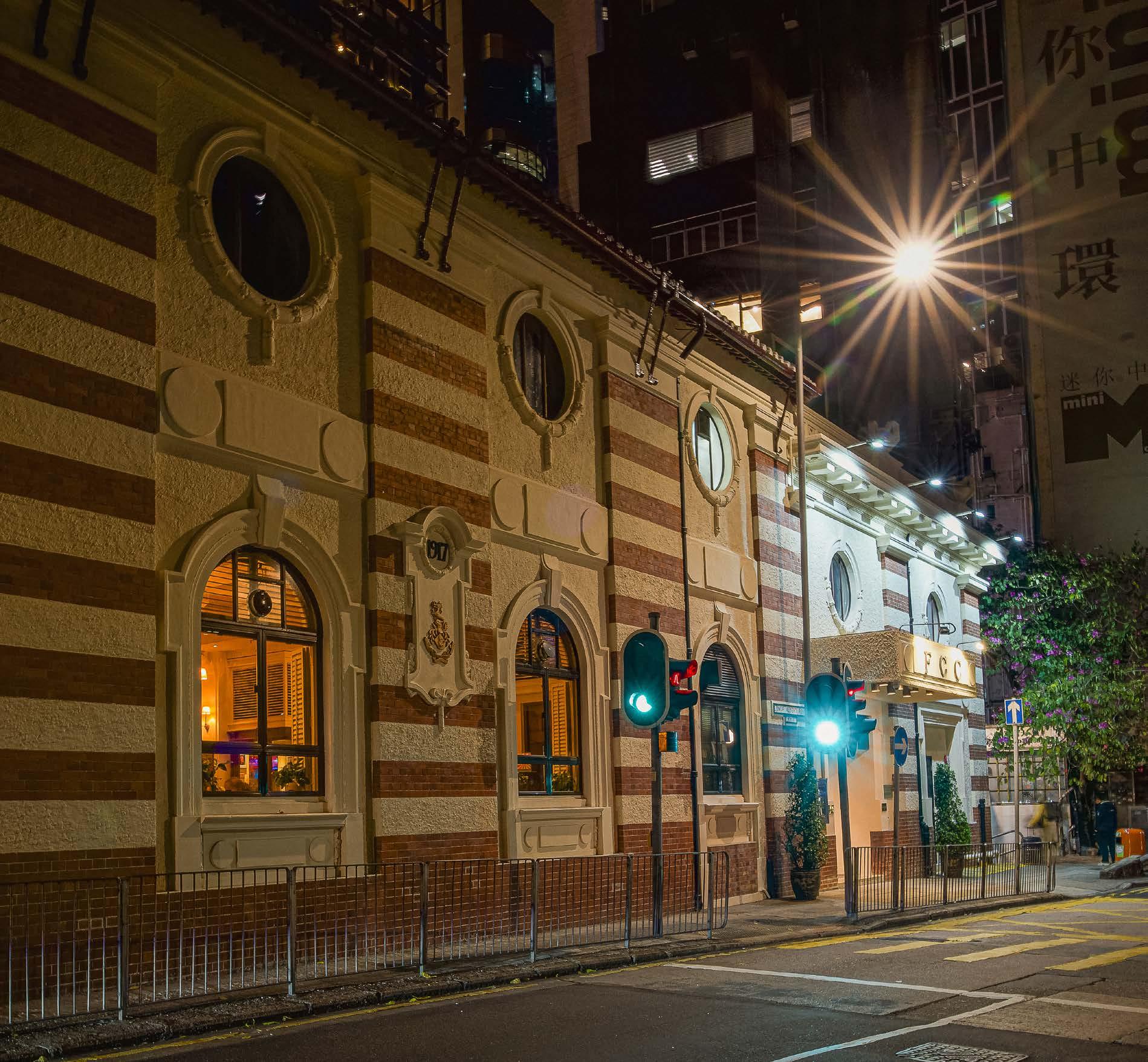
The renovation team also went back to the original source for metal pins to repair the cream-coloured splatter dashes, some of which were coming off the brickwork. The U.K.’s Leviat Helfix building materials supplier, which has roots going back to 1882, was tapped for the pins.
While reaching back in history offered key solutions for the project, the team also deployed high-tech tools, particularly during the survey and assessment stage, including conducting an infrared scan, using a drone for an aerial view of the pitched roof where some of its doubleroll tiles had slipped, and carefully using a steam cleaning machine that produces low pressure at a high temperature to remove the accumulated grit caused by pollution and weathering.
There was also the requirement to undertake the renovation while the Club remained fully operational and to avoid interfering with its regular functions. Theofilidis counts this as the most challenging aspect of the project. “We had to carry out the work in a live environment,” he said,
noting that waterproofing work on the flat roof had to be done extremely carefully so as to not disturb the large equipment located there, including the air conditioning units.
Now that the project is complete, Theofilidis reflects that the assignment has become one for his company’s history books. “We’re proud to be associated with such a prominent building.”
Slaughter is relieved that this refurbishment is completed, but is already eyeing future needs, such as the Club’s dumb waiters, critical pieces of equipment that are used to ferry food between the kitchen on the main floor to the basement and upstairs dining venues.
“It’s tricky to maintain the three cars as they’re in constant use,” says Slaughter. “They’re 40 years old, and it’s a very specialised piece of equipment that has been customised for our building.” Another looming big-ticket item will be the aircon chillers, which will have to be removed from the roof and replaced in a few years.
But these stories will be told as they unfold. n

ONCE UPON A TIME...
It was way back in 1866 when The Dairy Farm Company Limited was established in Hong Kong by Scottish surgeon Sir Patrick Manson and five prominent Hong Kong businessmen, with a capital of HK$30,000 and 80 cows. The Company’s founding objectives were: “to improve the health of Hong Kong people by supplying clean and uncontaminated cows’ milk at an affordable price and to realise a profit for its shareholders.”
The old Dairy Farm Depot was established at No. 2 Lower Albert Road in 1892 as a Central location for the distribution of milk from the company’s production facility in Pok Fu Lam.
In 1904, Dairy Farm opened its first retail store at Lower Albert Road and began importing frozen meat from Australia. By 1916, the Central depot housed Hong Kong’s first supermarket/delicatessen.
In the late 1970s, the company relocated from Lower Albert Road and the building stood empty, awaiting demolition. The FCC was looking for a new home following the tearing down of Sutherland House and tried for Murray House, but ended up with one block of the Dairy Farm building, while the other half was set aside for the Fringe Club in 1984.
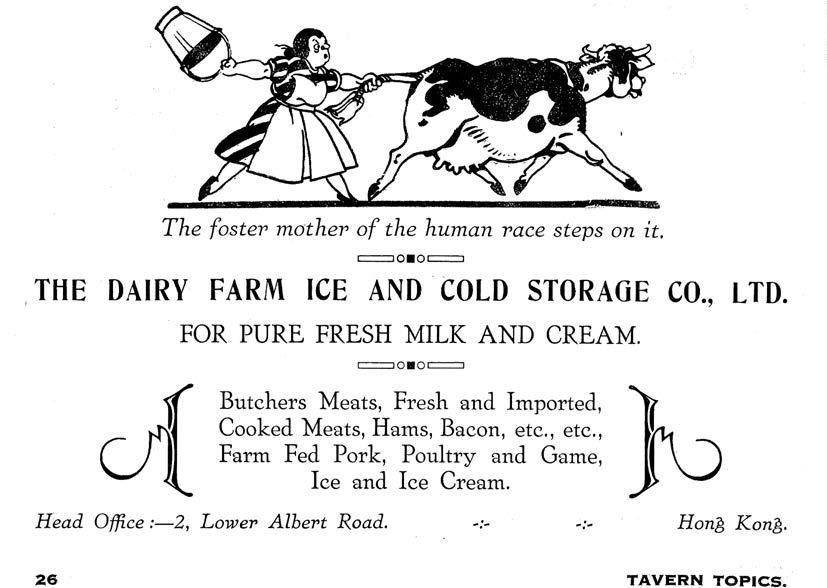
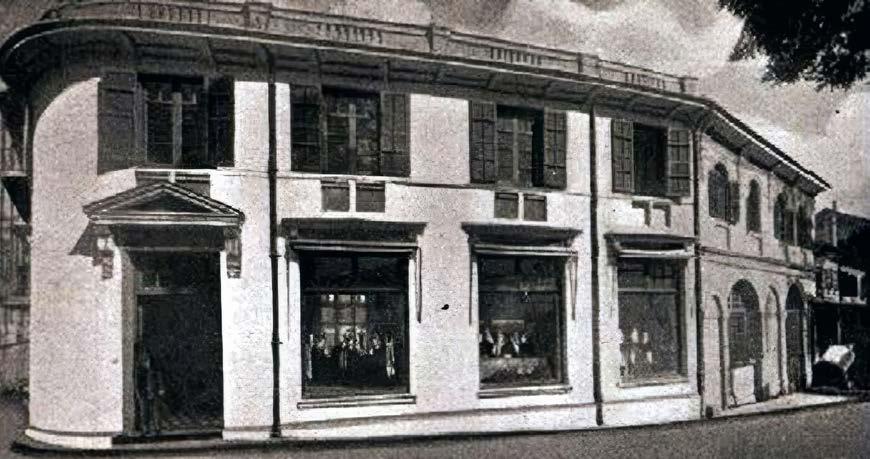
He was a Pulitzer Prize winner in 1997, but is not a journalist. He was in town to play at a concert, but didn’t play a note at our FCC event. And at the beginning of his 40+ year music career, this jazz maestro didn’t start out playing or even liking jazz (he and his older brother Branford, instead veered into funk).
By Christina Pantin

To say that Wynton Marsalis is multi-faceted and oneof-a-kind doesn’t cover it.
It would take much more than a single FCC lunch talk to get the full measure of the Grammy-winning jazz and classical trumpeter, band leader, educator, composer and lifelong learner. But one session was all we had, and on 18 October 2024 – his 63rd birthday – Marsalis tackled an array of music and music-adjacent topics seamlessly and left us all wanting more.
FCC Member Robin Ewing, host of the Feeling Kinda Sunday jazz programme on RTHK, and the Director of the Hong Kong Baptist University’s International Journalism Master’s Programme led the discussion.
The son of a jazz pianist Ellis, Wynton Marsalis is an unapologetic “old school” jazz traditionalist who has played with and been tutored by legends including Art Blakely, Dizzy Gillespie and Sarah Vaughan.
In 1997, for the first time in the history of the Pulitzer Prize in Music, the award went to a genre intimately bound up with the cultural, social and racial history of America: jazz. Marsalis’ ‘Blood on the Fields’, an epic vocal-orchestral suite that dealt head-on with the subject of slavery, became not only the first jazz work to take the highest honour in American music but also the first non-classical piece ever to win.
Appearing in the Main Dining Room of the FCC, Marsalis took a pause from a packed schedule that also took him and his Jazz at Lincoln Center Orchestra to Beijing, Shanghai, Shenzhen and Hangzhou.
IMAGE: BEN
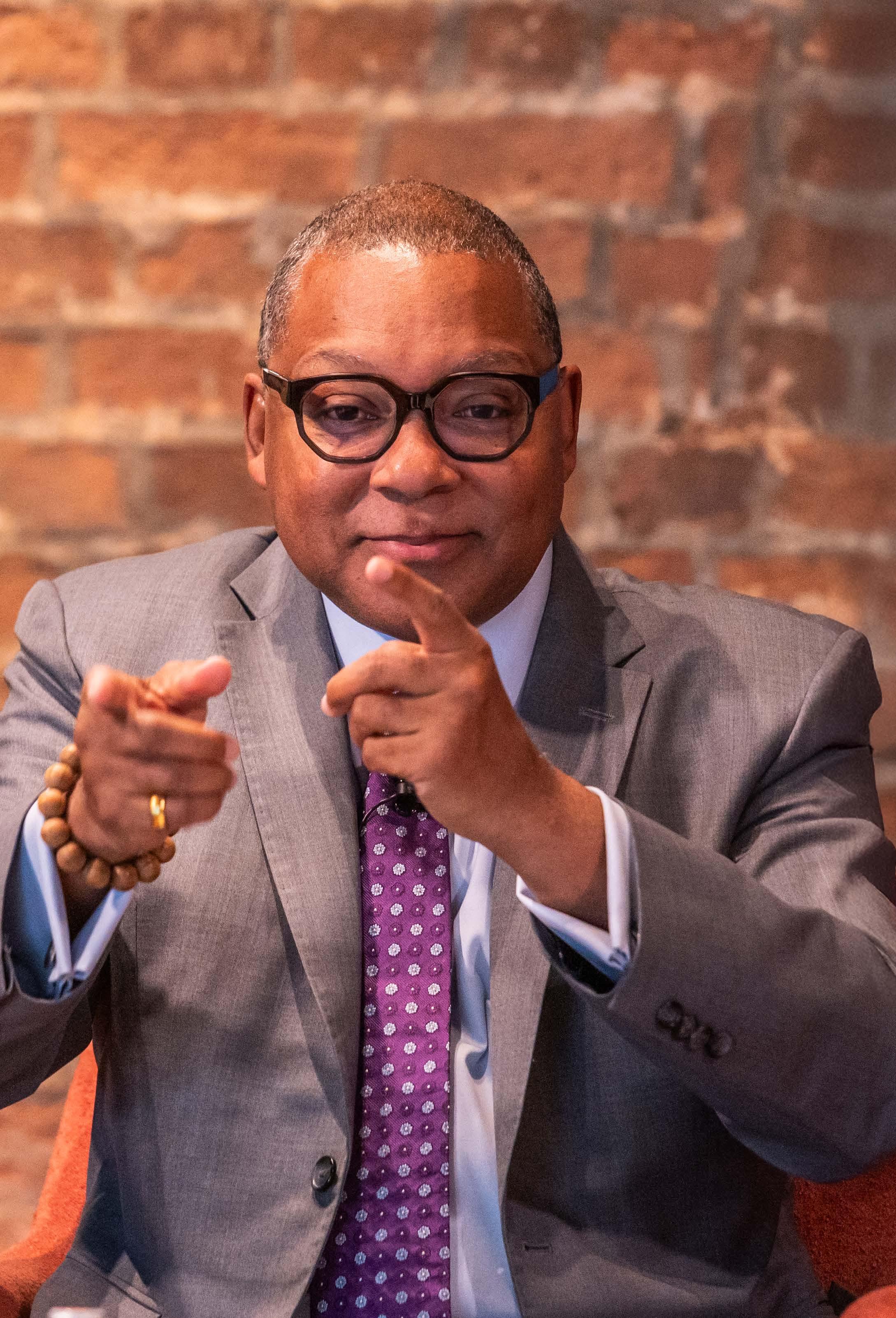
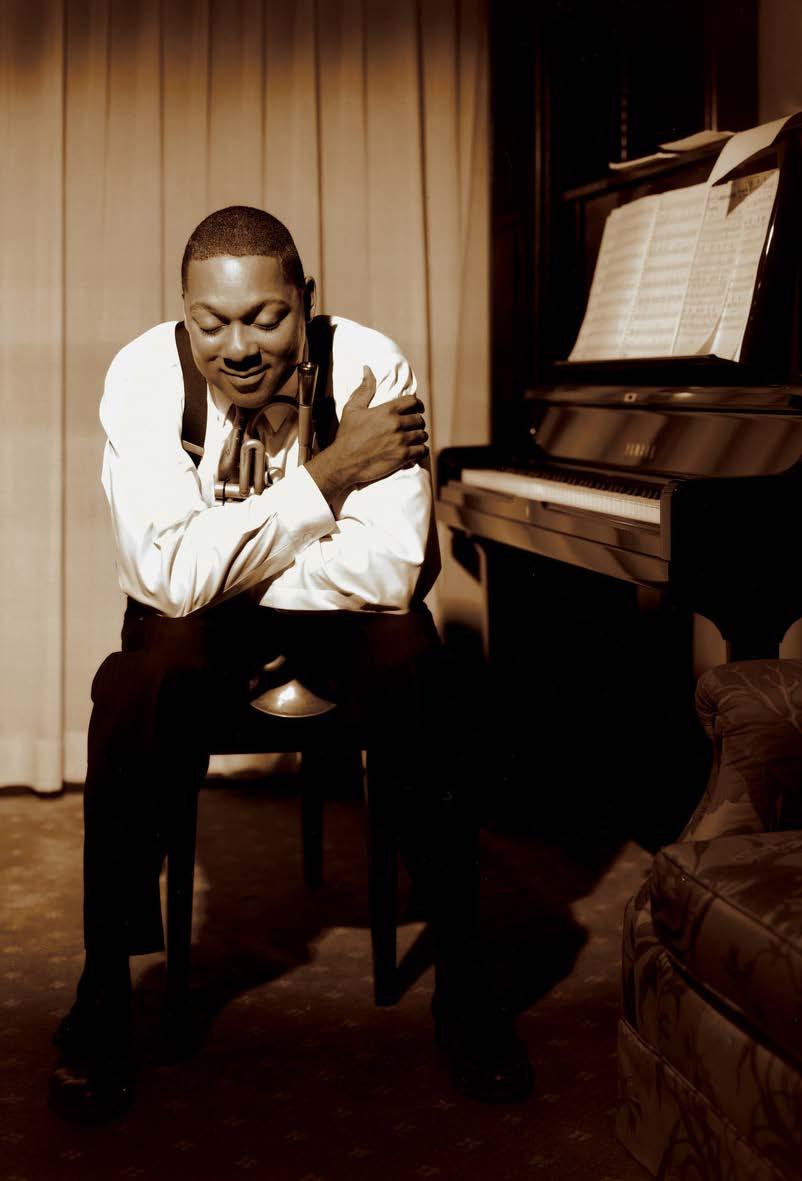
“For
any speaker that we’re thinking about, we ask what value they bring to our members. Wynton was a no-brainer – a living legend, jazz and classical composer. The sell-out crowd at the FCC showed that it was a topic that was welcomed and not one covered often.”
- Lee Williamson, FCC President
How he got started with classical music: He was 13 years old and riding a segregated streetcar in his home city of New Orleans. A white guy got onto the streetcar and put his trumpet case next to Marsalis’, who wasn’t thrilled. “You’re going to get us beat up. Do you know where you are?” he recalled thinking. The friendly stranger invited him to look at an album he had with him. The Maurice Andre record included the French classical piccolo trumpeter’s story of growing up in a family of miners, galvanising Marsalis’ curiosity – “I’ve got to put this on,” he said to himself. Listening to the record, he started to learn to play the Mozart trumpet concerto, and that marked the beginning of a love affair with classical music.
As Jazz Director at Julliard, his advice for young musicians: (I tell them) “Youth is not a value, you are young and you will become old; it’s not like intelligence or speed, it’s just a state that you are in.” Marsalis urges his students to focus on the fundamentals, learn from the masters and to “achieve the realisation of self”.
Playing in Hong Kong and Mainland China:
Marsalis said he was building on the shoulders of pioneers like Buck Clayton who had played in China in the 1930s. Marsalis had met Clayton early in his career and laments the missed opportunity to ask about the Chinese experience. “The pentatonic scales are difficult for us to understand,” he said, referring to the five note scale used in Chinese music, versus the seven in Western forms. He leans on Ye Huang, band director and music instructor of Jazz at Lincoln Center Shanghai to guide him on composing East-West music: “Is this disrespectful… is it corny? Cliche?”. Marsalis called the fusion of eastern elements “complicated”.
Lessons in empathy:
“My mother was unbelievably intelligent…and deeply empathetic,” said Marsalis, noting that Dolores Marsalis worked for an extension programme through which she would visit the homes of the poor to offer help on home economics. “She would speak the language that they understood,” he said. As an 11-year-old accompanying her, he would see empathy at work – addressing a young woman with eight children in a “filthy” house, he said she would gently chide the mother and then help to clean up the home.
Jazz diplomacy:
Marsalis turned to an example of negotiating with his older brother about music and sleep. “I can’t sleep with music on and my brother needs music to sleep. He’s bigger than me. I had to be diplomatic. I’d say give me two or three nights (of no music), you take the four (days).”
AI x music:
Asked about whether he has been approached by Big Tech companies about collaborations, or if he is aware of them scraping his music or using it to train AI, Marsalis answered, “I want them to steal from us”, noting that he is open to AI in jazz and doesn’t discourage his students from using AI tools. But he also added that music created by AI lacks “the empathy, reasoning and judgement” that are fundamental in jazz.
Some reactions:
Robin Ewing: “I had never heard that (classical music) story before. That was so special; my mom is from New Orleans, and I grew up learning all about Marsalis. I found out today that my aunt and uncle lived on the same street where he grew up. Moderating Wynton Marsalis was at the very top of my list.”
Allen Youngblood, Bert’s jazz bar’s band leader: “I loved everything (he said). He had straightforward answers – he’s himself.” Youngblood, who had a chance to greet Marsalis as he posed for portraits in Bert’s, reminded him that they had met at a music festival in Vancouver in 1981.
Lee Williamson, FCC President: “For any speaker that we’re thinking about, we ask what value they bring to our Members. Wynton was a no-brainer – a living legend, jazz and classical composer. The sell-out crowd at the FCC showed that it was a topic that was welcomed and not one covered often. I was completely bowled over by the towering intellect, the musicianship and so many insightful remarks. It was like jazz in motion.” n
If you weren’t there, or if you want to relive the experience, please go to our FCC podcast The Correspondent titled “Wynton Marsalis: talking jazz, education, China, culture, technology and beyond” on iTunes and Spotify.
After almost half a century in the film industry, the ‘Little Flower’ has finally burst into full bloom. Arguably China’s most prolific actress, in 2024, Joan Chen received bouquets of accolades, including Career Achievement Awards from the Newport Beach Film Festival and the Critics’ Choice Celebration of AAPI (Asia Pacific Cinema and Television). The Correspondent looks back over her storied career.
By Russel Wong and Ann Tsang

An outstanding performance in Sean Wang’s directorial debut, ‘Didi’ (弟弟) in 2024 unquestionably played a role in bringing actress Joan Chen back into the international spotlight, as the film took home the Audience Award for Best U.S. Dramatic Film and the Special Jury Prize for Best Ensemble at the 2024 Sundance Film Festival, as well as garnering the veteran actress rave reviews for her supporting role as long-suffering matriarch Chungsing Wang in the coming-of-age story. On a side note, the film also ranked in Barack Obama’s Top 10 Movies of 2024.
Looking back to 1987 when Bernardo Bertolucci’s ‘The Last Emperor’ deservedly took a clean sweep of nine Oscars, one might still question why neither lead actor John Lone (who played Emperor Puyi) or Joan Chen in her magnificent supporting role as Empress consort Wanrong, were recognised, especially as Casting Director Joanna Merlin won the Artios award that same year for Best Casting. The reality is that Hollywood just wasn’t ready to embrace Asian talent to the point of placing them in the spotlight.
It wasn’t until 36 years later, in 2023, that Malaysianborn Michelle Yeoh became the first Asian to receive the Best Actress award in the 95-year history of the Academy of Motion Picture Arts and Sciences for her role in ‘Everything Everywhere All at Once’, a film that took major honours left, right and centre.
During her acceptance speech at the Critics’ Choice Association Celebration of AAPI Cinema and Television last November, Chen stressed the importance of diverse storytelling and how it has taken Hollywood “quite a long time to come to the realisation that diversity is our great unique strength and beauty”, adding that, “the progress that we have made is worth celebrating.”
The actress, now a youthful and radiant 63, received a standing ovation.
Joan Chen grew up in Shanghai during the Cultural Revolution, the daughter of parents who were both medical professionals. “Our world was very small, and my life wasn’t any different to anybody else’s. Everyone lived more or less the same kind of life,” she recalls. “Food was scarce and we had one set of clothes for each season. We read what was given to us in school and then later you would be assigned a job, regardless of your interest. So we never really thought about the future.”
Chen describes herself as being a “tomboy” at school. She joined the rifle team and one day, out of the blue, a casting director arrived at the school which was located close to the Shanghai Film Studio. “They were looking for someone to play a militia girl, one that could handle a weapon and who would look the part, and so I was just plucked out of school to act in that film - I had never dreamed about anything like
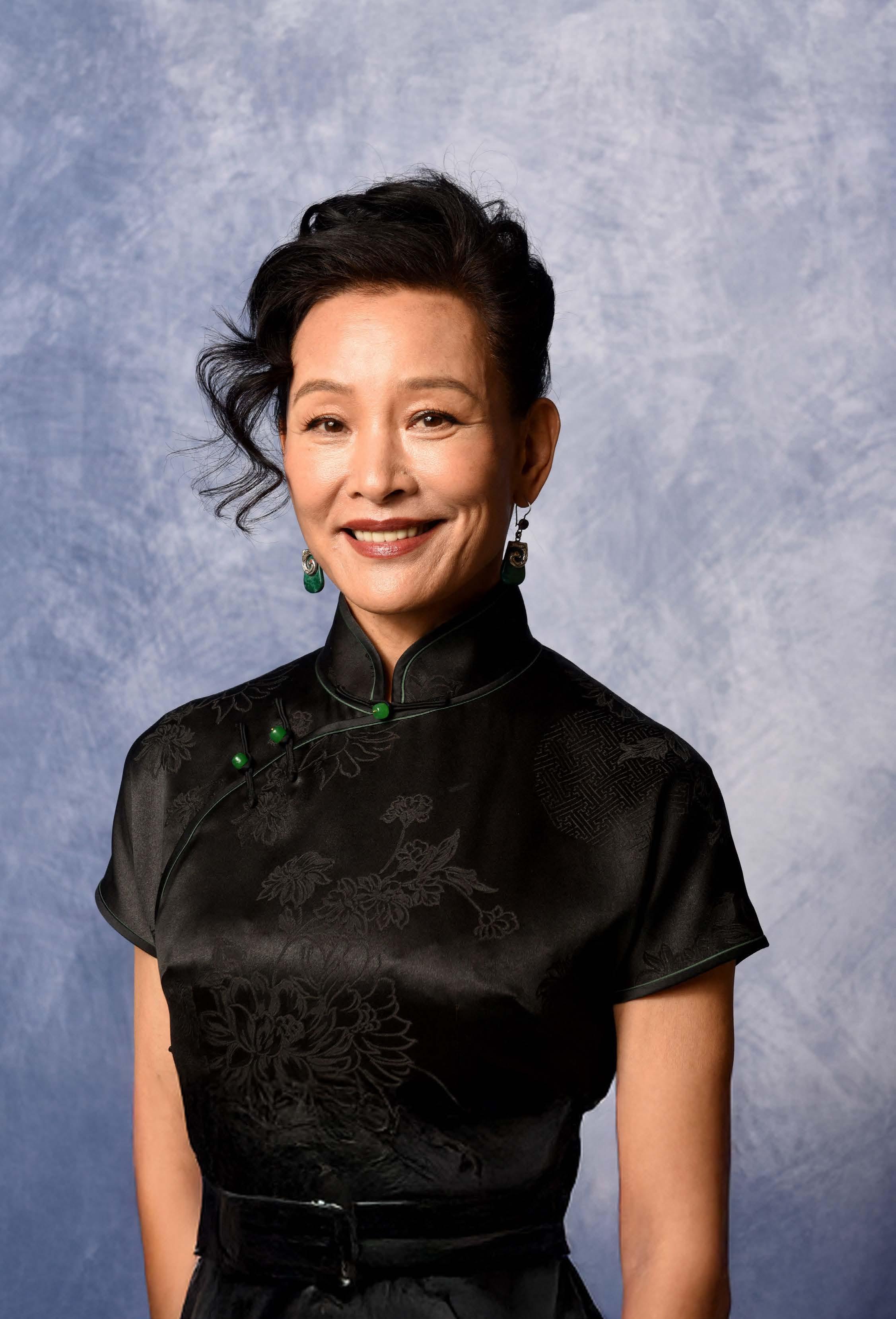
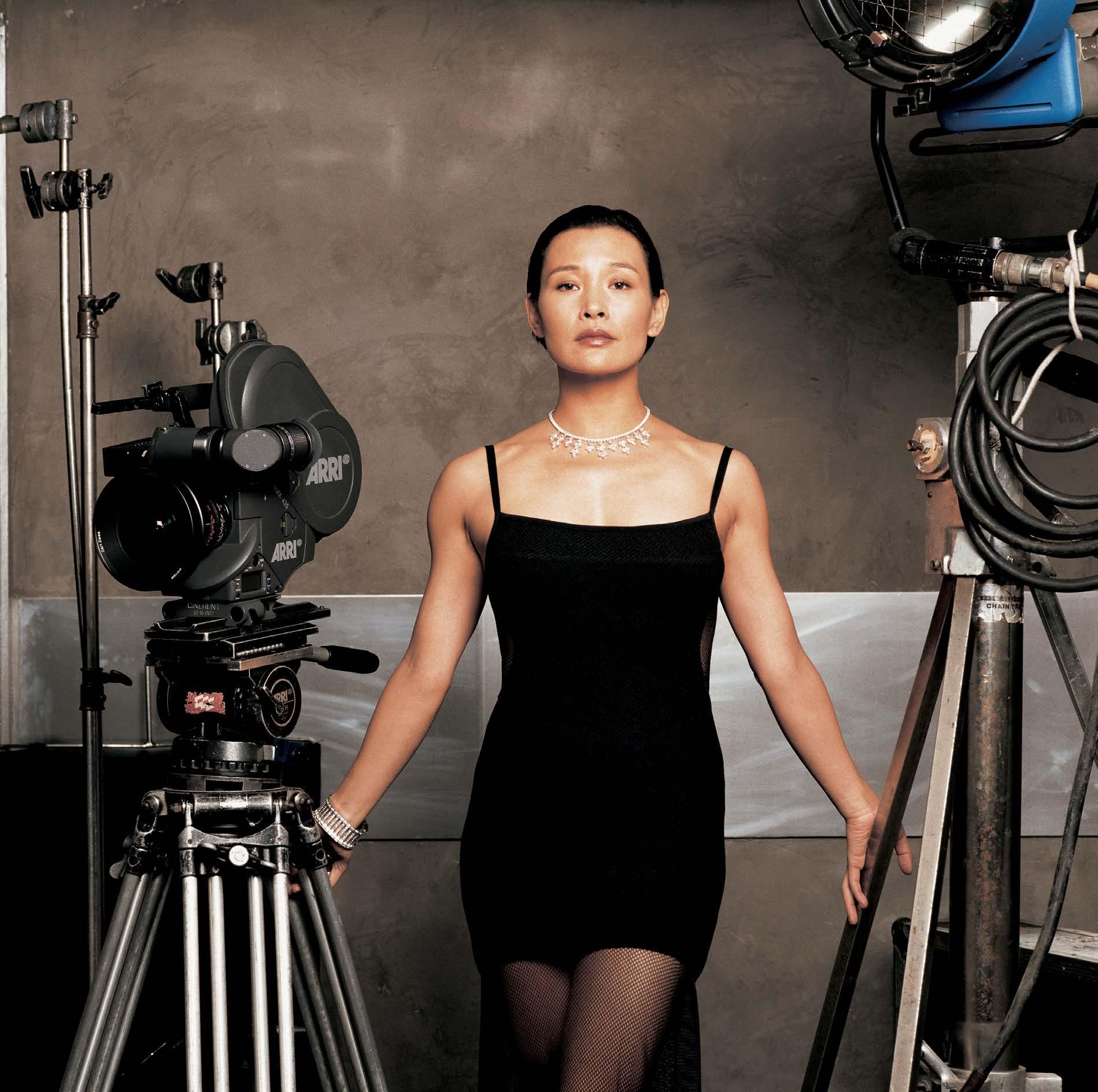
that, and I didn’t really know what movies or acting were.”
It later transpired that the Executive Director of the film, part of a planned trilogy, was Jiang Qing, the fourth wife of Chairman Mao.
“I was rehearsing with the director and everything was set to go, but I was then told to have a conversation with our producer, and he said ‘I cannot tell you the reason, but we will not go ahead with the film’,” recalls Chen.
Jiang Qing had been arrested for heading the radical political alliance known as ‘The Gang of Four’.
With the production shelved, Chen was supposed to return to high school as she was still only 14, but having already been ensconced in the Shanghai Film Studio for several months, she was reluctant. “Luckily, I had a chance encounter with a veteran movie star, Zhang Ruifang. She was
starting an acting school and she regularly walked past me earnestly rehearsing in the hallway by myself. She came to like me and told me that if I really didn’t want to go back to school, I should enrol in her class, and so I moved into the Shanghai Film Studio Actors Troupe.”
Six months later, the veteran film director Xie Jin came to the Studio to scout for a leading lady, and although Chen was too young for the role he was looking to fill, she was given the job of a prompt girl, assisting the actors if they forgot their lines.
She did not go unnoticed.
Xie’s next film, entitled ‘Youth’, the story of a deaf and mute girl who was cured by acupuncture and then joined the army communications branch, starred a 15-year-old Chen in the lead role, resulting in her becoming a ‘Communist
“I would be on a street in any city, and there would be thousands of people falling down hurting themselves, crowding me, their bicycles all trampled, and I wouldn’t be able to get out. That scared me.”
youth role model’ whereby she would be sent to educational institutes to give motivational speeches.
Upon the insistence of her academic parents, the stillteenage Chen then reluctantly returned to school, as following the end of the Cultural Revolution, the examination system to be able to enter college had been re-introduced. She took the examination and subsequently entered the Shanghai Foreign Language Institute.
Six months later, a new acting opportunity appeared on the horizon. A group of young filmmakers, including director Zheng Zhang, had been inspired to make a film that focused on human emotion, a direct response to the end of the Cultural Revolution and its suppression. Chen was cast in the lead role.
‘Little Flower’ (‘Xiao Hua’) was released in 1979, and was a blockbuster in every sense, deftly fusing ideology and entertainment, and feeding the Chinese population’s renewed sense of hope and positivity. The film changed Chen’s life forever as she immediately became China’s biggest star at the time, being mobbed everywhere she went. She was dubbed the “Elizabeth Taylor of China”.
“I would be on a street in any city, and there would be thousands of people falling down hurting themselves, crowding me, their bicycles all trampled, and I wouldn’t be able to get out,” she told The New York Times in 1999. “That scared me.”
Chen explains that back then China only produced around 20 films a year, and so people would return to the cinemas time and time again to rewatch ‘Little Flower’.
As recently as last year (2024), the actress encountered a former member of the Chinese army who told her that he remembered watching the film in an extremely remote mountainous area of China where he had been stationed with a small group of 15 soldiers. “No entertainment ever went their way because they were in such an isolated location, but ‘Little Flower’ became so popular that the Army decided that they would send the reels and a projector to the soldiers, but they had no screen! They didn’t even have a white sheet, and so the man told me that they packed snow to make a wall on which they could watch it.”
Her performance in ‘Little Flower’ garnered Chen the Hundred Flowers Award in 1980 for Best Actress, China’s Oscar equivalent, first introduced by the China Film Association in 1962.
Studying English at the Foreign Language Institute led Chen to become curious about what America might be like. “I’ve always been very fascinated with the unknown, the far away, and I wanted to broaden my horizons, but it was difficult for me to get a passport because I was being groomed to be this huge star in China and the higher-ups didn’t want me to leave. It took me close to a year to finally get a passport, but I really had no idea what I was going to do in America; I just thought I would go to college and train for a new profession.”
Upon her arrival, Chen entered the State University of New York at New Paltz, where she remained for one semester before receiving an invitation from a Chinese physics professor at California State University Northridge, who invited her to speak at a small-scale Chinese film festival he was organising, as she starred in two of the films he intended to screen.
Enamoured with the California sunshine, visits to Disneyland and Universal Studios, and more, Chen decided to remain on the West Coast and secured a place at Cal State Northridge. Taking up various jobs including babysitting, working in the school library, and as a hostess at a Chinese restaurant to support herself, Chen got talking with one of her classmates who happened to be a stuntwoman. “I told her about my acting in China, and so she told me if I became a day player (an actor with a certain level of skill and experience hired for only single days of work) on a set, I would make so much more money working a day in the restaurant. So I thought it was worth a try.”
Chen then somehow found her way to the Bessie Loo Talent Agency, which had been run by its namesake for over 40 years and represented the majority of the Asian-American actors in 20th century Hollywood. The then very naïve young Chinese girl made her way to the agency on the bus with no appointment nor headshot in hand. Bessie Loo herself had long retired, but Chen managed to endear herself to the one
agent in the office by the name of Guy Lee, who told her she needed a headshot. The example he showed her was “very Anna May Wong”, and he laughed when he read the Best Actress award on her résumé, assuming she had made it up.
The actress went on to secure her SAG card and subsequently bit parts in TV series including Knight Rider, Miami Vice and MacGyver came her way.
In 1984, there was talk in the industry about a film to be made based on 1981 novel ‘Year of the Dragon’ with Michael Cimino in the director’s chair. “I heard about this movie that had a Chinese-American lead and at that time I thought that would be the only role there might ever be, so I told myself that I must get this part at all costs,” recalls Chen. “But the role was a TV reporter and my English was really terrible, so I emptied my bank account and paid for a dialogue coach. I tried really hard, and I made it to the final stage when there were three girls left, but I didn’t get the part. Looking back, I was actually completely wrong for it, but I was blinded by my determination.”
The casting director, Joanna Merlin, however, did not forget Chen.
In 1985, the actress was cast opposite Bryan Brown in the film adaptation of James Clavell’s epic novel ‘Tai-Pan’, which was widely panned and eminently forgettable.
Very shortly thereafter, Merlin resurfaced when she learned that Bernardo Bertolucci had undertaken a worldwide search to cast his Empress in ‘The Last Emperor’. Merlin got word of this and contacted Bertolucci immediately, saying, “look no further, I’ve got your Empress for you.”
At the age of 25, Chen was cast as Empress Wanrong in Bertolucci’s masterpiece which swept the board at the 1987 Academy Awards.
She mastered the role like a veteran.
Two years later, she was cast as the mysterious Josie Packard in David Lynch’s ‘Twin Peaks’, possibly the most bizarre, yet compelling, TV series ever made. This role marked the first that did not depend on Chen being Chinese; in fact Lynch had originally written the script with an Italian actress in mind.
The highly complex plot challenged conventional storytelling, and the character development was such that none of the ensemble cast really knew what was going to
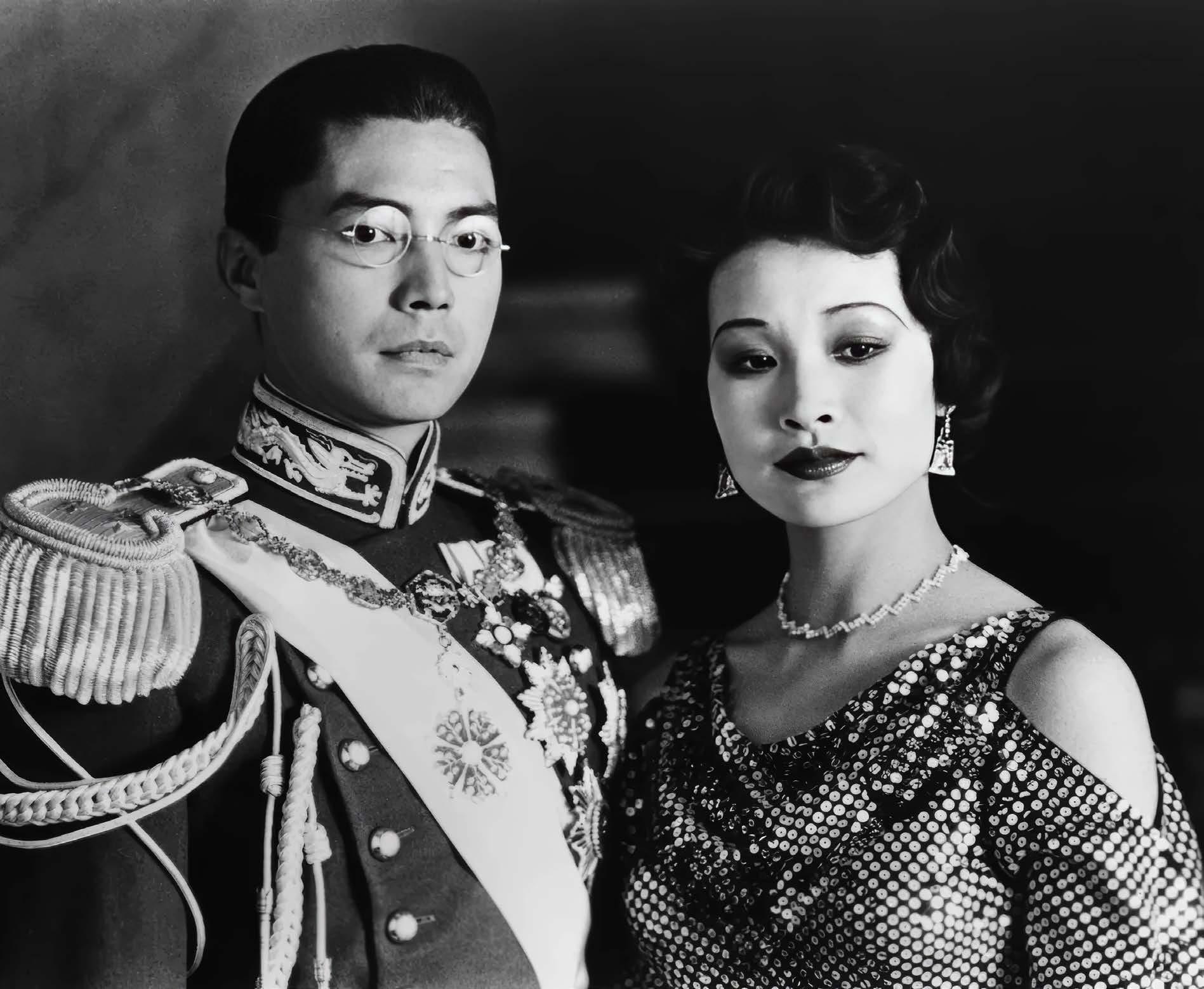

happen in the next episode, never mind what the actual ending might be.
The first series of the cult drama series made log fires and cherry pie a way of life, and left 35 million Americans asking one burning question: “Who killed Laura Palmer?”
Week after week, lured in by Angelo Badalamenti’s haunting theme song, viewers were kept in glorious suspense as Lynch masterfully twisted and turned his dark storyline to the point where Chen’s character eventually turned into a doorknob.
Now on a roll, during the 1990s, Chen flip-flopped back and forth between the worlds of East and West with
significant roles in Clara Law’s ‘Temptation of a Monk’ (1993) in Hong Kong, Oliver Stone’s ‘Heaven & Earth’ (1994), Steven Seagal’s ‘On Deadly Ground’ (1994) and Stanley Kwan’s ‘Red Rose White Rose’ (1994), which earned Chen a Golden Horse Award for Best Actress.
In 1998, Chen made her directing debut with‘Xiu Xiu: The Sent Down Girl’, a Chinese film that explored the stories of youth during the Cultural Revolution. The movie premiered to acclaim at the Berlin Film Festival before winning awards in numerous countries. But China did not welcome it and blacklisted Chen, slapping her with a fine and banning her from working in the country for three years.
This was followed by Chen being called in as a replacement to direct an American production, the MGM-backed romantic drama ‘Autumn in New York’ (2000) starring Hollywood A-listers Richard Gere and Winona Ryder. But the film received harsh criticism and box office figures were low, leaving Chen so disillusioned that she turned down subsequent directing offers.
As the years progressed, Chen continued to work in both American and Chinese cinema, balancing her roles as a mother and a creative force. Projects such as Alice Woo’s ‘Saving Face’ (2004) underscored her interest in diverse
storytelling, particularly in the Asian-American realm. “The most important thing for me is a great script,” she notes, highlighting her attraction to quality narratives.
Chen draws parallels between ‘Saving Face’ and her most recent turn in ‘Didi’, in that the two films are semiautobiographical stories, and in both, she plays the matriarch.
Chen’s portrayal of Chungsing in ‘Didi’ shows her deftly navigating the combined landscape of motherhood, cultural expectation and personal sacrifice.
From the outset, Chen and Director Sean Wang had a clear vision for Chungsing: to create a character that was above all,
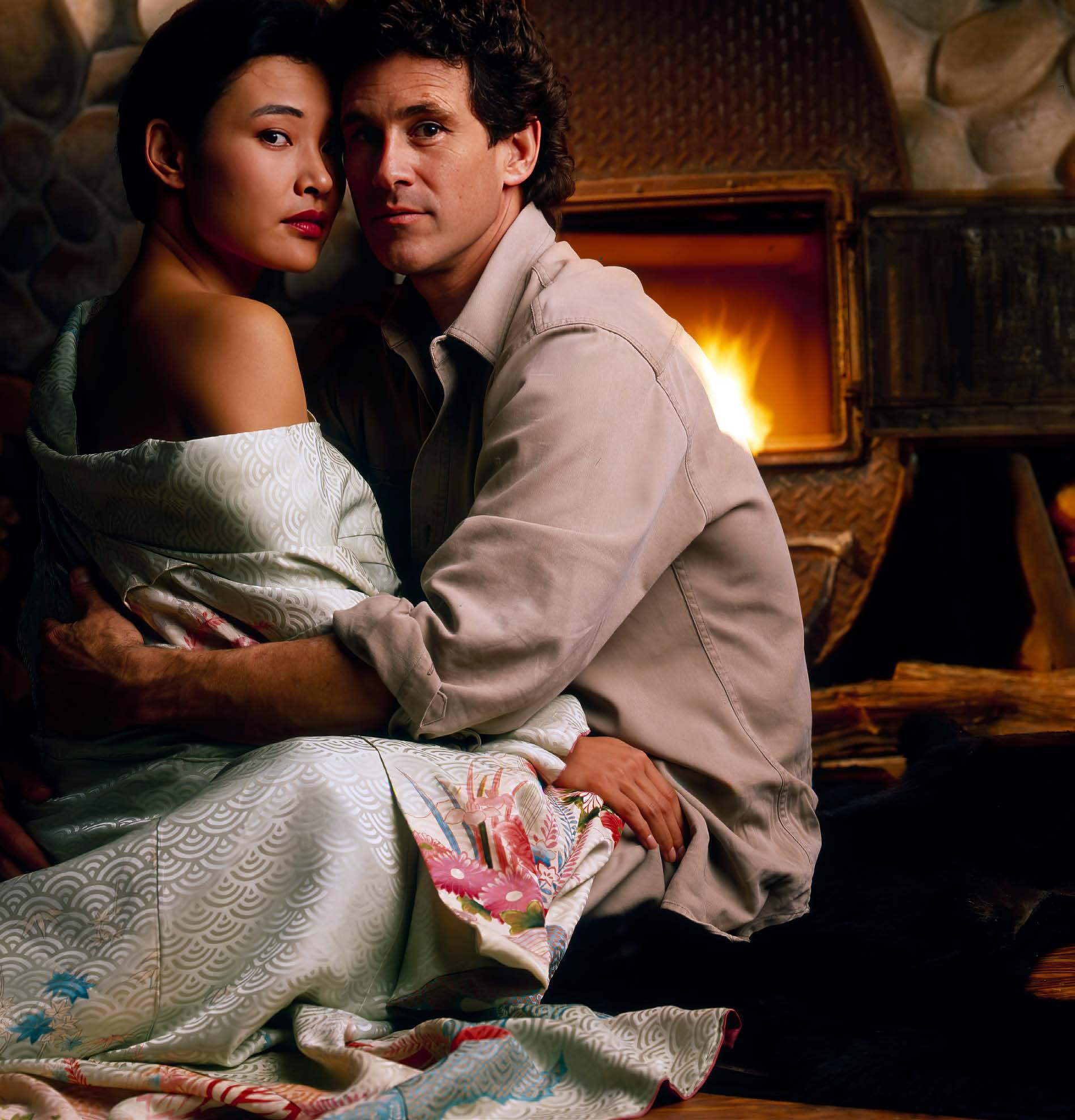
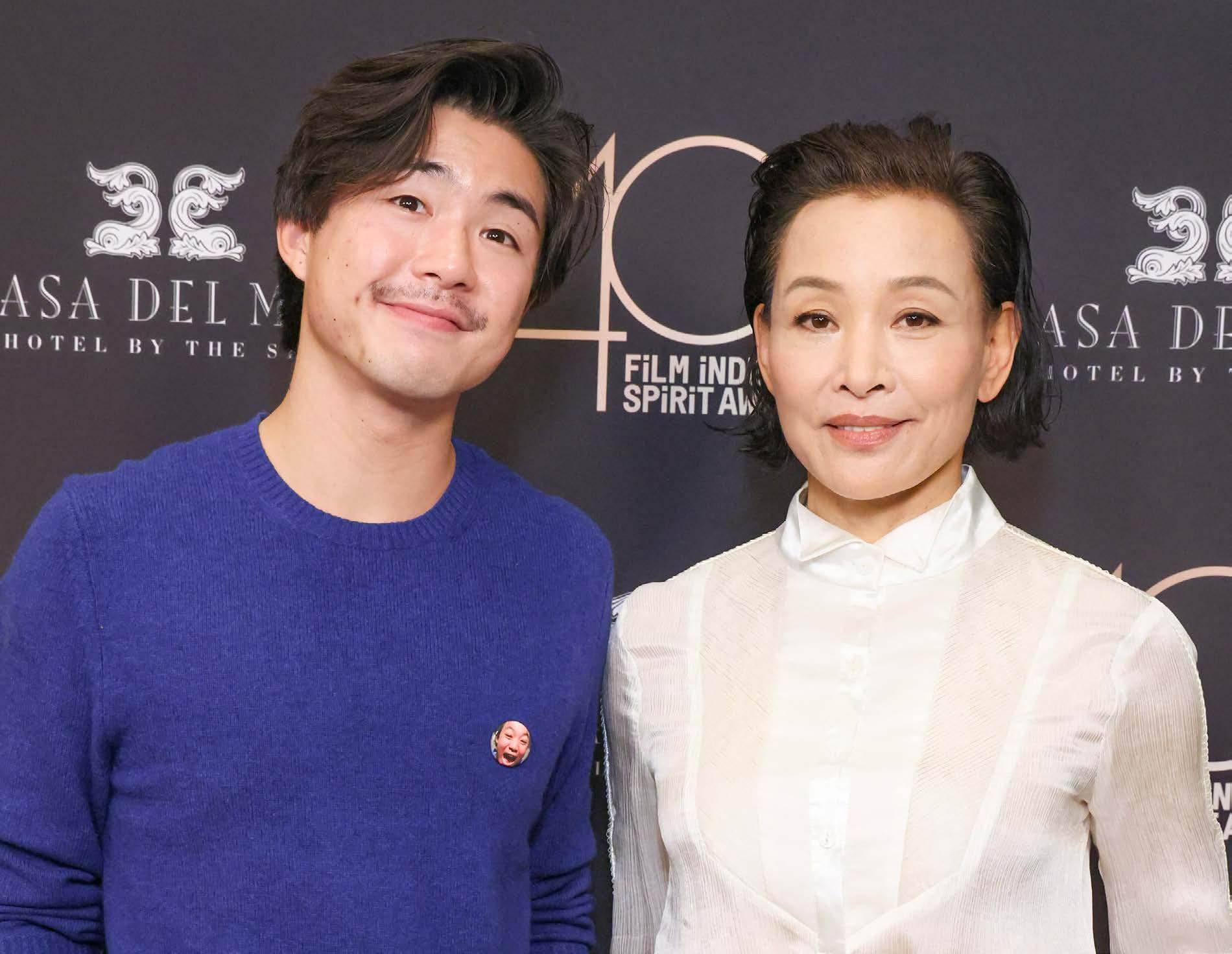
authentic. To achieve this, Chen communicated extensively with Wang’s own mother, often recording her voice to be able to incorporate her gentler mannerisms into the portrayal. “I wanted to make sure that when Chungsing got really angry, it still had a certain softness to it,” Chen explains.
This attention to detail illustrates the actress’s recognition that, as a supporting character with limited screen time, every moment must count. “I fully realise that you cannot waste one second,” she states, highlighting her understanding of the weight her character carries in the narrative.
Chungsing is defined by her quiet resilience, and she is often seen performing mundane household tasks while absorbing the emotional turmoil around her. “Most of the time she’s just getting on with her chores and silently taking it all in,” Chen notes, reflecting on how her character endures ongoing emotional abuse from her mother-in-law. The subtlety of her performance is evidenced through fleeting looks and gestures that convey a depth of feeling that negate the need for overt expressions of anger or frustration.
Chen’s ability to channel her own experiences into Chungsing’s character transforms the film into a shared space for dialogue. “So many young people said, ‘I called my mom right away after I left the theatre,’” she recounts,
underscoring the film’s ability to successfully capture the often delicate intricacies of familial bonds.
Somewhat ironically, Chen’s next role is in Andrew Ahn’s remake of Ang Lee’s ‘The Wedding Banquet’ (1993) which will premiere at the 2025 Sundance Film Festival. During her early days in New York, she had met Lee and been in preliminary talks with him about starring in the original film, but as the production ended up being financed by Taiwan’s Central Motion Picture Corporation, it became a requirement that the role had to be played by a Taiwanese actress.
“I was really happy when I was cast in the remake, not playing the girl of course, but her mother, who is a very funny character,” says Chen. “So now in my later career I have discovered comedy, which I think is kind of fitting because as you get older you do see more humour and absurdity in life.”
Referring to directors Wang and Ahn, both still in their thirties, Chen summed up in a Vanity Fair interview what could quite feasibly be applied to how the Western film industry has evolved its perception of Asian actors and the roles they have finally been given. “These directors are able to express more honestly, truthfully, and authentically their own experiences - not selling what Hollywood’s so-called accepted version of being what Asians should be.” n
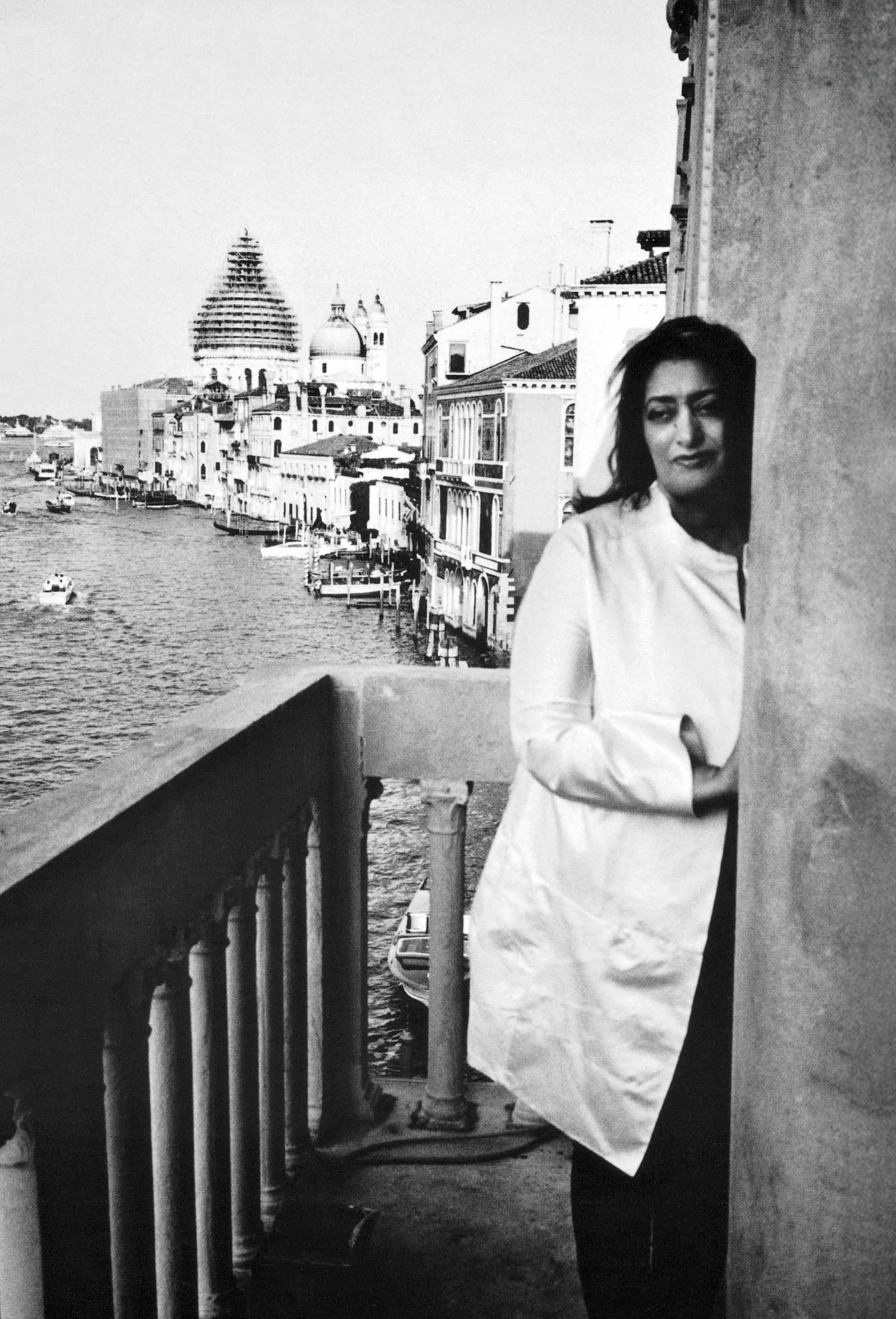
With the imminent completion of an iconic new landmark in Central, The Correspondent casts a backward glance at the life and times of the late Zaha Hadid and pays tribute to one of the great visionary architects of our time.
By Sheena Liang
Laying eyes on Hong Kong for the first time in 1981, the late Zaha Hadid went on to win a competition in 1983 for a proposed luxury recreational and residential development which was to be known as The Peak Leisure Club, located in the hills of Kowloon. Hadid’s submission, despite never coming to fruition, was her first project to garner widespread recognition, and laid the foundations for the work that would manifest throughout her career.
Hadid’s radical proposal for ‘The Peak’ involved levelling part of the site and using the extracted stone to clad a new “man-made polished granite mountain”, as she called it. The complex, shattered forms of the proposed building would become associated with the Deconstructivist architectural movement of the late 1980s.
Unfortunately, the project met the same fate as much of Hadid’s work in her earlier years.
After almost 20 years spent wandering in the architectural wilderness with her designs being dismissed as incredible, but impractical, and in the face of her detractors, it was her uncompromising attitude, the toughness of her personality, and her steely determination that carried her through, ensuring that her radicalism remained undiluted, making her the architect she became.
Although it may have taken many years, eventually, Hadid came to reap the rewards for pushing boundaries and remaining true to her own far-reaching vision.
Becoming known as the “diva of architecture”, she was larger than life, with an even larger intellect and an imposing personality. Tales abounded about her temperament, with a London broadsheet once describing her as “notoriously short
fused”, with “volcanic”, “abrasive” and “compromising” as oft-used qualifiers. But when she took to the stage, she came across like an exotic bird of paradise with her striking face framed by long hair streaked with auburn, a distinctive accent and a look often punctuated by vibrantly coloured garments. But Hadid’s character was understandable, if not admirable.
Architecture might be one of the oldest professions in the world, but it still remains as one of the most masculine. The number of women who have succeeded have been few and far between, and Zaha Hadid became the first female architect of international standing.
The Iraqi-born, British architect was born in a prosperous suburb of Baghdad in 1950. Educated by French nuns, she arrived at the Architectural Association in Bedford Square in London in her twenties. And it was there, immersed in England’s unique architectural culture during the 1970s, studying at a school renowned for debate and defiance (King Charles once dubbed it the “Frankenstein Academy”), that Hadid’s persona and talent were formed. Under the auspices of her mentor, Rem Koolhas, also an AA alum, Hadid’s architectural language began to take shape, which led Koolhas to dub his prodigy “a planet in her own inimitable orbit”.
It’s interesting to track the next stretch of Hadid’s career, which saw her hit the pits, soldier on, and eventually become the first woman to win the Pritzker Prize. Having graduated in 1977, Hadid collected critical acclaim, not contracts. The next decade or so was filled with soul-destroying frustrations for the architect, who had yet to see one of her designs materialise,
Hadid’s radical proposal for ‘The Peak’ involved levelling part of the site and using the extracted stone to clad a new “man-made polished granite mountain”, as she called it. The complex, shattered forms of the proposed building would become associated with the Deconstructivist architectural movement of the late 1980s.
save for the Vitra Fire Station in Weil-am-Rhein, Germany.
1994 marked a career milestone for Hadid. She had entered a competition to create a new opera house in Cardiff Bay. Her entry was theatrical, resembled a giant glass necklace, and resulted in her beating out 250 other architects to a triumphant win (Lord Norman Foster came second). Unfortunately, the reaction, in Wales at least, was scathing. The press crucified the design and its maker, deeming it elitist, impractical, and “an eyesore”. One harsh critic even called it a “deconstructed pigsty”. Rubbing salt into the wound was the Millennium Commission, the money behind the project, which deemed it “insufficiently distinctive”.
It was a crushing blow and a spectacular fall from grace. Hadid would later admit that the stigma was so great she could barely find work. But perhaps luckily for the architectural world, whence Britain rejected her, America would come to embrace her. With a sympathetic patron drawn to her exhilarating, avant-garde designs, Hadid finally got the breakthrough she deserved.
Thus, Cincinnati got a great building in the form of the Rosenthal Center for Contemporary Art in 2003. A stunning work of architecture with seven floors and three mezzanines of galleries, it demonstrated a dynamic use of space featuring eye-catching jigsaw puzzle detail. The New York Times called it “the most important American building to be completed since the Cold War”.
The winds shifted and Hadid’s time finally came; the world simply just couldn’t get enough of her.
In 2004, she won the Pritzker Prize, the highest honour that can be bestowed on an architect, with an astonishingly small oeuvre of built work, which to her admirers merely serves as a testament to her bold and daring brand of modernism, her seemingly gravity-defying forms, and the conservatism of her potential clients. Despite what detractors may have said about Hadid’s personality, in the grander scheme of her genius, it all faded away to minutiae. Such was the sheer talent of this architect, a female from Iraq at that, it’s still hard not to be amazed.
Right up to the time of her sudden passing of a heart attack in Miami in 2016 at the age of 65, Hadid relentlessly jet-setted around the world, spreading her unique brand of creative quirkiness and continuing to push boundaries in her own way. Witness how much the Austrians loved their Hadid-designed ski jump, so much so that Innsbruck added a Hadid funicular station. The end of 2008 saw the completion of Italy’s MAXXI - National Museum of the 21st Century Arts, which at the time was like nothing Rome had ever seen. That project earned Hadid the coveted Stirling Prize in 2010.
Subsequent notable Hadid projects included the Guangzhou Opera House, the London Aquatics Centre for the 2012 Olympics, the Evelyn Grace Academy in London (for which she earned another Stirling Prize in 2011), and the Dongdaemun Design Plaza in Seoul. The list goes on and on.
In 2012, Hadid was awarded the title of Dame Commander of the Order of the British Empire by Queen Elizabeth II. She also received France’s Commandeur de l’Ordre des Arts et des Lettres and Japan’s Praemium Imperiale.
In March 2016 at Baselworld, just days prior to Hadid’s untimely death, Georg Jensen unveiled a striking jewellery collection in collaboration with the architect, which was presented within a spectacular installation. “This installation is referenced by the coherence and beauty of natural systems and informed by the fluidity of my own architectural language,” said Hadid, who had just won the Royal Gold Medal for Architecture.
But to bring things back to home, Hong Kong got its first tangible piece of Hadid in the form of The Hong Kong Polytechnic’s Jockey Club Innovation Tower, which was completed in 2014. Iconic, fluid and aptly innovative with civic spaces aplenty, the building unabashedly aimed to stimulate and project a vision of possibilities for its future, as well as to reflect the history of the HK PolyU by encapsulating the process of change in its architecture.
Although she is no longer with us, Zaha Hadid’s legacy lives on through The Henderson, a 36-storey skyscraper at 2
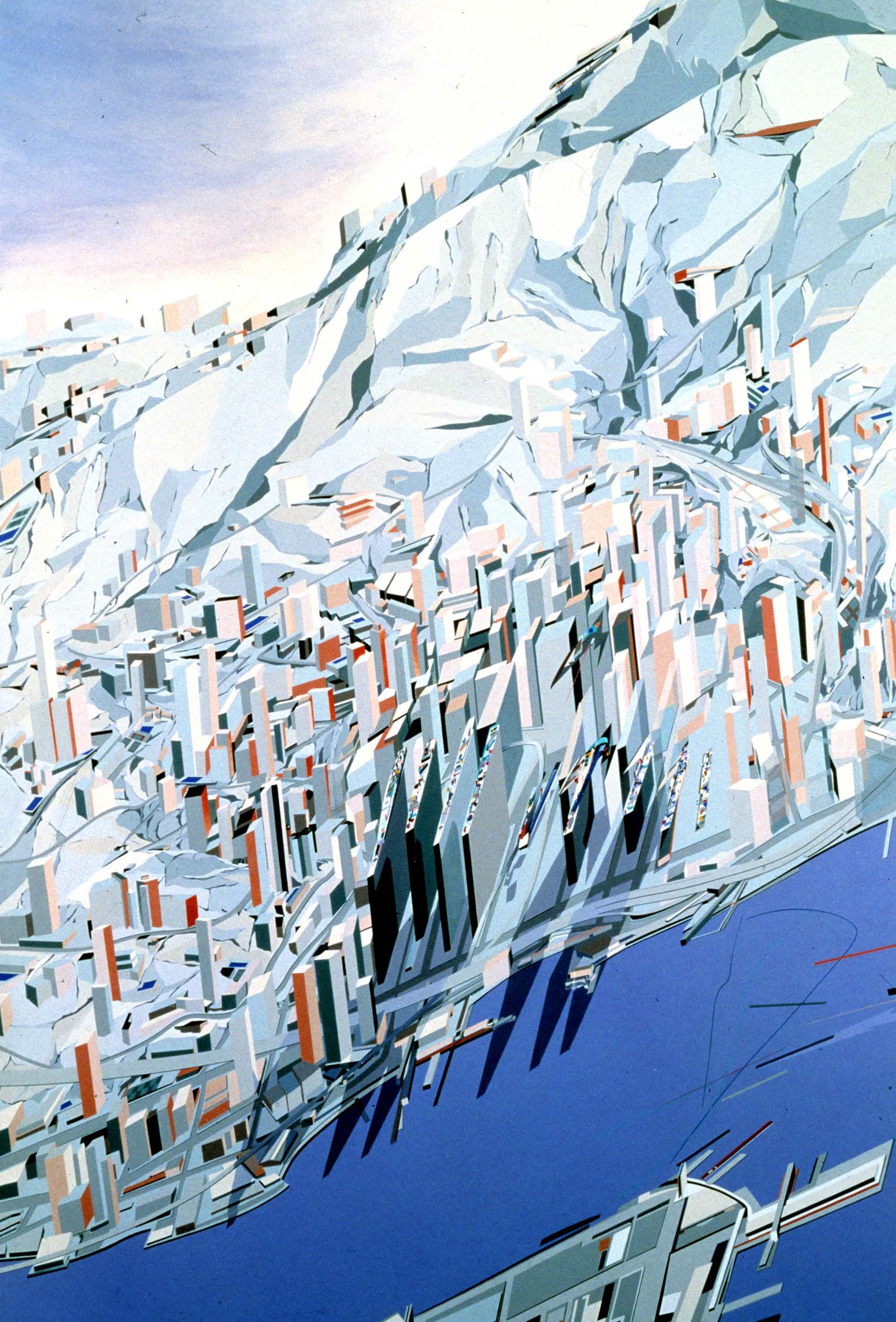

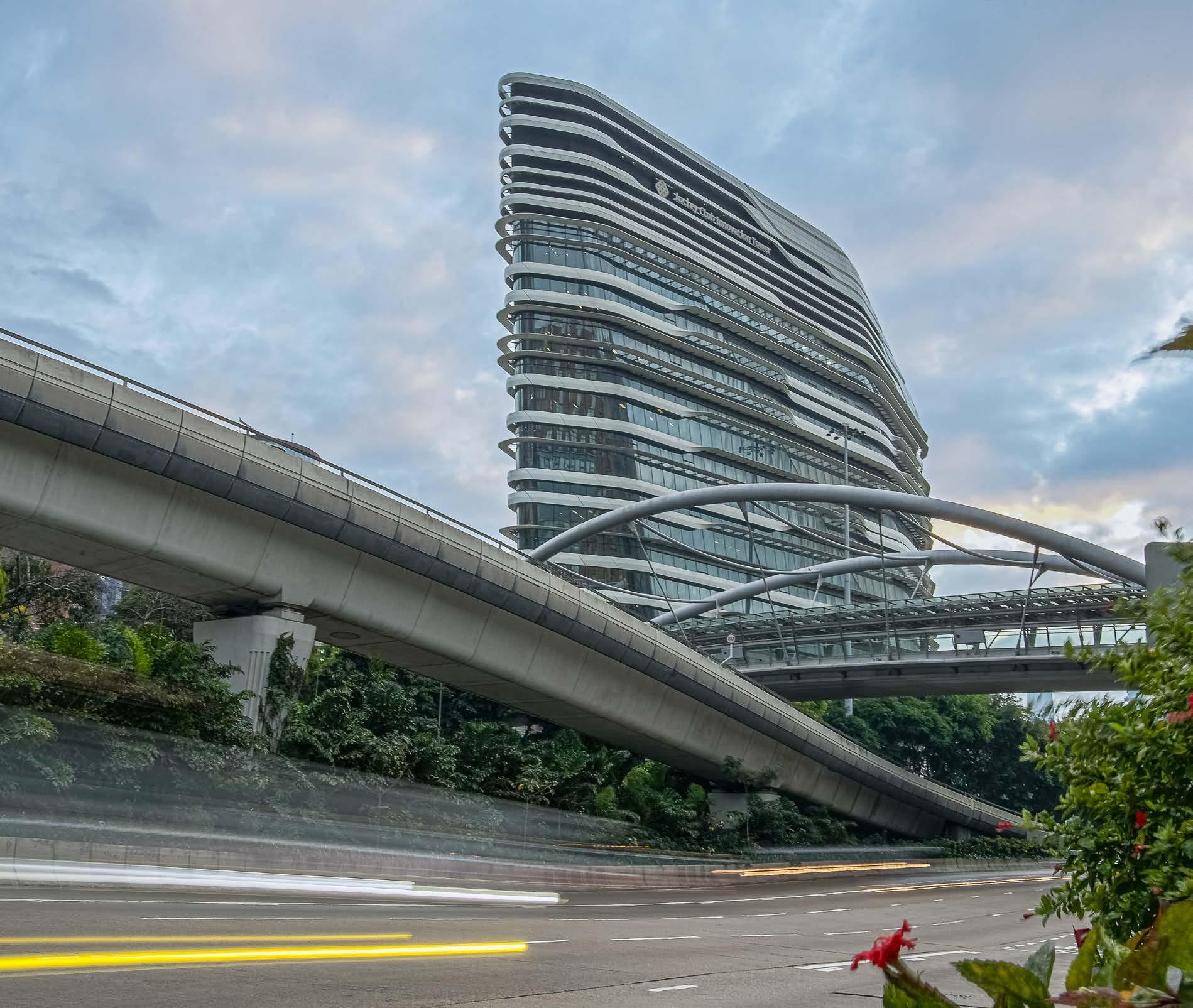
Murray Road, that is already being hailed as a new landmark for the city.
“With this site, we were very conscious that we had to create something extraordinary and unique, something 21st century and forward-looking,” said Zaha Hadid Architects principal Patrik Schumacher, who joined Hadid’s studio when she first launched it and was project architect on her first built project, the 1993 Vitra Fire Station. “We had the ambition to create a special piece of architecture that would be noticed and make waves around the world.”
The building’s organic form is informed by the buds of the Hong Kong Bauhinia, with its curves combining to create an undulating façade that represents overlapping flower petals. The structure is clad in more than 4,000 panels of double-laminated glass that between them form 1,000 different curvatures.
By mimicking organic forms and bringing nature into the building via two open-air balconies and an enclosed
sky garden, Zaha Hadid Architects says it wanted The Henderson to feel like an extension of the adjacent public park.
The Sky Garden will also accommodate a running track, while a banquet hall on the top floor offers views across the city and the harbour.
The Henderson is the first commercial project designed by Zaha Hadid Architects in Hong Kong and the curvilinear design of the building will be extended to the surrounding Lambeth Walk Rest Garden, creating the first sculpture park by Zaha Hadid Architects in Asia.
Hadid’s untimely passing in 2016 unquestionably left a void in the architectural world, but her legacy continues to inspire new generations of architects and designers. As her namesake company continues to pioneer new frontiers in design and urban development, Hadid’s work has taken its place in history, inspiring a more dynamic and inclusive architectural landscape in Hong Kong and beyond. n
In 2024, the television series based on the 1975 novel ‘Shōgun’ scooped up dozens of awards, with its first season winning 18 categories at the 76th Primetime Emmy Awards and the 76th Primetime Creative Arts Emmy Awards, setting a new record as the most awarded single season of television in Emmy history. The series also won an unprecedented four Golden Globe Awards, considering that the majority of the dialogue is in Japanese, including Best Television Series - Drama. It was back in 1990 when a tall stranger walked into the FCC one dark and rainy afternoon. Stephen Knipp was an observer sitting at the Main Bar, and much to his chagrin, narrowly missed the opportunity to meet his long-time literary hero.
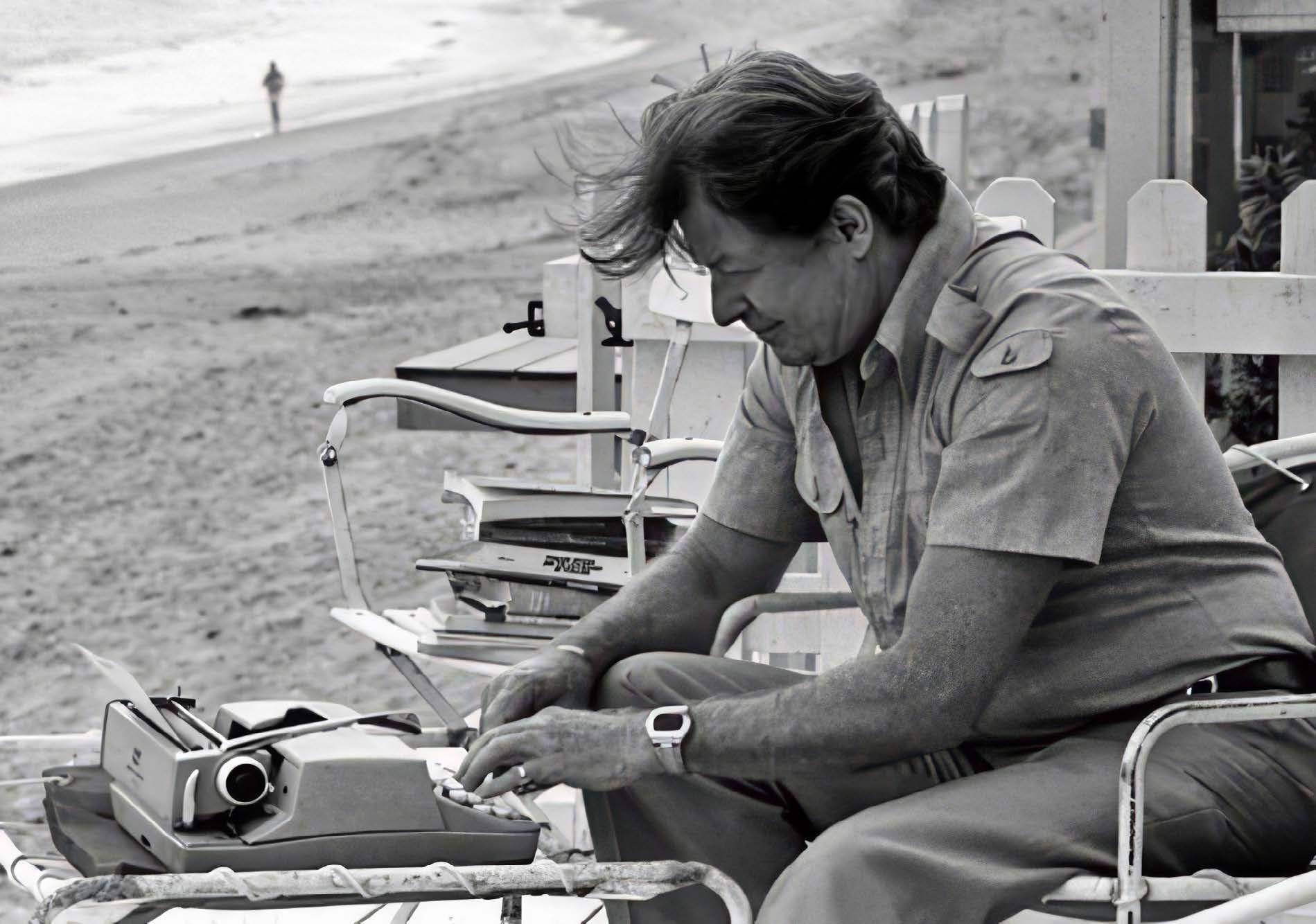
We were living in Causeway Bay at the time, my wife and I. It was a wet and steamy springtime Sunday, so we caught a cab to the Club for a long leisurely lunch.
The building was – and still is - a charming old colonial lady. It is undoubtedly one of the best-preserved buildings in the city. Everything you might expect and hope for in a truly great watering hole; a calm cool haven in a hot and hectic city. Those time-worn tiled floors, the potted palms. The lofty ceilings with whirling fans. Not to mention that cracking big bar. Though there was hardly anyone in the dining area, we still opted to sit at the bar to hear the soothing patter of the rain falling on the windows behind us.
A few minutes later, as we were sipping our beer —
awaiting my chicken curry, and her eggs Benedict — a tall man with impeccable posture came in out of the rain. He was distinguished, with almost a military bearing. But somewhat bedraggled from our legendary humidity.
Glancing around, the visitor seemed to like what he saw. He shook his expensive trench coat and ambled over toward the bar. He started talking to the lone barman workingDavid, a lean Hong Kong lad, famously efficient but frugal when it came to cheery barman banter.
We could hardly hear what was being said, yet it was clear that the visitor wanted to order a drink. David said something about needing to have a membership number to provide service. Alas, the visitor couldn’t remember his number. David declared that he would have to come back on Monday
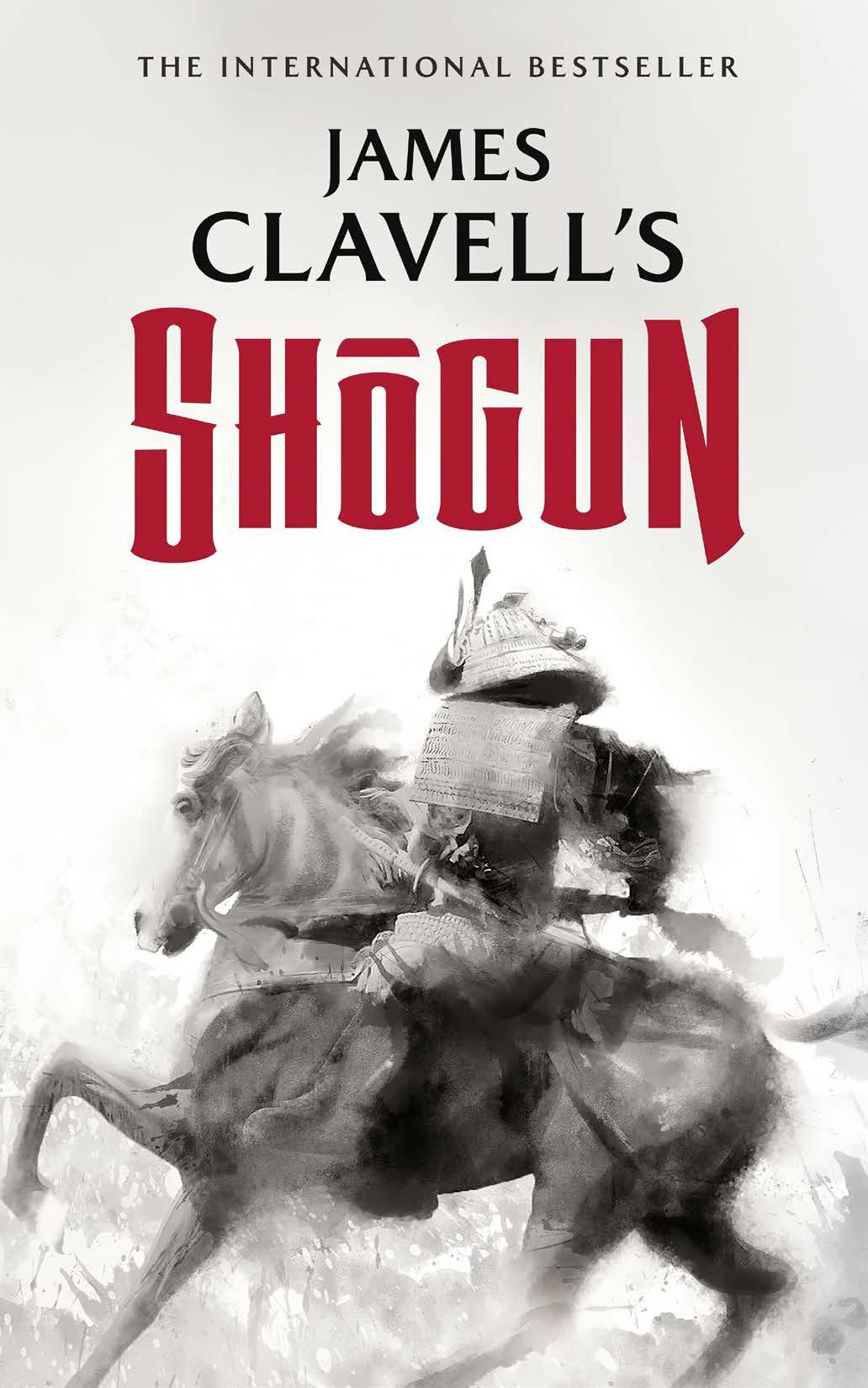
to check with the office. The man mumbled something. But he finally gave up and gloomily trooped towards the door and back out into the rain.
I looked at Irene. And said: “That gweilo looks familiar to me. But I can’t remember from where.”
Irene asked: “Was he someone you worked with?”
No…
“Was he someone you interviewed for a story?”
No…
“Someone you met on a plane?”
No…
My lovely wife, a savvy Hong Kong-born and bred lady, thought about it for several seconds.
Then her face lit up and she blurted: “Oh, yes! I know him now! He’s in that American Express TV commercial – the one that ends with ‘Don’t leave home without it!’”
Does anyone remember those stand-out commercials from the late 1980s, when a credit card was promoted as something prestigious? There was a series of them, each showing people whose names were famous but whose faces were not.
The buoyant, poised voice-overs of different people always made the same confident statement: “You don’t know
me. But, with my American Express card…”
It was at this point that the advert Irene had remembered flashed into my mind.
A large man standing on the rolling wooden deck of what looked to be a traditional Chinese sailing junk. His stylish trench coat flailing about in typhoon-like winds. Sheets of tropical rain slashing down all around him – except, strangely, not on his hair.
Then the voice-over: “You don’t know me, but…”
Suddenly, it hit me hard, like a bag of brass Chinese temple bells to the back of the head.
The handsome, but stern lion-like man standing at the opposite end of the bar, mere metres from me — desperate for a damn drink, was the legendary James Clavell. Epic, best-selling novelist, award-winning screenwriter, wounded Pacific War veteran, POW survivor, movie director!
And, long-time personal hero of mine.
James Clavell was born in Sydney. His father was a British Royal Navy commander, who had been sent Down Under in the early 1920s to help develop the Australian Navy. When young James was nine months old, his family was posted back to Blighty.
Twenty years later, Clavell found himself back in Asia,
this time as a young man in the British Army. In 1941 he was wounded while trying to escape capture in Malaya by the Japanese – taking a gunshot wound to the face.
He spent the next three years as a Prisoner of War, first in Java, then he was transferred to the notorious Changi prison camp in Singapore, where prisoners were only given a quarter pound of rice per day, one egg per week, plus a few vegetables. The intense heat, rampant disease [beriberi, malaria, dysentery], criminal-standard living conditions, and savage guards, led to the deaths of nearly a thousand POWs.
Despite standing at over six feet, when Clavell was finally liberated he weighed just 130 pounds.
Decades later, he told The New York Times that he was convinced if it had not been for the atom bombs dropped on Hiroshima and Nagasaki to end the war, he would have
died in Changi, executed by the guards along with the other survivors.
Out of his searing, life-changing war experience came Clavell’s first novel, King Rat. For 15 years after being freed from Changi, Clavell talked to no-one about his time there. But then he sat down and reportedly penned it all in just 90 days. The best-selling 1962 book became a Hollywood blockbuster starring George Seagal, James Fox and John Mills.
After King Rat, Clavell went on to write a string of bestsellers, few of them under 800 pages, including Tai-Pan (1966), Shogun (1975), Noble House (1981) and Gaijin (1993). All of them focused on Asia and they were all made into hugely popular Hollywood films or TV mini-series. In fact, I think his books subconsciously influenced me to move to Asia myself.
Clavell also enjoyed a successful dual career as an
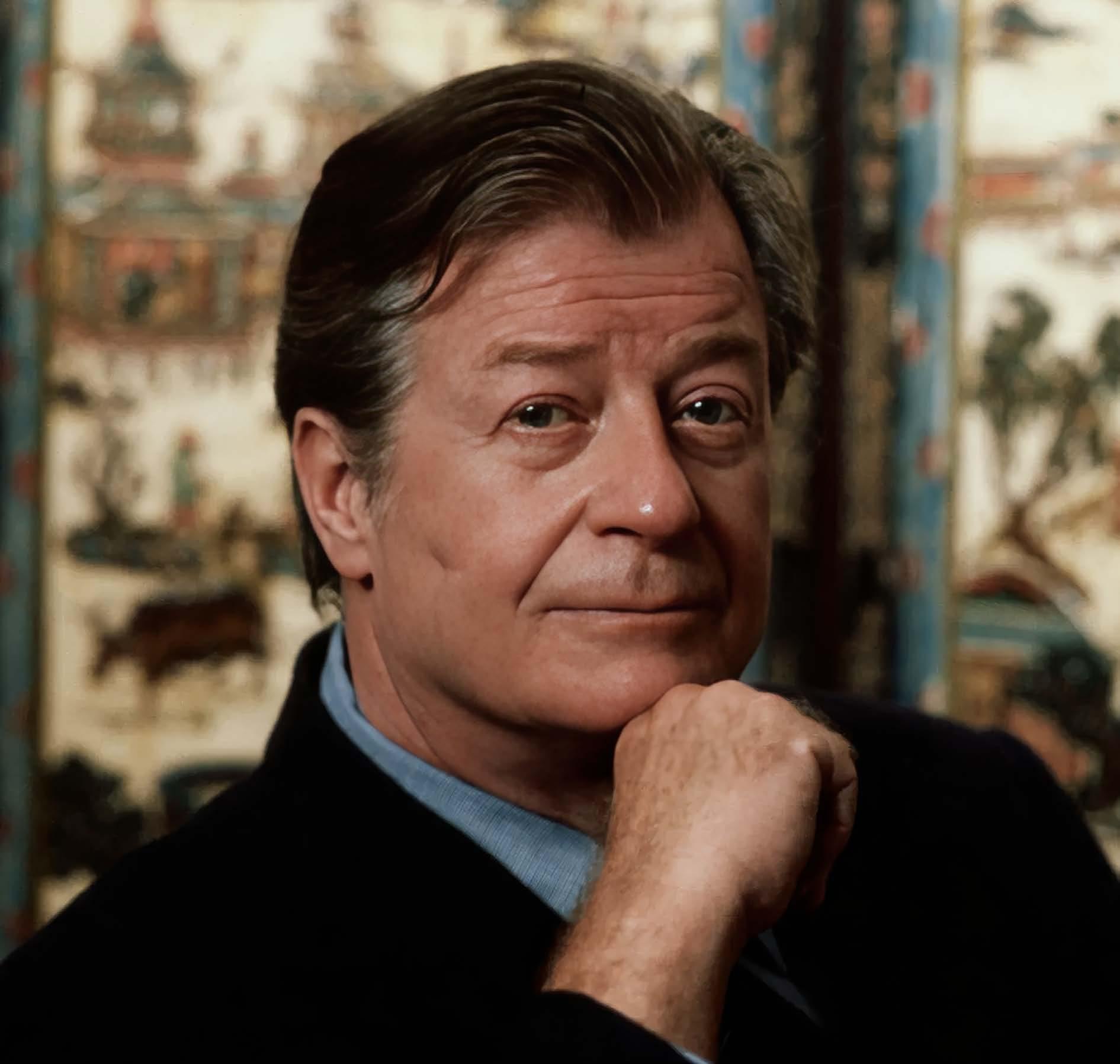
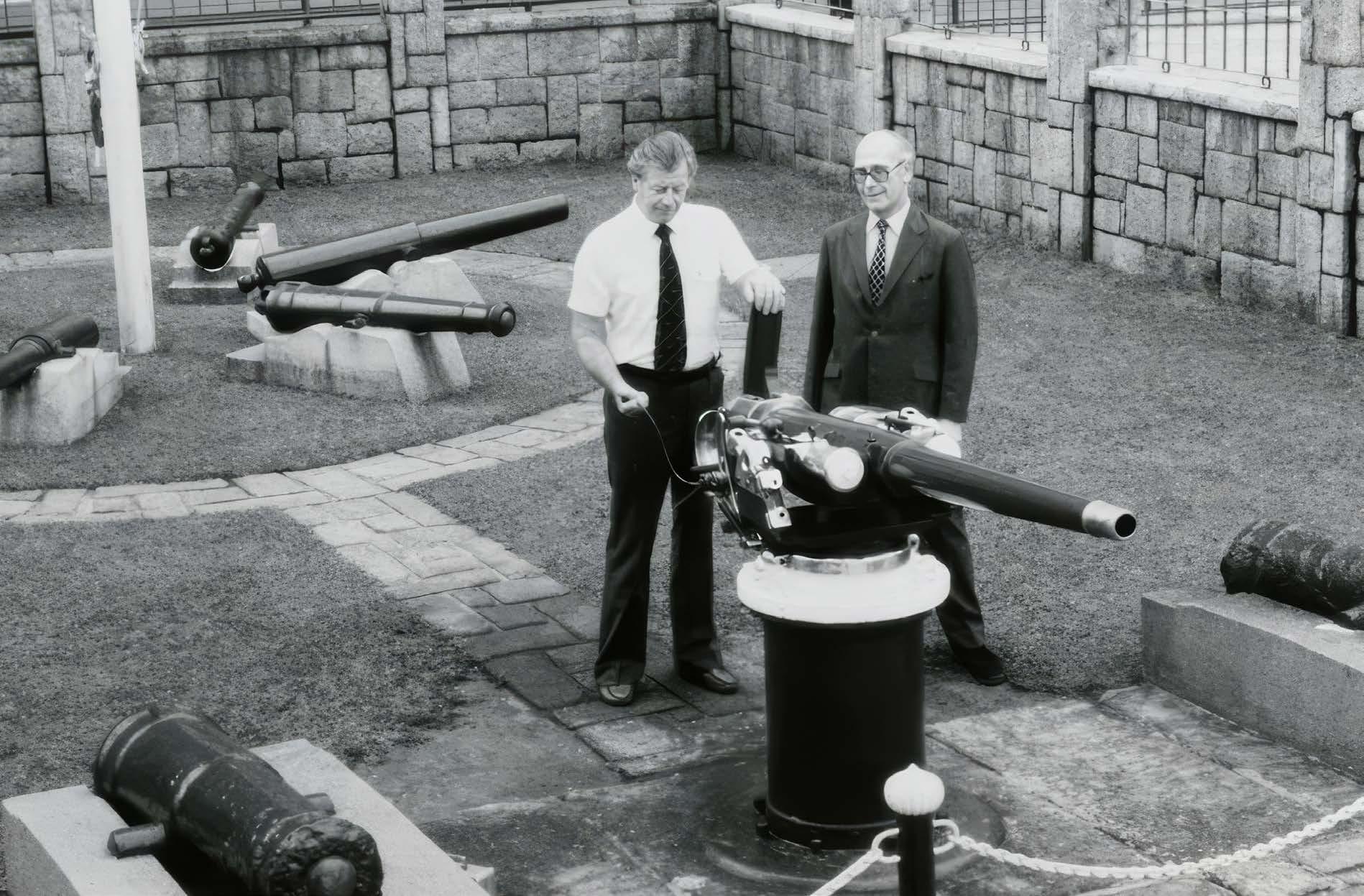
James Clavell fires the Noon Day Gun in Hong Kong extraordinarily successful screenwriter. By the early 1950s, he went to Hollywood, where he became a noted scriptwriter, penning The Fly in 1958, a science fiction horror cult film about a man who, yes, turns into a fly. It starred Vincent Price. He then wrote the celebrated war film, The Great Escape in 1963, which made Steve McQueen a superstar and co-starred Richard Attenborough, Donald Pleasence and David McCallum.
In that same year, Clavell moved to Hong Kong with his wife and two daughters, to do research for a book about the city’s ferociously competitive British trading firms. In 1964, the celebrated film about the RAF, 633 Squadron, starring Cliff Robertson was released, the original screenplay written by Clavell.
Then, in a tour de force, Clavell wrote, produced and directed To Sir With Love in 1967. It was a charming comingof-age film starring Sidney Poitier, and an 18-year-old Lulu, in her first film role. The perky Scottish pop singer also sang the picture’s famous theme song, which became a major hit on both sides of the Atlantic. Filmed in London’s gritty East End, the script was widely acclaimed for addressing such issues as racial prejudice, poverty and the value of education in escaping poverty.
Clavell described himself as a “half-Irish [his mother was Irish] Englishman with Scots overtones.” He was also a naturalised American citizen.
With all these facts bouncing around in my brain, I leaped off my bar stool and raced across the room towards the exit, nearly slipping on the wet tiled floor and crashing into the
Club’s uniformed doorman.
But by the time I got outside, the great man was already sitting in the back of a little red Toyota taxi hurtling down Ice House Street.
As I stood there, soaked in the pouring rain, I realised the scale of the lost opportunity I had just experienced. I had stupidly missed the chance to have bought James Clavell a beer. Or maybe a couple of gin & tonics. Or even a curry lunch.
Why, I asked myself, didn’t I have the presence of mind, or at least the kindness, to shout out: “Hey David, mo mun tai (‘no problem’). Put the man’s drink on my bill!”
How cool would that have been?
In the years since, I’ve convinced myself that we would have likely gotten along great; become chums even. I would have told him I’d read all his books and loved all his films. Yes, even The Fly. He might have asked what brought me to Hong Kong.
We might have chatted all afternoon about our mutual fascination with Asia - its history, its politics, its scoundrels, the rich culture, the fabulous food, the women. We’d have likely stayed in touch, updating what we were up to in long, fascinating emails. He might have asked for my thoughts on his upcoming projects. Or even asked me to tickle up a screenplay he was having trouble with. Eventually, we might have become known by our families as ‘Jimmy & Knippy’.
Alas, it was never to be. A few years later, in the autumn of 1994, I read Clavell had died in Switzerland.
Good joss, Taipan! [Best of luck, boss!] n
Crowded streets and shopping, The Peak, and the Star Ferry crisscrossing Victoria Harbour surrounded by the city’s high-rises: all are synonymous with Hong Kong. Closer to home, TVB’s Freddy the weatherman, the smell of roasted chestnuts or sweet potato in winter, and the distinctive warning sound of Hong Kong’s pedestrian crossings, are always associated with the city by Hong Kongers and frequent visitors. Icons can be universal, or – let’s not be too exceptional or snobby – personal: your mother’s homemade soup is certainly iconic. By John Batten
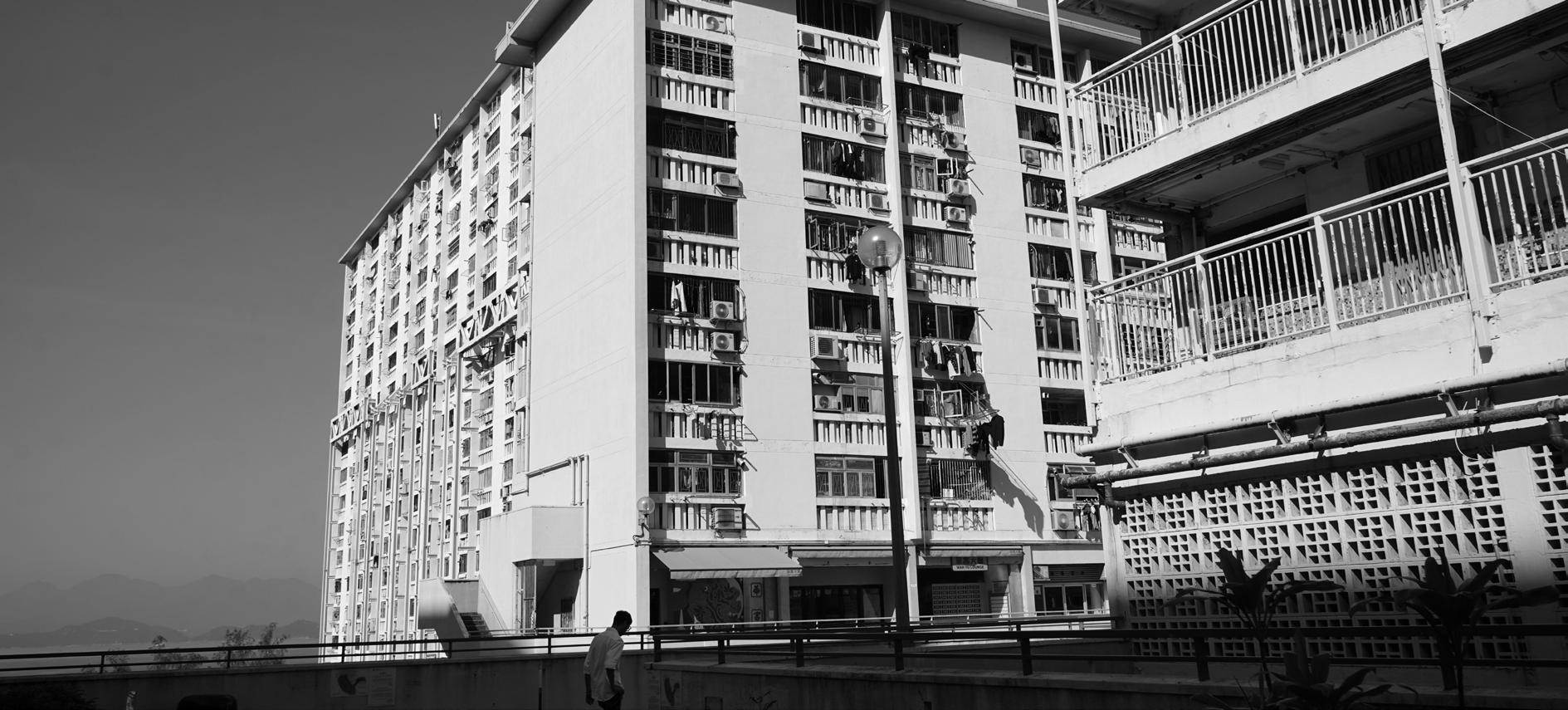
For a small place, Hong Kong is highly localised with neighbourhoods having distinct personalities. Sea and island life in Cheung Chau is different from growing up amongst the industrial and residential estates of Tsuen Wan, Kwun Tong or Kwai Chung. Districts have an unconscious territorial claim on its residents and although the city’s cultural identity appears homogenous, it is greatly nuanced at ground level. Hong Kong’s famous milk tea, strained and mixed with condensed milk, can be found throughout the city, but drinking it in a favourite neighbourhood cha chan teng (a Hong Kong-style café) makes it special. When told that, “That café has famous milk tea,” local pride is bestowing a ‘higher-level’ of status on Hong Kong’s universal milk tea! Although I live in Sheung Wan, one of Hong Kong’s oldest and historic areas, I am also a big fan of Wah Fu Estate and its surroundings. Located between Pokfulam and Aberdeen on Hong Kong Island’s Southside, Wah Fu is representative of Hong Kong urban life and a microcosm of the city’s vernacular culture. It is an excellent area to walk around and appreciate some of the city’s alternative icons.
Inaugurated in 1968 and fully developed by 1971, the estate - with its contemporary equivalent, Kowloon’s Choi Hung Estate – are both exemplary examples of modernist architectural design and both are sadly to be demolished in the next 10 years. Backed by the visionary Michael Wright, Hong Kong’s Director of Public Works in the 1960s, the
design of Wah Fu was headed by Donald Liao, the Housing Authority’s then Chief Architect. Liao was a former student and employee of Gordon Brown, who opened The University of Hong Kong’s Department of Architecture in 1950 and who designed the modernist Wah Yan College in Wan Chai in 1953. The school’s steep site has similar design solutions as Wah Fu.
Situated on a hillside overlooking the East Lamma Channel, Wah Fu Estate rises in blocks along engineered terraces, positioned to best capture the site’s natural elements. Each residential unit opens onto a long connecting corridor with windows at the front and rear of the unit, giving good cross-air ventilation with many having sea views.
When planned, Wah Fu was designed as a self-contained community. Unfortunately, this was also through necessity: Wah Fu’s transport links were originally poor. Before the South Island MTR line opened, its approximately 50,000 residents relied on buses that were frequently caught in traffic congestion. If a traffic jam could be iconic, then the daily congested Aberdeen Tunnel would be a contender.
Wah Fu has a central shopping centre and open-air podium that includes a wet market, restaurants, bakeries, schools, a public library, a post office, hardware and clothing shops, hairdressers, social service organisations and doctors’ clinics. It is all old-style. The Housing Authority retains management of the site and many businesses have been there
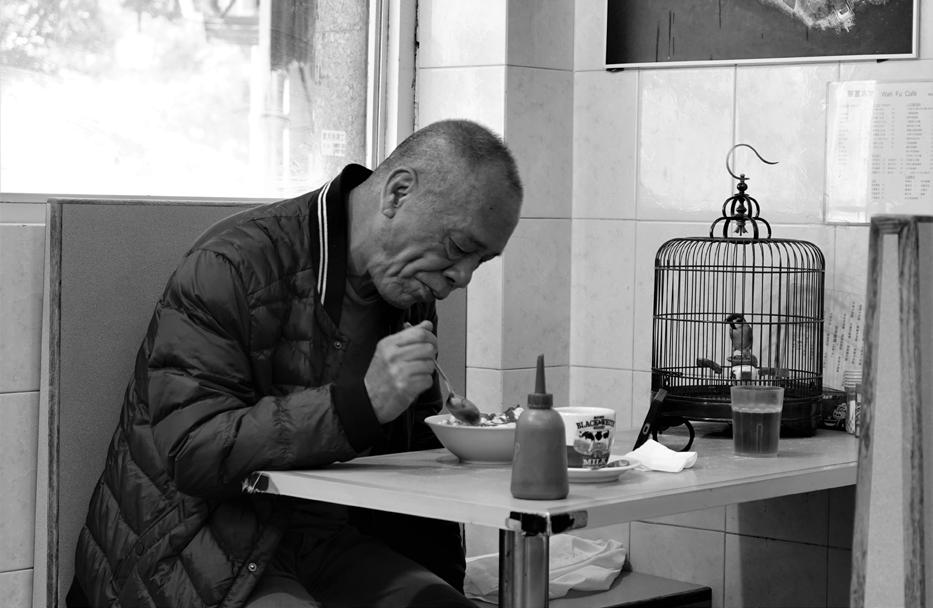
for decades. Walking around the estate is easy; it is open to the general public and its many open spaces are landscaped with trees, seating and exercise areas.
Wah Fu Estate’s basement wet market has the bustle of any of the city’s markets: the vendors yelling bargains to entice customers at the end of the day and each market stall is an example of Hong Kong’s iconic market style: hand-written signage, red plastic overhead light-shades, products separated with exact cardboard or stacked foam-board box organisation, random chairs for those that need one, and always a smokers’ corner. On the estate’s ground floor podium are two classic cha chan tengs - Silver Café and the Wah Fu Café. The latter has a resident black cat – very friendly, except at around 3pm when schoolchildren pass and she hides under the exterior cake counter, avoiding overly vigorous children’s hands. Other cafés, shops and facilities are also located in the estate’s higher hillside blocks and podiums.
Walking around Wah Fu gives an overview of the generous space, excellent architecture and thoughtfulness of the city’s first-generation public housing. After its demolition, the estate will be sold to developers to monetarize this overly generous space and build private housing with sea views, similar to nearby Cyberport. High-rise public housing will then be built along Pokfulam Road. The eventual extension of the South Island MTR line might be cost-effective with Wah Fu’s consequent higher density population.
Early Western mariners visiting the South China coast knew of the fresh water that could be easily collected at Waterfall Bay, located directly below Wah Fu. But, if you walk down the hill in the other direction towards Wah Kwai Estate, through the hillside park (note the morning or afternoon tai chi practitioners) or take the long bridge and elevator linking Wah Fu to Wah Kwai, you will discover a wonderland of ceramic household gods - all types of Guanyin, Buddhas, the Monkey King and the like, mixed in with Mickey Mouse, Hello Kitty and other toys. The local uncles have constructed terraces and gardens to house thousands of abandoned deities – delivered by residents moving house or carefully put aside by the local cleaners. Despite some social media attention, it remains a poignant, quiet and unexpected oasis. During the summer, hardy local residents swim and sit in the beautifully makeshift shelters built overlooking the sea.
Similar repositories for deities can be seen throughout Hong Kong, often found beside hand-built altars and community gardens behind housing estates in greenbelt areas. In Development Bureau/Hong Kong governmentspeak, such informal structures built on government land without permission are “tolerated” – until they are not, and
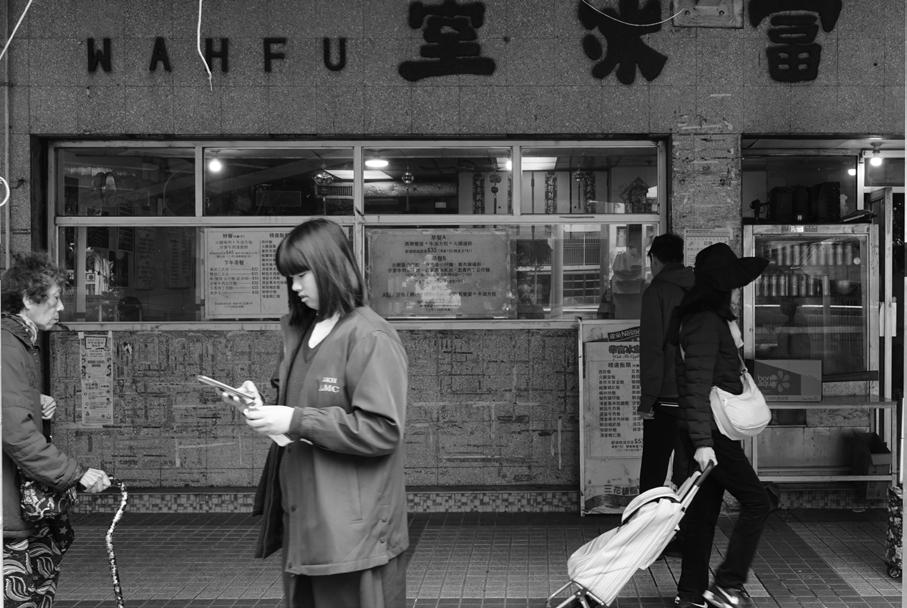
then a non-occupation or demolition order will be issued. In the meantime, Wah Fu’s thousands of ‘illegal’ hillside gods have some protection from the small, but approved Tin Hau temple constructed on the seafront in front of the hillside. The celestial force of Tin Hau and these extra gods gives Aberdeen Harbour’s resident fishing boats and passing ships, including huge container ships, great protection!
Not far away, back up the hill, is Béthanie, the historic former 19th century French missionary retreat and religious printing press premises. Now a campus for the Hong Kong Academy for Performing Arts, Béthanie has remnants of the area’s former Dairy Farm, including milking sheds now converted as theatres. Across the road is Pokfulam Village, downstream from The Peak’s water catchment area and Pokfulam Reservoir and its country park. The village is one of Hong Kong Island’s few remaining semi-rural villages and has its own fire dragon celebrations during the MidAutumn Festival, rivalling the more famous Tai Hang Fire Dragon Festival. Pokfulam Village celebrated the 100th anniversary of its fire dragon 10 years ago. The special 100 metre-long dragon made from straw tightly held by wire required everybody, including casual viewers who came to see the performance, to help with the smoky task of placing thousands of long incense sticks into the dragon’s body.
Wah Fu Estate’s main bus depot is also a 1960s classic. There are rows of open-air shelters, with buses to all parts of Hong Kong and a circular shuttle bus (#48) to the MTR’s South Island Line. Bus #41A is a former commuter route linking Wah Fu to the North Point Ferry. It is also one of the city’s unheralded and great bus trips. A journey upfront top deck takes you through Aberdeen, Wong Chuk Hang, past Ocean Park and its iconic pandas, then over the hill with great views overlooking Deepwater Bay. The bus follows the hilly contours overlooking Happy Valley and past the remnants of the old Tiger Balm Gardens and Lai Tak Tsuen with its distinctive circular public housing design. Arriving in North Point, the bus passes near the under-renovation historic State Theatre and the Sunbeam Theatre, an iconic Cantonese opera venue, which will close and be converted into a church’s premises after May 2025. The bus trip terminates at the North Point Ferry Pier.
Ferries to Kowloon City Pier, which is actually located in To Kwa Wan, depart every half-hour. It is then a short walk to the Cattle Depot Artist Village, housed in a former abattoir of beautiful Chinese-style colonial vernacular architecture. The ferry trip is also a relaxed way to get to the new Kai Tak Sports Park and its large stadium; Hong Kong’s latest, newest, biggest must-be icon. n
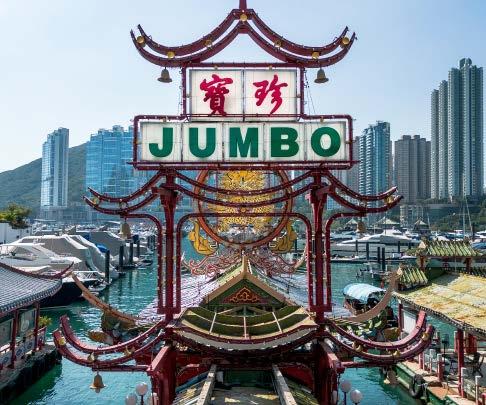
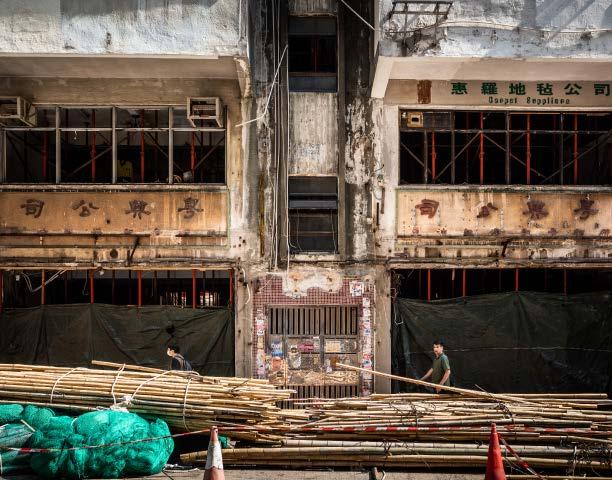
The story of Hong Kong is told through a visual cacophony of unique signage - hand-written calligraphy, vibrant colours, and creative characters.
While many fixate on Hong Kong’s well-known, at-risk neon signs, few recognise the abundance of ghost signs –defunct signage from times past that remain a tangible trace of the communities that have changed or disappeared amidst the city’s rapid (re)development.
These signs have been left behind by businesses, public institutions, and communities that have moved along or disappeared altogether. They can be hand-painted, terrazzo, acrylic, wood, metal, or other materials, still in their original location, yet sometimes obscured by new signs, air conditioning units, and even laundry being hung out to dry.
Chronicling the people, places and cultures that came before, ‘Hong Kong Ghost Signs’ is the first to apply an extensive urban archaeological lens to Hong Kong in both

the English and Chinese speaking worlds, leading to a greater understanding of our ever-changing city where calligraphers, sign installers, and the communities they served have left unique marks of a disappearing way of life.
With photographs by Ben Marans and historical, as well as contemporary research by Billy Potts, hundreds of ghost signs from across the city and the Greater Bay Area have been documented to date. Coming soon will be an interactive web app, walking tours, and a book, all aimed at sharing these treasures.
The duo’s goal locally is to educate, to inspire, and to engage a community of ghost sign hunters to hit the streets, explore their neighbourhoods, and help capture and celebrate the stories of this place we call home.
Read more about the work at www.instagram.com/ hkghostsigns
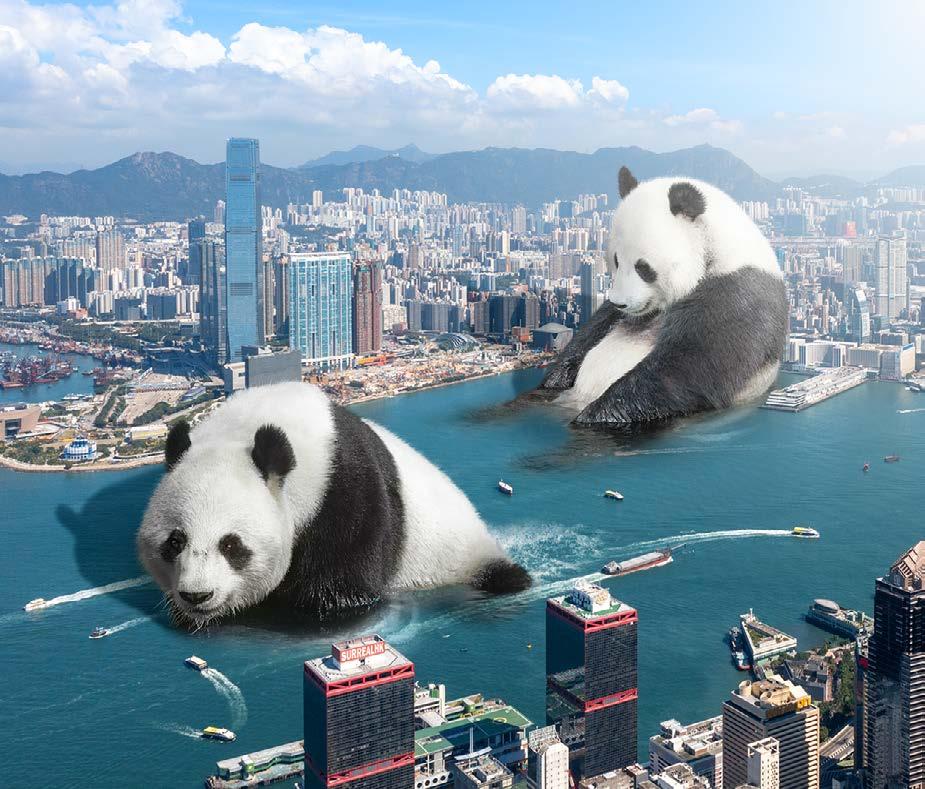
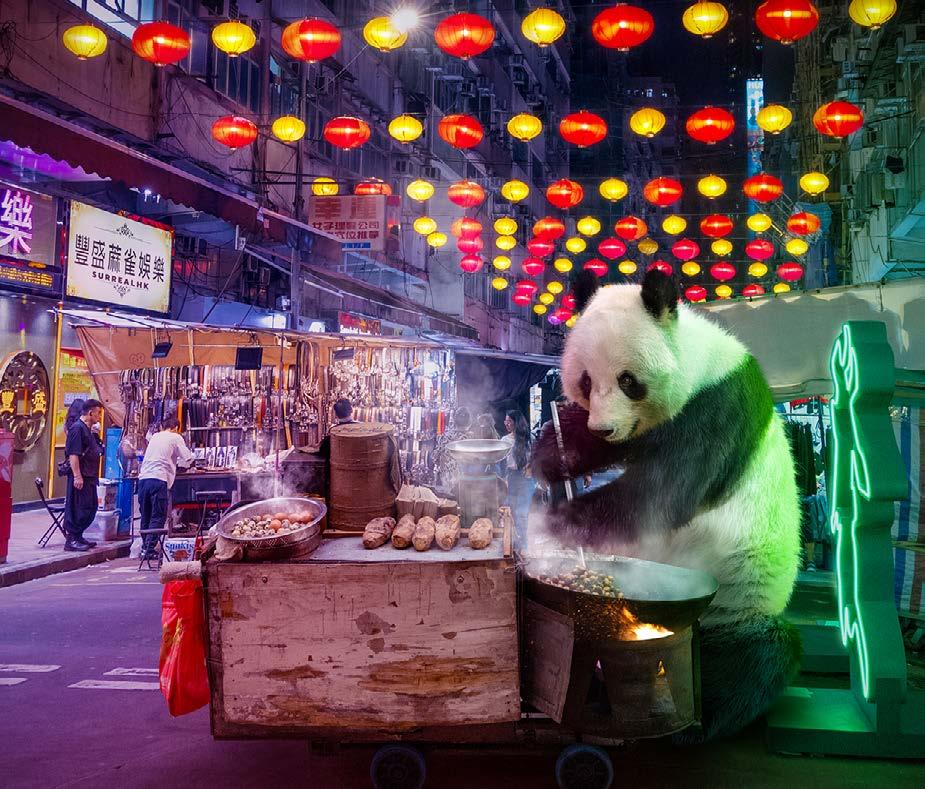
‘Surreal Giant Pandas in Hong Kong’ by creative master SurrealHK (Tommy Fung) showcases artwork which focuses on the much-loved panda, in a visual journey through Hong Kong.
With the recent birth of the first “made in Hong Kong” panda cub and the arrival of two new giant pandas last year, panda mania has swept across the city. SurrealHK pays tribute to these charismatic creatures through his extraordinary photo editing skills, blending dreams with reality through the use of rich colours and intricate details that transport viewers to a whimsical world. Each piece tells a story, subliminally exploring the depths of inner emotions and thoughts.
Tommy Fung was born in Hong Kong in 1979. At the age of nine, he moved with his family to Maracaibo, Venezuela where he studied Graphic Design at La Universidad del Zulia, obtaining his degree in 2005. Shortly after his graduation, he


started his own business as a freelance graphic designer and discovered his passion for photography. Since then he has combined his various skills to produce his artworks.
In 2014, he was one of the finalists at the WYNG Masters Award, a non-profit photography award that aims to nurture the growth of photography as an art form in Hong Kong, as well as stimulate dialogue and foster community awareness on socially relevant issues of importance to the SAR. In 2017, he participated in the deTour design festival at PMQ, exhibiting his earliest artworks under the title of ‘Real or Surreal’. He went on to stage his first solo exhibition entitled ‘My Surreal Life in Hong Kong’ at 13A New Street Art Gallery to an overwhelming response from his fans.
The artist’s work has attracted almost 200,000 followers on Instagram, resonating with the public and bringing smiles to many.
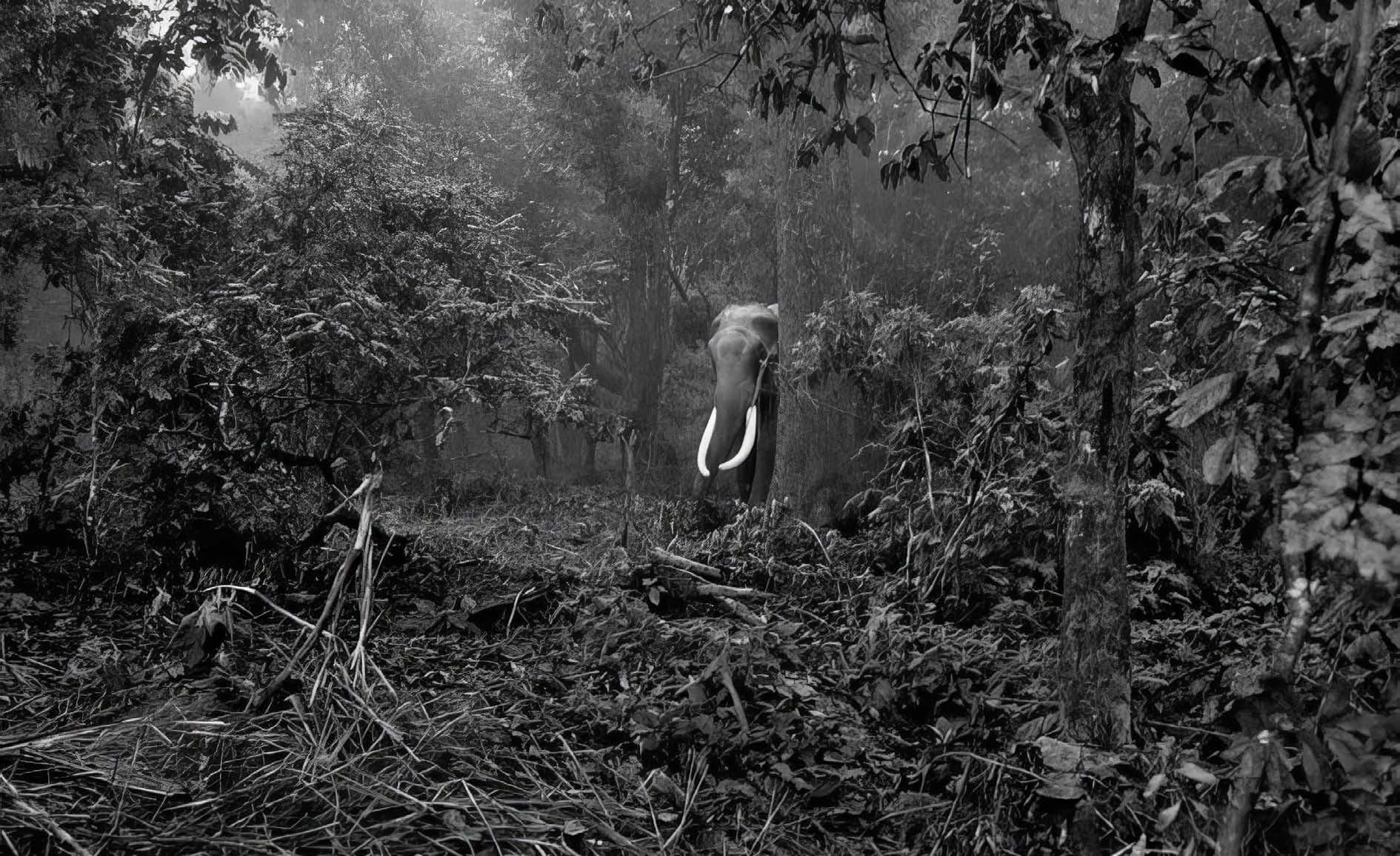
Through his breathtaking black and white images, Palani Mohan takes us on a poetic journey, revealing the beauty found in silence, stillness in epic scenery, and fleeting moments in our near environment. Each photograph invites the viewer to pause, observe, and discover the magic of our wonderful world.
Mohan’s images, taken in various corners of the world, weave together a poetic narrative of his awe-inspiring travels.
The photographer shares his perspective on the collection, stating: “These images are a personal look at places where I have found peace and meaning. It is a search for the magic and the miracle that lie within the smallest things that surround us. Such moments are just waiting for us to pull at the reins, stop, and take notice.”
Born in India, raised in Australia, and currently based in Hong Kong, Mohan credits travel as a crucial element in his more than three-decade career.
“When you look down into the magnificence of the Nubra Valley in the Himalayan ranges, it’s easy to overlook the family of white doves flying just below the mist line. There is so much going on, so much to see, so much to think about and do in our busy minds,” says the photographer. “But once you start paying attention to all the smaller things in the much wider canvas, the doves are just as breathtaking as the
thousand-year-old monastery clinging to the cliff’s edge. The passing clouds filled with ice and rain and the arrival of the first soft light over the snowy mountains are miracles for us to watch with wonder.”
Indian born, Australian raised, and now living in Hong Kong, Mohan is the author of eight books, including ‘Hunting with Eagles: In the Realm of the Mongolian Kazakhs’ which has been lauded as “an anthropological treasure”. His latest book, ’Watch with Wonder’, published by Hong Kong University Press to coincide with the exhibition of the same name, first shown at Blue Lotus Gallery, features 107 duotone images, each capturing evocative moments of a captivating yet calming journey across our planet.
Mohan’s images have been widely featured in many of the world’s leading publications. His work is part of the collection of the National Portrait Gallery in London and his photographs have been shown widely including at the prestigious Visa Pour L’Image in Perpignan, France.
“My hope is that the viewer will pause, slow down and take notice,” he says. “Pay attention to the small, magical things that are happening within each one of the images and find your own place within them. There we can meet in silencebe still, and watch with wonder.” n
By Hugo Novales
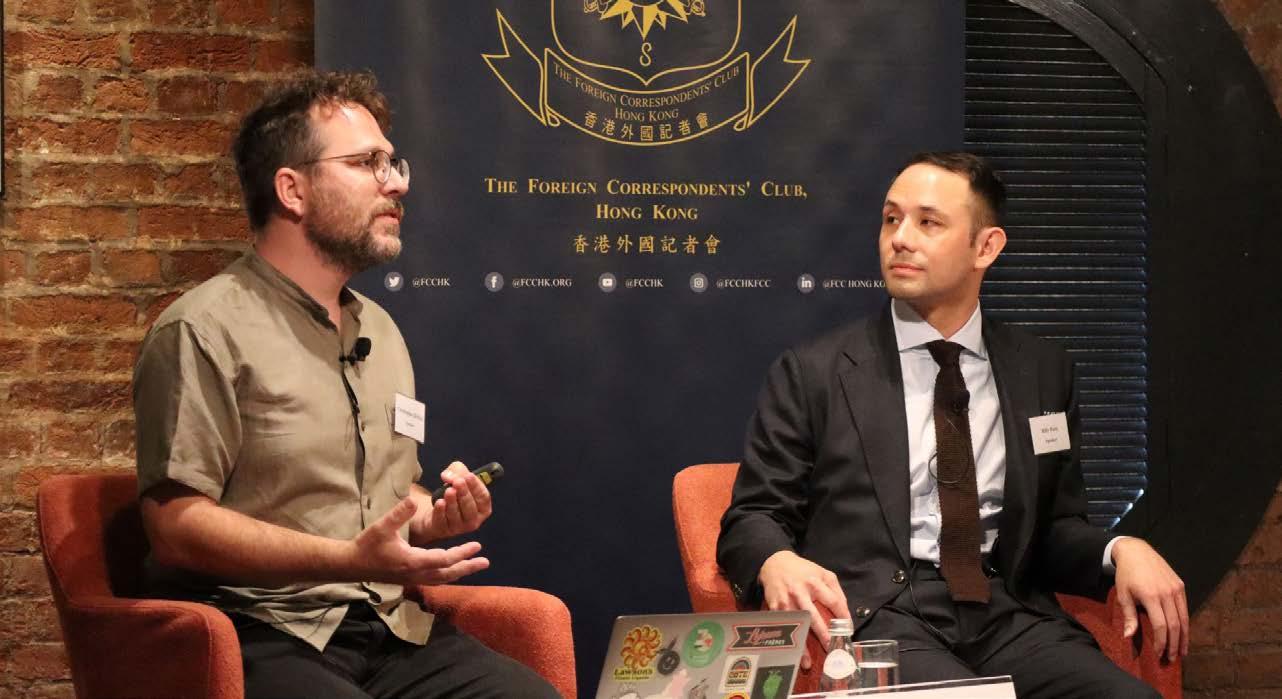
Henry Steiner moved to Hong Kong in 1961 and only intended to stay for nine months in his job as a graphic designer for Asia Magazine. Finding the city full of more career opportunities than New York or other popular destinations, he stayed and ultimately became the ‘Father of Hong Kong Design’ for his work with some of the city’s most recognisable brands. Visuals for Cathay Pacific, HSBC, the Jockey Club, Standard Chartered, Wellcome, and many more entities have come to life through Steiner’s creativity.
Zolima CityMag, a local publication that covers Hong Kong culture, recently published the first volume of its Zolima Culture Guide, which features the city’s history through the work of Steiner and the legacy of his designs.
At an FCC Club Lunch attended by Steiner himself, the two writers behind Zolima Culture Guide – Henry Steiner’s Hong Kong sat down with Correspondent Board Governor Jennifer Jett to talk about their new book and how the legendary graphic designer’s work has influenced their lives.
“From the very beginning, we didn’t want to do a biography of Henry Steiner or even a catalogue of his work; it is the story of Hong Kong through his work,” explained Christopher DeWolf, who has been writing about the city’s architecture, culture, design, and history for over 20 years.
While “East meets West” concepts have been commonly used over time, Steiner’s work stands out in that he has highlighted the differences between each and combined them in unique ways.
“We’re talking about Henry’s perspective as an outsider, somebody who could interpret Chinese characters without
even being able to read [them], and yet being able to articulate [their] nuance[s] as a symbol,” said co-author Billy Potts.
Potts was already a huge fan of Steiner’s work when embarking on his own design career. In his first interviews with Steiner, he said that he was concerned that the famed designer wasn’t giving him enough to work with, but upon reflection, he realised that Steiner was speaking about himself through the lens of Hong Kong’s design and how he fits into the city’s history. It is this specific angle that Potts and DeWolf took when writing the book.
In Potts’ opinion, Steiner’s work, especially that done for various magazines early in his career, is not just about design, but also communication. He believes that the work of many designers in Hong Kong can in some way be linked back to Steiner.
“You can see how Henry is a focal point for design and communication in Hong Kong. If we were to seek out any creative design person in the city, you wouldn’t have to push very far before you realise that it connects back to him.”
Henry Steiner still lives in Hong Kong to this day, more than 60 years after his arrival. If one walks through certain parts of Kowloon, along the routes that Steiner, Potts, and DeWolf took during the process of writing the book, the designer’s influence is extensively apparent in everything from signage to billboards to bus ads, ultimately pervading daily life in Hong Kong.
“Over 60 years, if you look at all the projects that Henry Steiner has worked on, you’re understanding the story of Hong Kong and how it has visually evolved through the years,” said DeWolf. “That’s what I think makes his work so interesting.”
By Hugo Novales
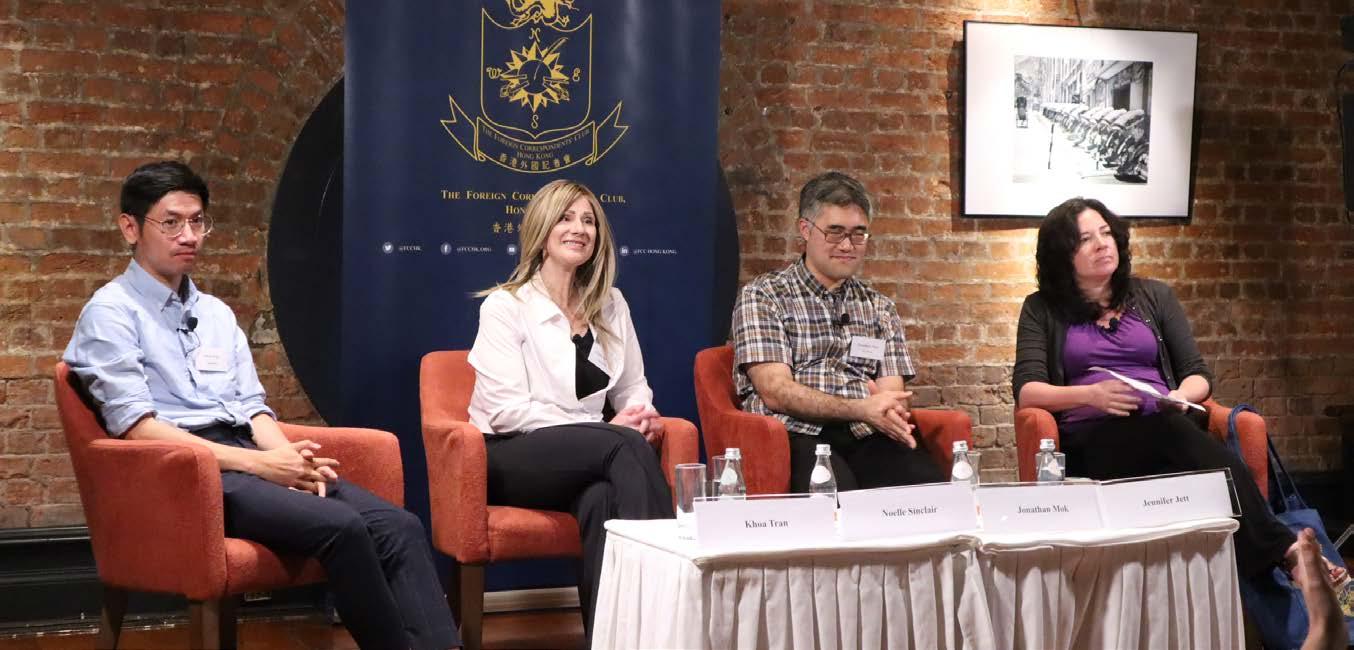
The World Economic Forum estimates that around 1020% of the world’s population is neurodivergent, and yet nearly 85% of these individuals are unemployed. People who aren’t neurodivergent (often described as neurotypical) have an unemployment rate of only 4.2%.
What exactly does neurodiversity mean? How are neurodivergent people different from everyone else? Also, what can companies and organisations do to help accommodate neurodivergent people in the workplace?
To answer these questions, the FCC held a Club Lunch panel with three professionals who were diagnosed with neurodivergent conditions as adults – Jonathan Mok, a neurodiversity advocate and public speaker; Noelle Sinclair, CEO of Diverse Minds; and Khoa Tran, a freelance writer and journalist. Moderating the panel was Correspondent Board Governor Jennifer Jett.
Each panellist first offered their own definition of what it means to be neurodivergent.
“It’s more than just what’s going on in our heads; it’s about how we experience the world around us,” said Sinclair, who was diagnosed with Autism Spectrum Disorder (ASD) and later Attention Deficit Hyperactivity Disorder (ADHD) when she was 40 years old.
“Neurodiversity is more about one’s identity,” added Mok, who was also diagnosed with ADHD and ASD at the age of 37.
“It’s not just learning disabilities, it’s not just quirks… it’s much broader,” said Tran, who was diagnosed with ADHD just two years ago.
Tran also described his first time taking Ritalin, a prescription drug used to treat ADHD symptoms.
“Oh, this is what it feels like to be normal, to have a quiet mind. It’s almost like an awakening,” he said, adding that the experience of feeling “normal” left him with tears in his eyes.
Along with ASD and ADHD, neurodiversity also includes dyslexia, Down’s Syndrome, bipolar disorder, and a variety
of other conditions. While each of these conditions has its own set of characteristics, Sinclair added that the umbrella term “neurodiversity” was created in the same sense that the term “biodiversity” was created, as a social movement term to highlight how an ecosystem thrives on diversity.
“The point was to drive awareness that those of us who are neurodivergent face biases, discrimination and stigma, and if the world were in some people’s hands, people like myself, Jonathan and Khoa would be taken out of existence,” she said.
The panel then discussed how Hong Kong’s corporate world has evolved to be more accepting and inclusive of neurodivergent people. While positive changes have been made, like the inclusion of non-discrimination statements at the end of job ads on LinkedIn, the panel agreed that there is still room for improvement.
“We need to create a new affirmative environment for people,” Mok said when describing how neurodiversity information needs to be localised for a population that primarily speaks Cantonese and may be unfamiliar with these emerging concepts.
Mok also noted that by focusing on university students, Hong Kong’s current efforts may be unintentionally excluding people like him and the two other panellists who were diagnosed later in life, and may already have a certain amount of work experience.
On top of hiring practices and workplace situations, Sinclair also offered a business perspective, reminding the audience that neurodivergent people are also potential clients and customers who all run a chance of interacting with nearly any type of business. “If you are providing a service and your business isn’t taking into consideration people who are neurodivergent, you are losing customers.”
To watch the full discussion, please visit the FCC’s YouTube channel: https://youtu.be/nHOBWSy95sw
By Hugo Novales
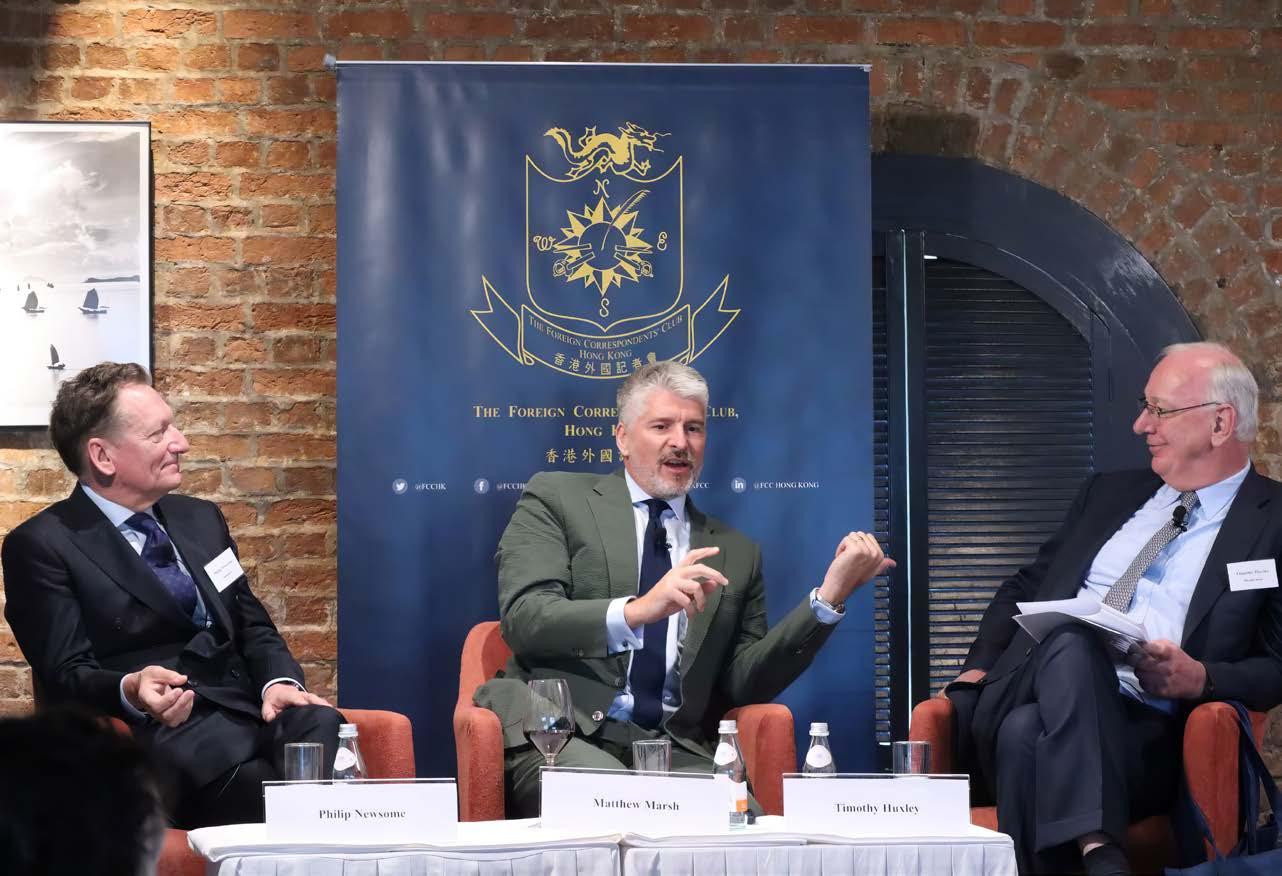
Matthew Marsh never holds back when sharing his insights with the Club’s motorsport enthusiasts at the annual Formula One themed lunches. He was back at a Club Lunch last November to preview the 2024 Macau Grand Prix with Dr. Philip Newsome, a former HKU Professor of Dentistry who has spent the past 33 years writing and photographing the motorsports extravaganza. Newsome has also authored several books on the iconic event, including last year’s Macau Grand Prix: Photographs 1954-2023, images from which were featured on the FCC’s Hugh Van Es Wall last November.
“Macau is a place where legends are born, [where] stories are written,” said Marsh when describing how Hong Kong’s neighbour has impacted the world of motorsport.
Like Marsh, Newsome agrees that the Macau Grand Prix is like no other motor race and is one of the most high profile events for up-and-coming drivers, many of whom have competed and benefited substantially from impressive performances navigating the daunting streets of Macau.
“If they win, they have to be good. But winning in Macau isn’t just about talent, it requires a lot of luck. There are many great drivers who’ve raced in Macau and haven’t won it, but have gone on to great things,” noted Newsome, citing the examples of multiple Formula One champions Lewis Hamilton and Max Verstappen, who in the past have delivered hugely impressive performances in Macau, but ultimately failed to take the winner’s spoils.
Marsh and Newsome discussed how they initially discovered the Macau Grand Prix.
Marsh had often heard about the race during his own racing career in the U.K., but he never considered attending
— or racing there himself — until he moved to Hong Kong. Through contacts made whilst visiting the event, he eventually secured a place in one of the support events and then became a regular competitor. He experienced the highs and lows of this most demanding of circuits, winning the Porsche Carrera Cup Asia Championship in 2004 in the final round, but also surviving a first corner crash which took out much of the field a couple of years later.
Newsome had frequented motorsport events in Europe before moving to Hong Kong and attending his first Macau Grand Prix in 1985, yet he felt that the viewing experience wasn’t fulfilling enough. Not having the ability to be a successful driver himself, he realised that pictures and writing might be his ticket to a better seat.
“Sitting in the stand is fine, but it can get a little boring. So I thought, I want to be over there; I want to be where the action is,” he said, referencing the frenzied activity in the pit lane and garages.
Newsome’s early ventures into motorsports journalism included interviewing Sir Stirling Moss at his home in London, initiated by the fact that Moss’s father had not just been a competitive racer, but also a dentist working out of a mobile surgery in bomb-ravaged wartime London. Newsome has also penned the biography of Teddy Yip, the Macau casino mogul who went on to successfully run racing teams all over the world. n
To watch the full discussion, please visit the FCC’s YouTube channel: https://youtu.be/TK7VQASsfQQ?si=atjhCMpdVrACH9Qw
As we usher in the Year of the Wood Snake, as is customary, the Club serves up two of the most auspicious Lunar New Year dishes, and a host of warming winter Chinese clay pot casseroles.
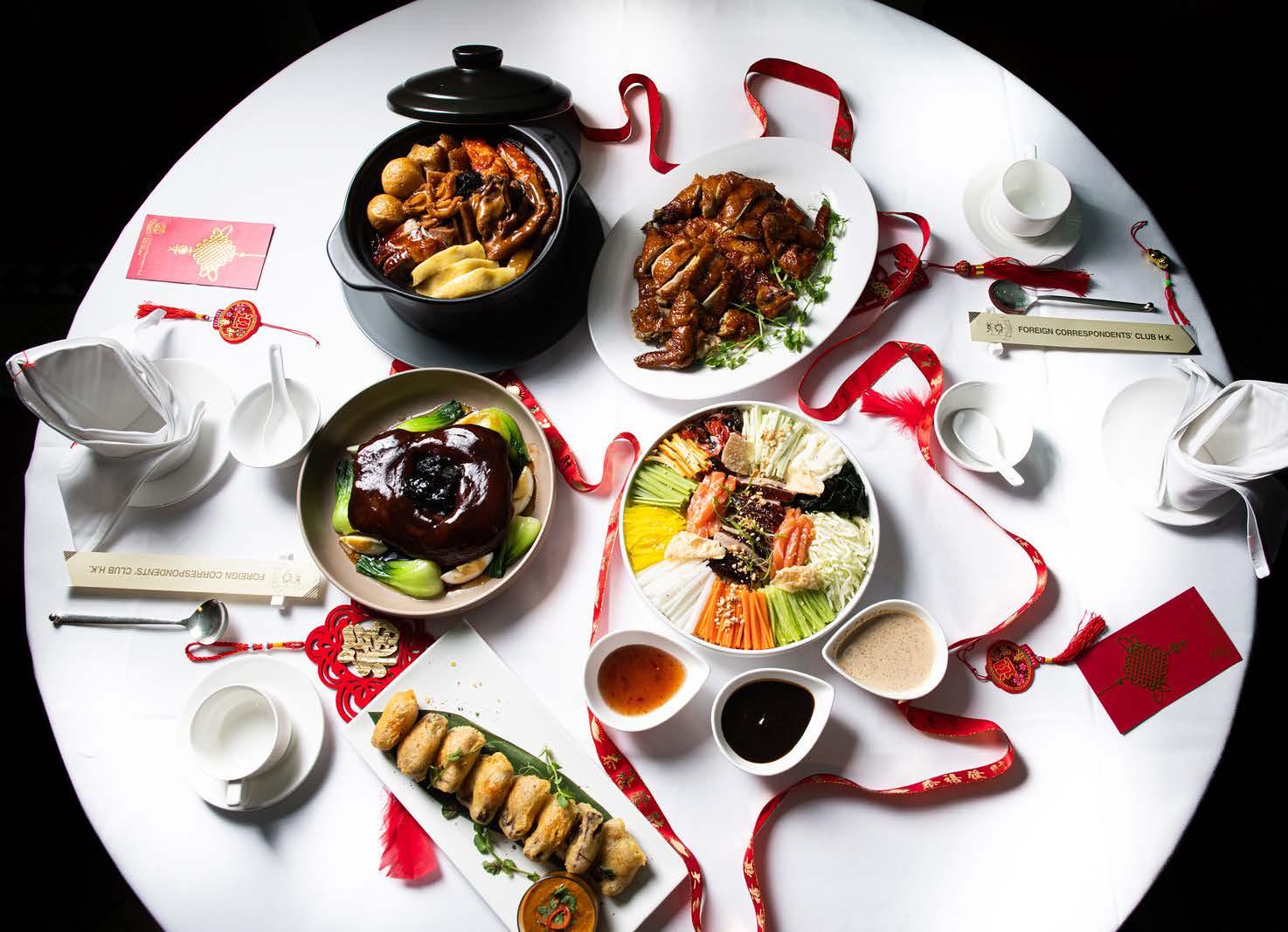
From now until February 12, Members can indulge in an array of authentic and comforting Cantonese-style casserole dishes, featuring ingredients like lamb, oysters, chicken, Chinese pork sausage and seasonal vegetables.
Whether you opt for a half portion or full portion for 2-3 guests, these hearty casseroles are the perfect antidote to the cold outside. Menu highlights include claypot rice with chicken, preserved Chinese sausage and mushroom; claypot fried rice with scallops and fried glutinous rice with preserved meat and sausage. Vegans can opt for braised vegetables with red fermented beancurd, or a seasonal favourite, pea shoots served in a choice of three different ways – stir-fried, garlic fried or in soup.
Make your reservations now to indulge in this winter culinary experience. Takeaway options are also available.
As the Year of The Snake approaches, Members can enjoy two traditional Lunar New Year specialities, Poon Choi and
Lo Hei at the Club.
Symbolising the hope for abundance in the year ahead, Poon Choi is a bountiful arrangement of ingredients including abalone, fish maw, dried scallops, dried oysters, sliced meats and vegetables, often served in a clay pot which usually takes centre stage during Chinese New Year reunion dinners when families gather around the dining table.
Another popular Chinese New Year dish is Lo Hei, which is revered for the fact that it is said to bring fortune and prosperity to those who partake of it. The origins of Lo Hei date back more than 750 years to the Song Dynasty, when fishermen along the coast of China would celebrate the seventh day of the Chinese New Year, also known as ‘everyone’s birthday’, with this fresh fish and vegetable dish.
According to tradition, the host of the table adds the condiments in order and then everyone at the table takes their chopsticks and tosses the ingredients, together shouting “Lo Hei!”, which literally means “to mix it up”, but also sounds like “prosper more!” Legend has it that the higher you toss, the more prosperous you will be. n
On 18 February,, the FCC will present a one-night only sake dinner, so in preparation, we bring you a rough guide to Japan’s most prolific beverage.
By Ken Tashiro
Just as a masterful blend of must from grapes or an exceptional single varietal of grape can form the nucleus of a fine wine, to create an outstanding sake requires the use of a special type of rice, one with a high starch content in the core of each grain. Sake brew masters achieve this by milling away the outer part of brown rice, a process called seimai , or rice polishing. This procedure requires a highly experienced eye in order to be able to catch the grains at just the right moment to halt the process.
The classification of sake is based on the ingredients and the rice-polishing ratio. The rice must be fine, but not so fine that it disintegrates during the brewing process - it has to stay intact for long enough to allow any excess oil and protein to be removed. The resulting rice is known as shinpaku-mai. Sake is held in such high esteem in Japan that there are specific words for each part of the process and the individual ingredients.
In addition to the quality of the rice, the climate and water in the production area are also crucial factors, just as terroir is at the heart of grape winemaking. In Japan, the best sake-making regions are noted for both their moderate weather conditions and the exceptional quality of the water in the underground springs. The majority of sake is brewed in Niigata Prefecture, although almost all Japanese regions make sake.
In winemaking, once the grapes are crushed to release the ‘must’ juices, the natural yeast on the skins ferments and produces alcohol through a single fermentation process that can be anywhere from a modest 7% Alc to a numbing 16% Alc. Sake-making implements a process known as ‘multiple parallel fermentation’, a unique brewing method that results in a high alcohol content. It is an ingenious method devised by the Japanese to produce an alcoholic drink from something other than fruit (they didn’t have many wine grapes a thousand years ago) by converting glucose into alcohol. This results in sake having a higher alcohol content than many wines.
The taste of sake depends on achieving a balance between sweetness and acidity through the combination of water, malt, yeast and steamed rice. Experts say this cannot be assured by technology alone, but only with the experience of skilled artisans who are able to recognise the subtleties of the most minute changes in climate, rice and water.
Another significant difference between wine and sake production is quite a simple one. In the making of wine, the fermentation process is started within a liquid. For rice wines, the process of fermentation is started after water is
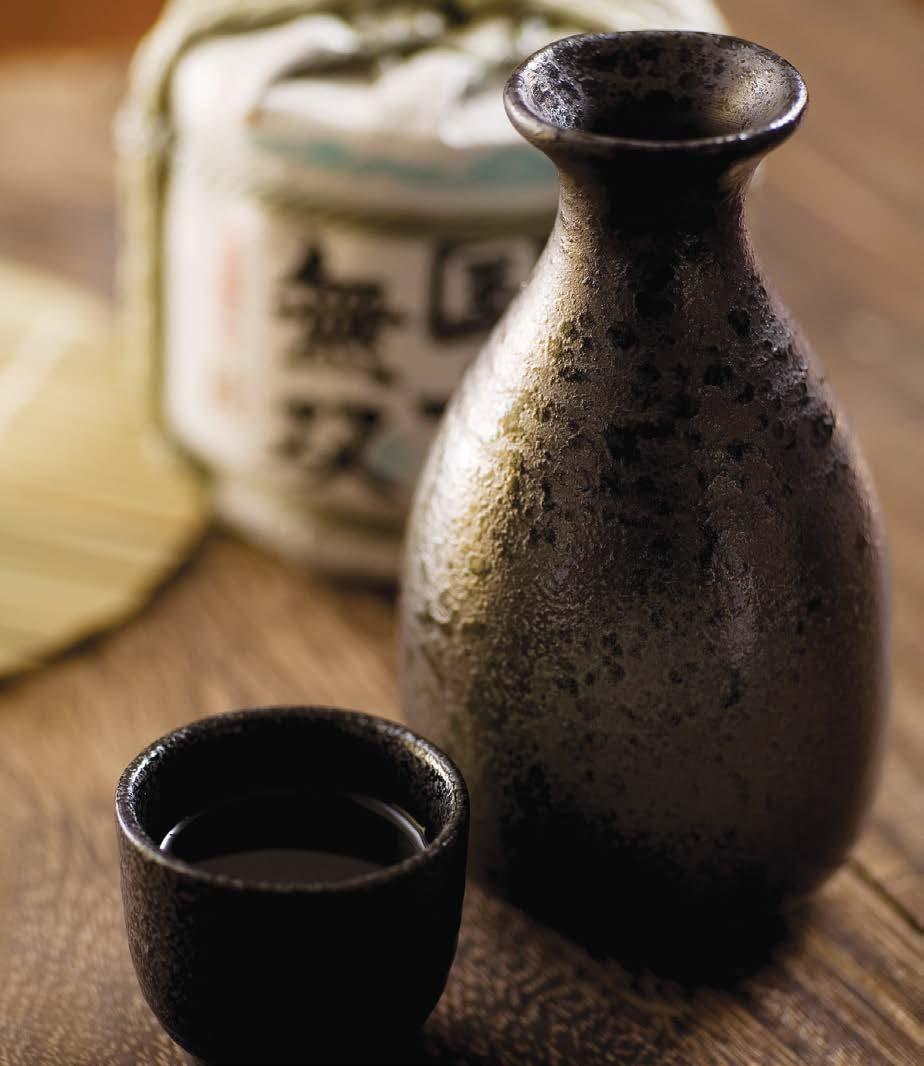
added to the solids. To stop enzyme activity and preserve the flavour of sake, the beverage is heated up to 65°C before storage.
Ordinary sake is called futsushu , the equivalent of which in the wine world would be a basic table wine. Futsushu is brewed using normal table rice as the base material and along with the addition of distilled alcohol, other ingredients such as sugar and amino acids may be added to enhance the flavour.
The rice polishing ratio is the key determinant in sake classification. It refers to the percentage of the rice grain that remains after the outer layers have been polished away. The lower the polishing ratio, the more refined the sake. Here are the primary classifications:
• Junmai : Made with only rice, water, yeast, and koji mould. There are no additives, and the rice polishing ratio can vary, but it is typically polished to at least 70%, giving it a slightly heavier and fuller flavour than other sakes.
• Honjozo: Similar to Junmai but a small amount of distilled alcohol is added for more aroma and flavour. The rice is polished to at least 70%.
• Ginjo: A higher quality sake with a polishing ratio of at least 60%. It can be made as Junmai Ginjo (without added alcohol) or Ginjo
• Daiginjyō: An even more premium category with a polishing ratio of at least 50%, reducing the rice grains to half of their original size. Like Ginjo, it can be Junmai Daiginjyō or Daiginjyō.
Today many Japanese are looking to find new characteristics to their sake. The younger consumer is looking for more flavour, more taste and overall, a more interesting sake, which can usually be found in a Junmai Daiginjyō, whilst for a more traditional tasting sake, try Junmai. With an aromatic flavour, and without the fatty acid that often causes unpleasant after-effects, this is definitely a very pleasant sake to try, especially if you are just embarking on a journey to discover Japan’s best-known beverage. n
The FCC is delighted to welcome its new Members who come from a range of sectors, further adding to the diversity of our Club. Here’s a summary of who they are and what they do.
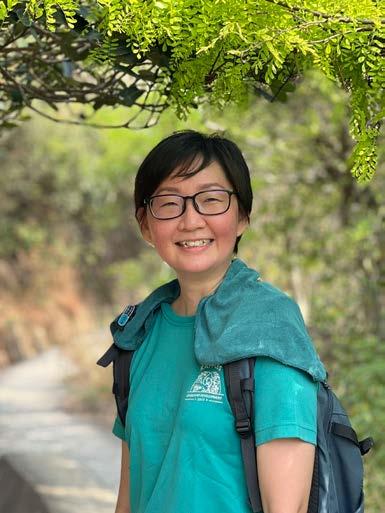
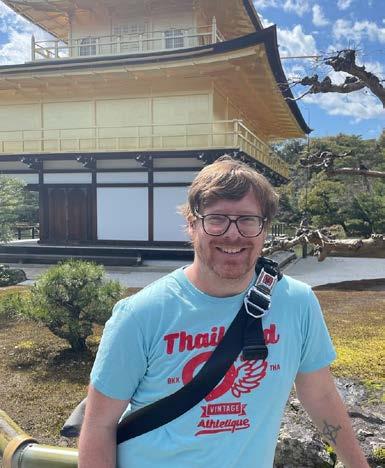
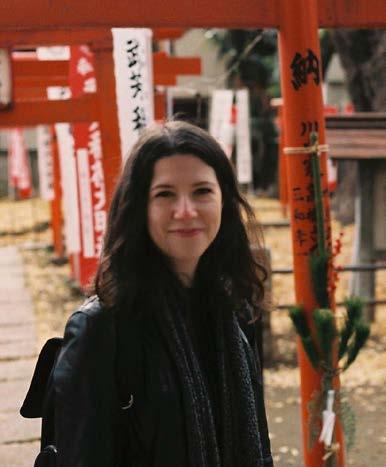
CORRESPONDENT
Journalist
The Straits Times, SPH Media Trust
I’m Magdalene Fung, Hong Kong correspondent with The Straits Times. I’m a Singaporean who has been here for almost 10 years in total. During my initial years here, I lived in a 9 square metre subdivided flat to “live like a local”, which I described in detail in a recent opinion piece. I was previously an editor with the South China Morning Post and Bloomberg. I spent four years back in Singapore throughout the pandemic, during which I wrote extensively on the science of Covid-19, the Ukraine war, and “invisible” communities on the fringes of societies across Asia. There are so many things I want to do; I often wish I had more than just this one life to live. https://www.linkedin.com/in/magdalenef/
CORRESPONDENT
COREY
Journalist
The Majority Report (New York)
I graduated from the Columbia University Graduate School of Journalism, after which I joined IHT ThaiDay in Bangkok. I met my wife, Dr. Patricia Sauthoff, at an alternative newspaper in New Mexico and together we’ve lived in the U.K., India, Canada, and now Hong Kong. I have mostly worked in print, but I also managed an online photo news agency, Demotix , and dabble in broadcast. Nowadays I cover U.S. and international politics for a newsletter called the AM Quickie affiliated with The Majority Report, a New York-based streaming show with 1.6 million subscribers. My first book, Live Work Work Work Die: A Journey into the Savage Heart of Silicon Valley, was published in 2018. My first novel is in the works. coreypein.net
CORRESPONDENT
Reporter - Ignites Asia, Financial Times
I’m a reporter at the Financial Times, covering asset managers for specialist news service Ignites Asia. Originally from North Yorkshire, I moved to Asia in 2022 on a Daiwa Scholarship, which allowed me to study Japanese while living and working in Tokyo. Memorable experiences include cycling 280 km over the land bridges linking the remote islands of the Seto Inland Sea, learning raku pottery at a family-owned kiln in Kyoto, and skulking around Tokyo’s hole-in-the-wall jazz bars. I moved to Hong Kong in July 2024 and have been getting to know the city again after a long time away, having spent part of my early childhood here. Hong Kong’s hiking trails have been among my personal revelations since returning, as has the Main Bar at the FCC. As a relative newcomer, it is wonderful to be able make connections with Members, and I look forward to meeting many more of you in the future.
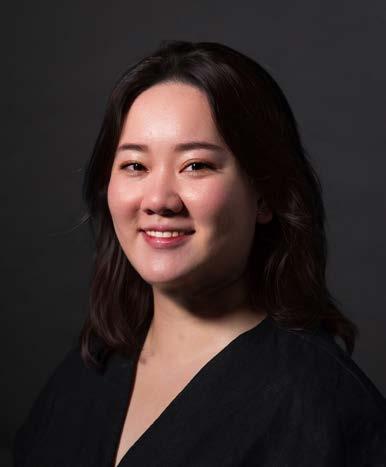

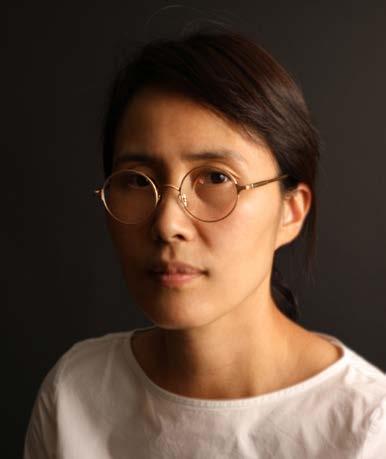
CORRESPONDENT
News Reporter
South China Morning Post
I’ve had the pleasure of calling four different cities “home” throughout my life, but Hong Kong remains my favourite. I’ve been a journalist here for the past decade, first at ATV, TVB and i-Cable, before switching over to print at the SCMP last year. Hobbies? Honestly, as a major introvert, there is nothing I enjoy more than laying around at home, but apparently, I’m not supposed to do that all the time, so I force myself to go outside and be active. Other than that, I love exploring Hong Kong’s dining scene. I had a rather short-lived Instagram page reviewing pho restaurants that I always say I will restart soon, but I can tell you the best pho in Hong Kong is at Brass Spoon or Viet in Happy Valley. I welcome challenges to this verdict. I look forward to seeing you all around!
https://www.linkedin.com/in/wynnawong/
JOURNALIST
Photographer
I have been living in Hong Kong since 2005. Orginally from Melbourne, I moved to Hong Kong as a professional tennis coach in a role with the Hong Kong Tennis Association which then took me to the Hong Kong Country Club for over 10 years. My lifetime passion for photography has seen a career change into professional photography throughout Asia since 2014, covering global summits, professional sports and commercial projects. Hong Kong is an amazing city to live and work in, and when not behind the camera, I enjoy playing golf and travelling.
https://www.christiaanhart.com/
Photographer
I’m a Korean visual artist working mainly in photography and video. Having left my homeland, I have spent half of my life in New York, Shanghai and Hong Kong, where I have often encountered the question: “Where are you from?” in daily life. I have remained preoccupied with an enduring yet challenging theme, identity. Moreover, as a parent of children from an inter-cultural/inter-ethnic marriage, belonging and identity also became a sensitive and significant issue for my family. I started taking portraits of mothers and their mixed-race children around me and collected stories of how interracial family backgrounds impacted their identity formation. That’s how my m<other> project started. Considering the global changes where borders are blurred and the number of immigrants increases dynamically due to political, economic and cultural reasons, I wonder how identity is formed in the contemporary world across the artificial divides of geography and cultures. From blended ethnicity, globalisation and expatrification to hyper-migration, I pose the question of how individuals identify themselves and relate to others. The m<other> project holds a mirror up to society and the world around us and impacts viewers socially, culturally, intellectually, psychologically, and personally. This project has been selected for a 2025 Project Grant from the Hong Kong Arts Development Council, and with a grant from the Museum Hanmi, a book will be published in October 2025. I have exhibited internationally, including at numerous museums and galleries in Seoul, New York, Manila and Hong Kong. I reside in the Southside of Hong Kong with my husband, George, our three children - Wilfred, Max, and Jacob - and our furry friend, Zippy.
Jeeyunkim.com
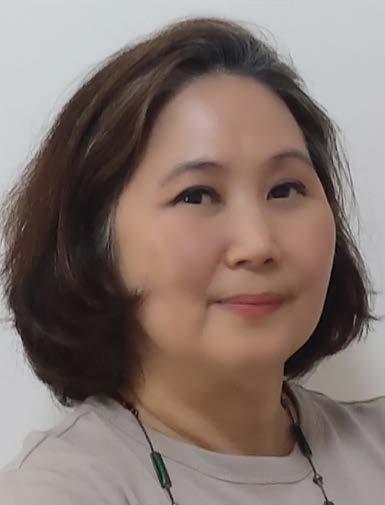
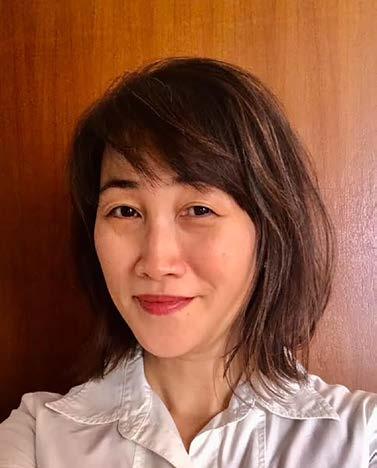
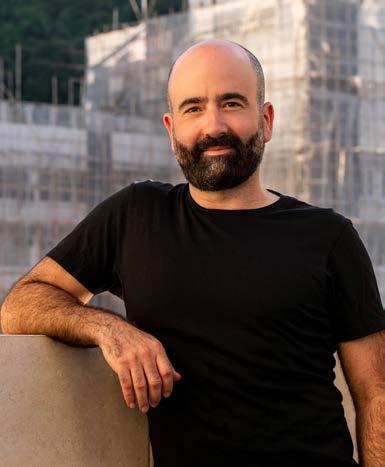
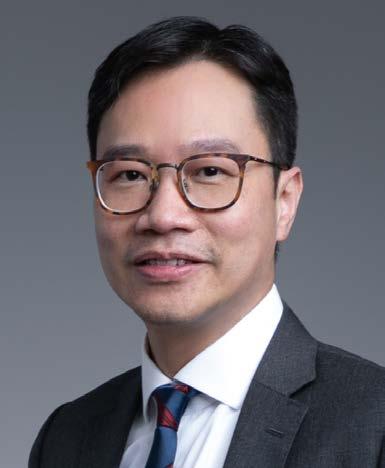
JOURNALIST
Freelance Writer and Editor
I am a writer and editor. This is my second run in Hong Kong. The first was in 1997 when I covered the Handover. This time, my family and I arrived in January 2019 after 18 years in Singapore. I write quite a bit of fiction and have published some short stories. Recently I contributed to an anthology published by Penguin entitled Stories Women Journalists Tell
Editorial Consultant
Caitlin got her start in journalism at the Stanford Daily and trained as an editor at The New York Times. She later covered legal affairs for the Los Angeles Times (where she shared in a Pulitzer Prize for breaking news reporting), wrote magazine-length business stories for Condé Nast’s Portfolio.com, and oversaw an international team as the managing editor of Forkast News, a multimedia platform for Web3 news, features and opinions. Along the way, she has also published work in a number of books and academic journals, and served as an editorial consultant to the United Nations. Caitlin currently works as an editorial advisor specialising in books and other projects.
JOURNALIST
Photographer
Ben Marans Photography Ltd.
Put a camera in my hands and I’ll tell you a story with it. I’ve been a freelance photographer for nearly a decade, with most of that time spent living - and learning - in Hong Kong. Before that, I held a variety of roles in the NGO sector in Canada, fostering innovative climate change solutions and developing social enterprises. I’ve spent countless hours criss-crossing this city, documenting the people and places that make it so special. I’m an insatiably curious photojournalist, a cofounder of Hong Kong Ghost Signs, an avid street photographer, an enthusiastic teacher at HKBU, a snapper of portraits and a very proud dad. www.benmaransphotography.com
ASSOCIATE
CHEUNG
Doctor / Clinical Professor
The University of Hong Kong
Professor Cheung Chi Wai, MBBS(HK), MD(HKU), FHKCA, FFPMANZCA, FHKAM (Anaesthesiology), Dip Pain Mgt (HKCA) is the Clinical Professor of the Department of Anaesthesiology at The University of Hong Kong (HKU). He was also the Peter Hung Professor in Pain Research (Endowed Professor) of the University from 2022 to 2023. He was granted the Doctor of Medicine degree by HKU for research in pain medicine. Professor Cheung has been published extensively in peer-reviewed scientific journals in anaesthesiology and pain medicine. He is a regularly invited reviewer for many international journals and is currently the Section Editor of Pain Practice. Aside from his university work, Professor Cheung is also very active in his medical specialty. He is a past President of the Hong Kong College of Anaesthesiologists and the Society of Anaesthetists of Hong Kong.
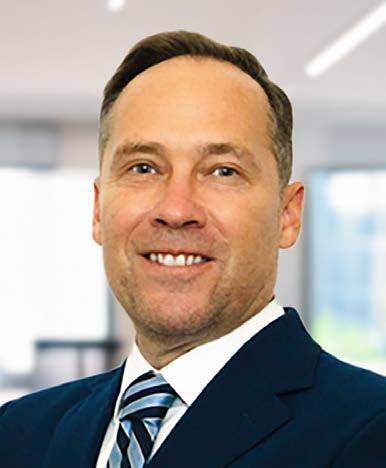
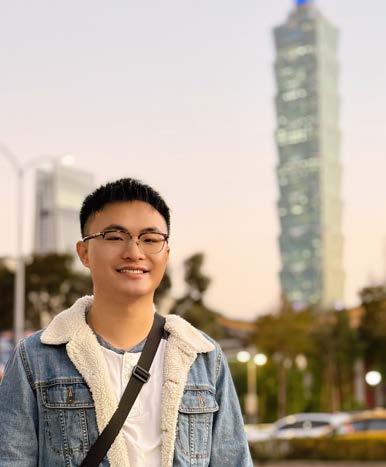
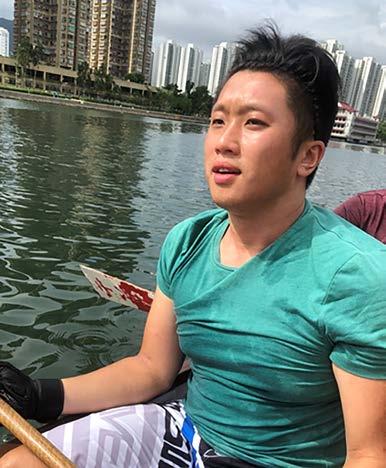
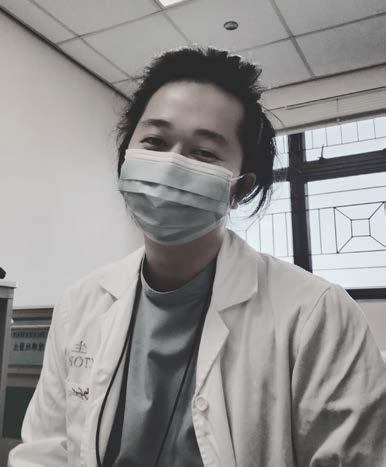
ASSOCIATE
Asia Sales
FlexTrade Hong Kong
Born in the suburbs of Melbourne, my fascination with Hong Kong began in Grade 2 when my teacher showed us her holiday slideshow of the Cross-Harbour Tunnel, the Star Ferry, and the Central skyline, all while serving us mesmerising prawn crackers dropped into hot oil. Arriving in Hong Kong this past April involved several stops: a year as a high school exchange student in Sendai, Japan; 13 years working in Japan after graduating from Monash; a stint in New York; a sabbatical in Sydney that included being a volunteer lifesaver on Bondi Beach; seven years in London; and finally, four years in Singapore. My career has always centred around trading technology in finance. Hong Kong is now our beloved home, where I live with my partner of 10 years, Nick, our two cats, Nacho and Guacamole, and our dog, Kaya. Fun fact: my surname, Kuuse, is Estonian for “spruce tree”. I love swimming, photography and meeting FCC Members!
https://www.linkedin.com/in/mark-kuuse-b746872/
ASSOCIATE
Senior Associate
Messrs Patrick Chu, Conti Wong Lawyers LLP.
I am a solicitor specialising in commercial disputes, regulatory investigation and insolvency, striving to help clients achieve the best practical outcomes and mitigate risk. Inspired by the late Charlie Munger’s wisdom to “spend each day trying to be a little wiser than you were when you woke up”. I’m a voracious reader. Biographies, investing and sociology are among the categories I am most interested in. I also love travelling abroad and exploring different cuisines. I am a proud dog dad to Bailey, my mischievous one-year-old Yorkshire Terrier. I cherish spending quality time with him after work with cuddles and fun and you will most likely find me at a dog park with him. I look forward to enjoying my time at the FCC and getting to know fellow Members at the Main Bar or Bert’s and appreciating all that the FCC has to offer!
https://www.linkedin.com/in/victorlamct
ASSOCIATE
Barrister-at-Law
I have been hooked on dragon boating since 2018 and I am currently a member of the La Salle Dragon Boat Team and the Hong Kong Bar Association Dragon Team “Dragon Advocates”. I practise all year round and have found it very enjoyable over the years. But no, dragon boating doesn’t help flatten my beer belly; maybe I don’t practise hard enough or perhaps the lure of English bitter is too tempting for me. This beverage is best served in the form of cask (real) ale but it is almost impossible to find in Hong Kong. It would be great if the FCC could host a real ale tasting session in the future! It’s a pleasure to meet you all.
ASSOCIATE
Medical Doctor / Resident
Pamela Youde Nethersole Eastern Hospital
Born and raised in Hong Kong, I went to medical school at the Chinese University of Hong Kong and I am now a psychiatrist working in a public hospital. I like to sleep, eat good food and shop. Life is too short to be unhappy.
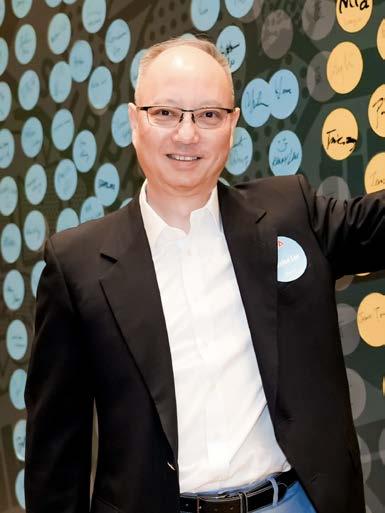
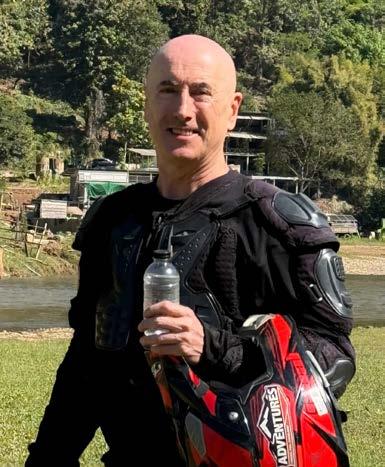
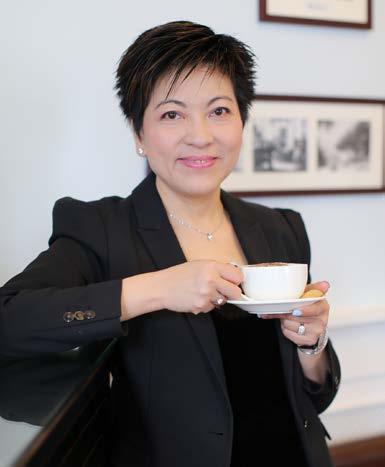
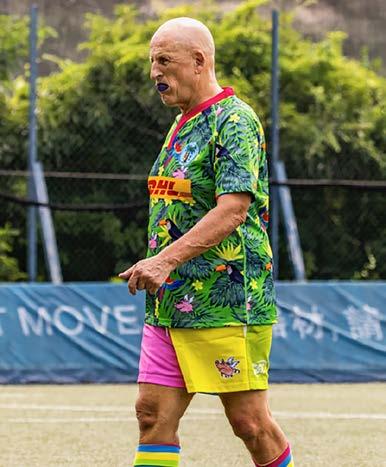
ASSOCIATE
Managing Director
MGA Entertainment (HK) Ltd.
I have been lucky enough to experience the growth of the toy industry in Hong Kong since the 1980s. I started my career in a semiconductor factory before moving into the telecommunications industry, and then the exciting toy industry for nearly 35 years. Although I travel extensively, I am able to keep myself in shape because I enjoy playing all kinds of sports and I am also a squash coach. I am willing to share my experiences and life journey with anyone who is interested, especially the subject of toys around the globe. Just come and say hi!
https://www.linkedin.com/in/winston-lee-b781a1a/
ASSOCIATE
Regional Technology Director
Clifford Chance
My career to date has been diverse and enriching. I started as a network engineer, then moved into project management, sales, business management, and now serve as Regional IT Director for a major law firm. I relocated from London to Hong Kong in 2008 and have made it my home since. I also worked in Dublin for three-and-a-half years. Outside work, I enjoy travelling, golfing, watching live football (I’m a lifelong Spurs fan), and catching a good movie or TV drama series (I recommend Slow Horses on Apple TV). I have an eclectic taste in music and enjoy listening to live bands or going to see a musical. Despite playing golf for 35 years, the only thing I’ve mastered is losing golf balls!
Patrick O’Reilly | LinkedIn
ASSOCIATE
Lead Business Consultant
NICE Ltd.
It’s a pleasure to become a Member of the FCC, a heritage icon in the heart of Hong Kong. I have overseen contact centre business in China and Hong Kong for over 25 years. Currently, I am a Lead Business Consultant at NICE Ltd. I also serve as an Exco Member of the Hong Kong Customer Contact Association, Vice President of the China Call Center & CRM Association and the Representative of China in the Contact Center Associations of Asia Pacific. I am also a Council Member of The Helena May, another cherished heritage site just 600 metres from the FCC, where I volunteer for community outreach activities. As a big ice hockey fan, I am proud that my two sons have played for the Hong Kong Ice Hockey National Team.
https://www.linkedin.com/in/joyce-poon-china-hk?lipi=urn%3Ali%3Apage%3Ad_flagship3_profile_view_base_contact_ details%3BO%2F%2BozHzQTF6p91bsrdgH%2FQ%3D%3D
ASSOCIATE
STEPHEN SMITH
Managing Director
Jeir Design Consulting
Ever since I was a child, I have been captivated by travel, dreaming of exploring the world, and playing rugby and golf in the most iconic destinations. I am a publishing and printing veteran of 38 years, and I have been fortunate enough to have travelled the world through my work and social life. I have enjoyed playing rugby and golf in many different countries. I have lived in Hong for 12 years and maintain my passion for golf, rugby, socialising and charitable causes. I am a past captain and active member of WAGS (Wednesday Afternoon Golf Society) and The Pot Bellied Pigs RFC.
https://www.waiman-bookbinding.com/about/
https://www.linkedin.com/in/stephen-smith-b41a17a1?utm_source=share&utm_campaign=share_via&utm_content=profile&utm_medium=ios_app

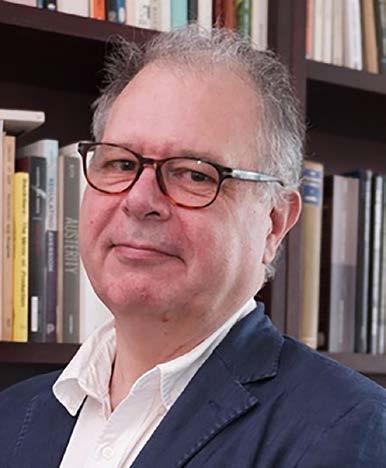
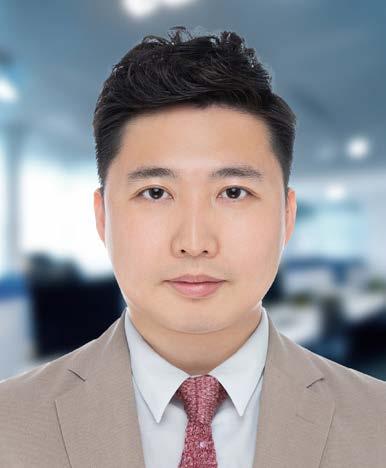
ASSOCIATE
Special Assistant to President of Asia / Chief of Staff
Sun Life
Two decades ago, my life took a thrilling turn when I joined the U.S. Department of Defense as a civilian officer. Some of my favourite posts were to Afghanistan and Nepal. Seeking new horizons, I left public service and joined the finance sector in New York. I moved to Hong Kong five years ago and now work in insurance. I met my husband in Hong Kong and he has also found the region fascinating and really enjoyed joining the FCC. He studied at the School of Oriental and African Studies, has travelled and worked across Asia, including Singapore, Indonesia, Nepal, and Brunei, firstly as a Gurkha Officer, then in a number of regional consultancy roles. He now works for the Hong Kong Jockey Club.
www.linkedin.com/in/sitara-k-timmis-36720577
ASSOCIATE
Professor
The University of Hong Kong
Originally from Scotland, I am the Paul KC Chung Professor in Jurisprudence at the Faculty of Law, The University of Hong Kong. It’s a pleasure to have joined the FCC and I only wish I had done it sooner. I write books and articles on law and legal institutions and have had the good fortune to have been involved in the Hong Kong education system since 2010. My wife Ally, also from Scotland, is a yoga teacher and studies yoga philosophy.
https://www.law.hku.hk/academic_staff/professor-scott-veitch/
Property Manager
Maximus Property Management
I was born and raised in Hong Kong, and I have had a strong interest in politics since I was young. During my university years, I majored in international politics. While others chose to spend their holidays dating, I chose to deeply engage with the community and serve it. After graduating, I participated in the Hong Kong District Council elections and was proud to become the youngest elected member with the most votes in the Yau Tsim Mong District. I have been involved in politics and community work for nearly 10 years. Time flies, and I have now entered another stage of my life. I feel happy and have no regrets about dedicating 10 years to working hard to serve the community. As everyone knows, the past decade in Hong Kong has seen many changes. I stepped down from my positions as a District Councillor and Vice-Chairman of the District Council, but I continue to serve the citizens of Hong Kong in a different capacity and position. I currently work as a property manager, providing professional property management services to residents and buildings in Hong Kong. At the same time, I am also studying for an LLB Bachelor of Laws degree at the University of London, hoping to use my enhanced legal knowledge to help more people in Hong Kong. I have had many a lunch and dinner at the FCC and look forward to getting to know many more of you.
OTHER NEW MEMBERS
Jovan Cenev Citi Private Bank Banker Associate
Sarsh Elizabeth Chauliac FGS Global COO and Communication Advisory Associate
Wesley Chu Cathay Pacific Airways Pilot Associate
Jakob Hesse Somerley Capital Ltd.
Matthias Kaufmann European Union Office to HK and Macao
Leung Arwin Sau-Ling Credit Suisse (Hong Kong) Ltd.
Corporate Finance Adviser Associate
Dep.Head of Office/ Head of Political, Press and Information Section Diplomatic
Director of Information Technology Associate
Alex Macro Alex Macro Photography Photographer Journalist
Brian Mahoney Daisi HK Ltd. Director Associate
Fulton Mak HSBC
Senior Communications Manager Associate
Mojalefa Mogono South African Consulate General in HK SAR Consul General Diplomatic
Alexander Paul HSBC Global Co-Head, Technology and Financial Services Associate
William Potts - Freelance Writer Journalist
Han Seulah FTI Consulting
Surali Siriwardene HSBC, PayMe
Managing Director, Head of HK & Korea , Strategic Communications Associate
Chief Operating Officer Associate
Sze Kyran KYSS Properties Ltd. Chairman Associate
Steven Tait - Programme Director (Self-Employed) Associate
Alexander Van Praag LPF Foundation Ltd.
Director Associate
Wong Ning Hing, Grace Retired Associate
Clement Yiu Nasdaq HK Limited
FULL NAME COMPANY
Business Development Director Associate
POSITION
CATEGORY REPLACEMENT
Jean Marc Jullienne UBS AG Hong Kong Branch
Marc H. Williams U.S. Consulate General HK and Macau
Patrick Daniel Orchard Australian Consulate General Hong Kong
Stephen James Watson Zetland Corp. Serv. Ltd. (Gemini Personnel)
William Joseph Owen U.S. Consulate General HK and Macau
Harvey Simon Rouse European Union Office to HK and Macao
Paul Michael Pealling ABN AMRO Clearing Hong Kong Ltd.
Wu Meng Hwa Vincent ABN AMRO Clearing Hong Kong Ltd.
Jens Kutscher Con. General of the Fed. Rep. of Germany
Au Lee Janet UBS AG Hong Kong Branch
Chan So Ying New World China Land Ltd.
ABSENT
Won Mee Yee May HKSAR
Rory Robert Thomson Marsh Mclennan
Li Meng De Bakker -
Mala Ramchandani Chinese International School
Cheng Kwok Bo Anthony PricewaterhouseCoopers
Harold Anthony Nafte CLSA Ltd.
Brian Fidelman The New York Times
Bettina Wassener International Herald Tribune
Timothy Payne Brunswick Group Ltd
Mark Lovell Side Tanner De Witt Solicitors
Allen Yu Dynasty Enterprises (Asia) Ltd.
Stock Broker Corporate
Diplomat Diplomatic
Consul (Poltical & Economic) Diplomatic
Group General Manager Corporate
Consul Diplomatic
Ambassador / Head of Office Diplomatic
Managing Director Corporate
Head of Relationship Management Corporate
Diplomat Diplomatic
Business Manager Corporate
Internal Auditor Corporate
Detective Senior Inspector of Police Associate
Vice President Associate
Freelance Journalist
Director of Service Associate
Senior Manager, Capital Market Serv. Associate
Senior Economist Associate
Deputy Editor, International Ed. Correspondent
Foreign Correspondent Correspondent
Asia Chair and Senior Adviser Associate
Partner Associate
Director Associate
Elley Mao The University of Hong Kong
Loo Peck Hwee Celene OF Capital
Cheung Vanessa Tih Lin Nan Fung Development Ltd
Girish Jhunjhnuwala Hind Hotels & Properties Ltd
Ho Lok Yee ChinTell Ltd.
Mary Kathryn McHale Equinix
Honorary Research Associate Associate
Partner Associate
Group Managing Director Associate
Managing Director Associate
Senior Writer Journalist
Business Development Director Associate
Petru Brediceanu Segantii Capital Management Ltd. Associate
John Robert Brewer Pacific Chambers
Associate
Gao Ming Yue NBC News Asia Desk Fellow Correspondent
Taha Barma H T Barma Ltd
Paul Barry Tait Agence France-Presse (AFP)
Ian James Goff King George V School
Leung Kenneth Sai Kit Julius Baer & Co.Ltd.
Associate
Editor Correspondent
Associate
Associate
Per Niclas Hakan Rydin Norebo Hong Kong Ltd Vice President of Sales Associate
David Marc Boulanger Lighting Technology Group Ltd.
Poon Chi Chung Eternity Int’l Freight Forwarder (HK) Ltd
Associate
General Manager, Sales Department Associate
Brett Anthony Rohrsheim - Self-Employed Associate
Jason Matthew Orange The Laurus Group Managing Director Associate
Lin Yuk Yan Maya Cartier Regional High Jewellery Director, Asia Associate
Stephanie Jane Hobler EDP GROUP
REACTIVATED
Associate
Adam Michael Enright Cathay Pacific Airways Senior Captain Associate
Li Chun Hin Justin -
Wolf Peter Berthold Helicon Enterprises Company Ltd.
Howard Clark-Burton BMP Wealth Ltd.
Dominic Alexander Rigby MVision Private Equity Advisers Asia Ltd.
Mounir Guen MVision Private Equity Advisers Asia Ltd.
Vivien Pong Drs. Nicolson & Associates
Tina Tucker Vantage Asia Publishing Ltd
Wijnandus van Hoeven
CHANGE OF CATEGORY - ACTIVE MEMBER
Associate
Associate
Associate
Associate
Associate
Manager Associate
Manager Associate
Associate
Robin Howes KCL, FiSEC Ltd. Managing Director Deceased Leung Rose M.l. - Retired Associate
PHOTOGRAPHERS
CARSTENSCHAEL.COM – Award-winning Photographer. People - Corporate - Stills - FoodArchitecture - Transport. Tel: (852) 9468 1404 Email: info@carstenschael.com
CHRISTIAAN HART PHOTOGRAPHY, providing professional sports, commercial, corporate and aerial photography in Hong Kong and throughout Asia. Studio portrait sessions available, for more information visit www.christiaanhart.com or call +852 96878282


On 21 October, early-career journalists as well as current students and recent graduates from university journalism programmes, had the opportunity to connect with one another and speak directly with FCC Board Members. Attendees learned about how to join the FCC and the benefits that come with being a Member, including access to our series of engaging speaker events, networking opportunities, and more. A warm thanks to all the Board members and journalists who attended.
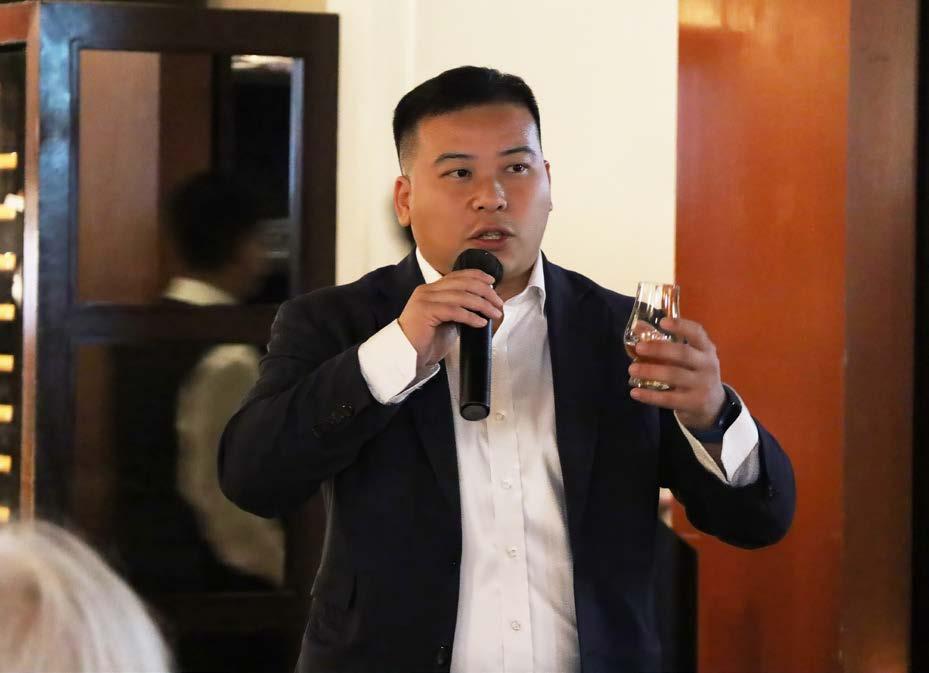
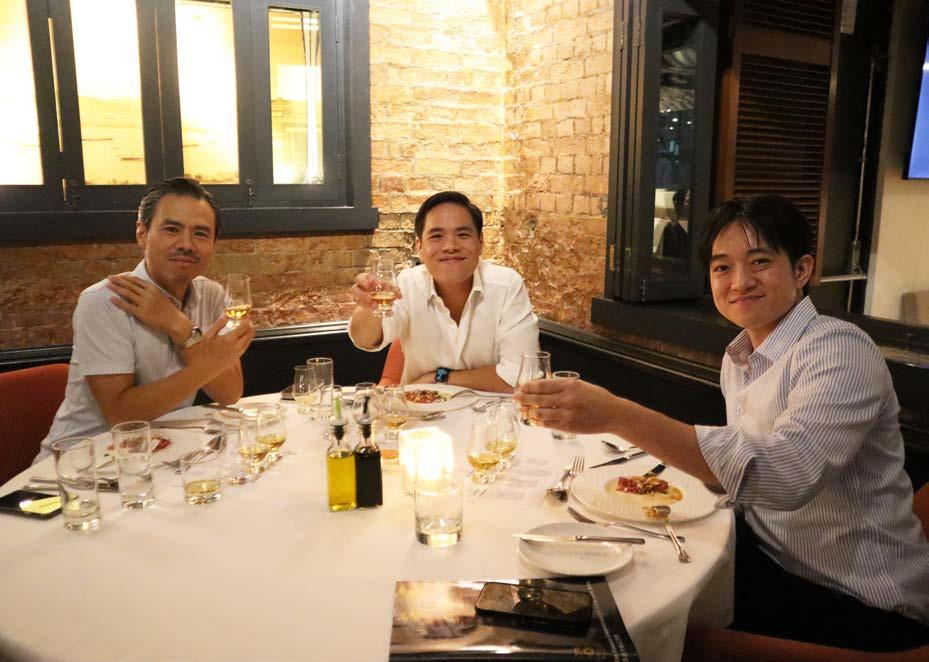
21 October also saw a gathering of whisky enthusiasts at the Club for a Tasting Dinner at which the Guest Speaker was Billy Ng, Whisky Ambassador and Co-Founder of Alcohood. The FCC’s culinary team artfully prepared a fivecourse dinner featuring dishes that paired with 10, 12, 15 and 18 Years Old Single Malts from The Glen Grant Distillery in Scotland’s Speyside.
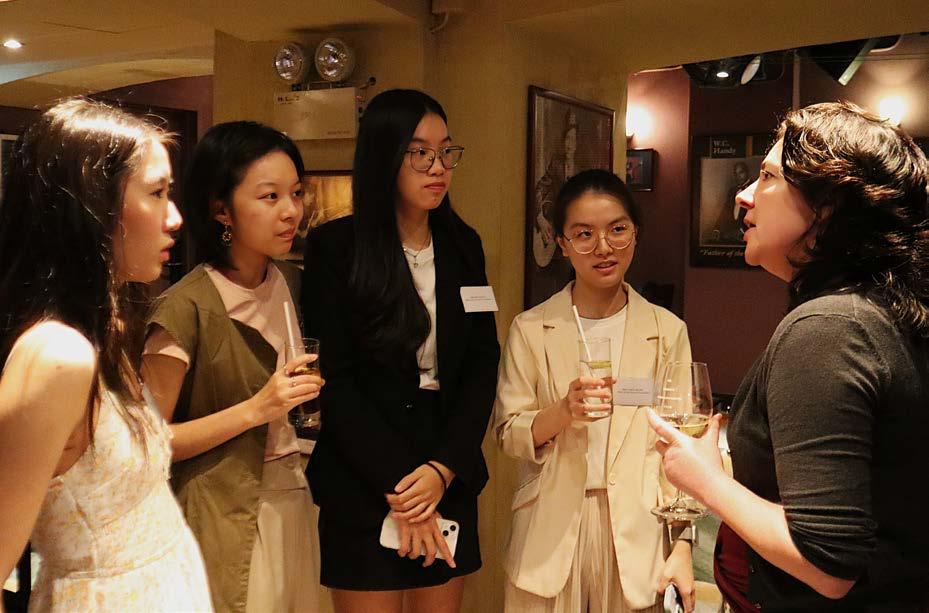
The FCC was delighted to celebrate Diwali with a festive Indian buffet at Bert’s on 4 November 2024. Our Indian culinary team members excelled as always with a superb selection of dishes as well as an action cooking station featuring dosa with coconut sauce and roti chanai. A great evening was had by all.
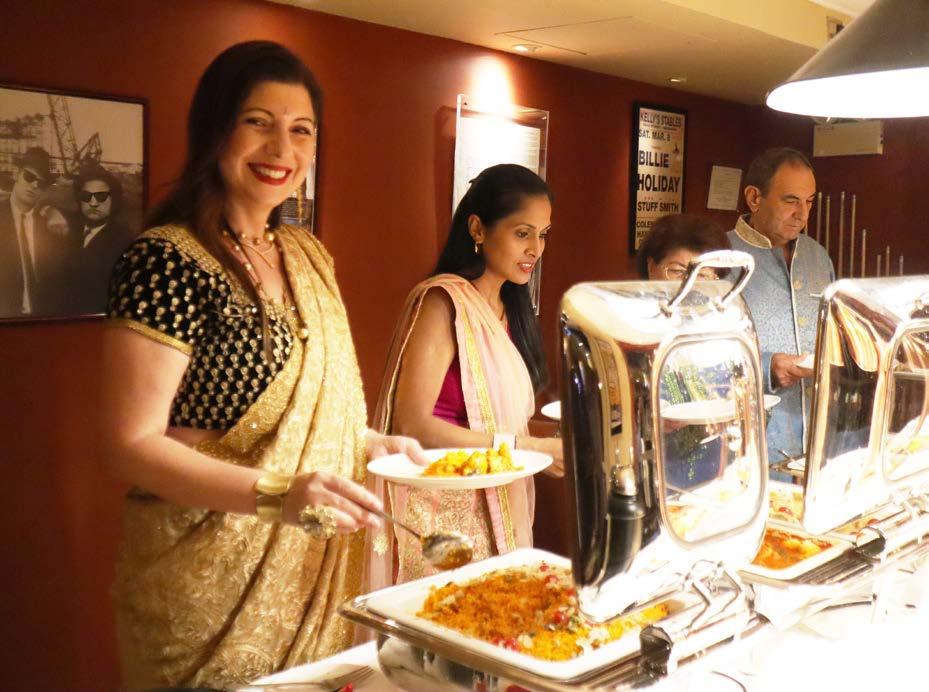


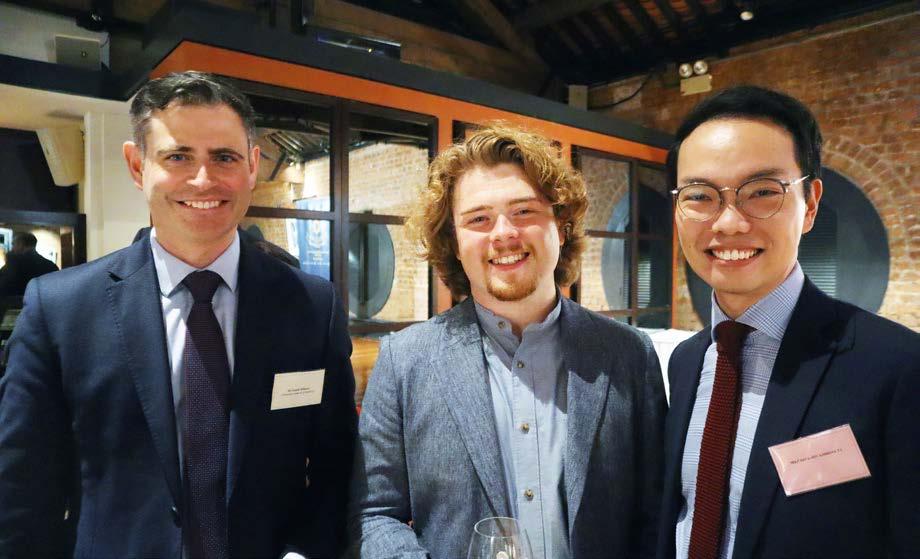
In celebration of 100 years of Surrealism, the FCC was honoured to once again feature the iconic photography of Basil Pao on the Hugh Van Es Wall, located in the Main Bar. December’s Wall Exhibition featured photomontages from Pao’s ‘On The Steppes of Dreams: The Surreal Century’ which was published in 2024. At the cocktail reception for the exhibition opening in December, Pao spoke about his latest work and celebrated with the FCC’s Wall Committee and Members. Thanks to the Board and Committee Members for your hard work on all the Wall Exhibitions in 2024.
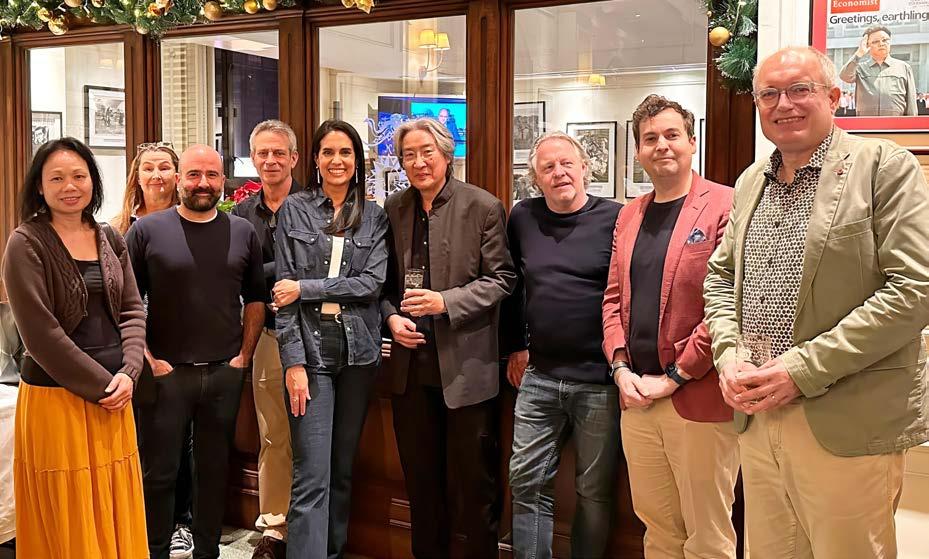
On 19 November, the FCC hosted diplomats from over 20 Consulate Generals in Hong Kong who mixed and mingled with our Journalist and Correspondent Members. Thanks to everyone who attended.
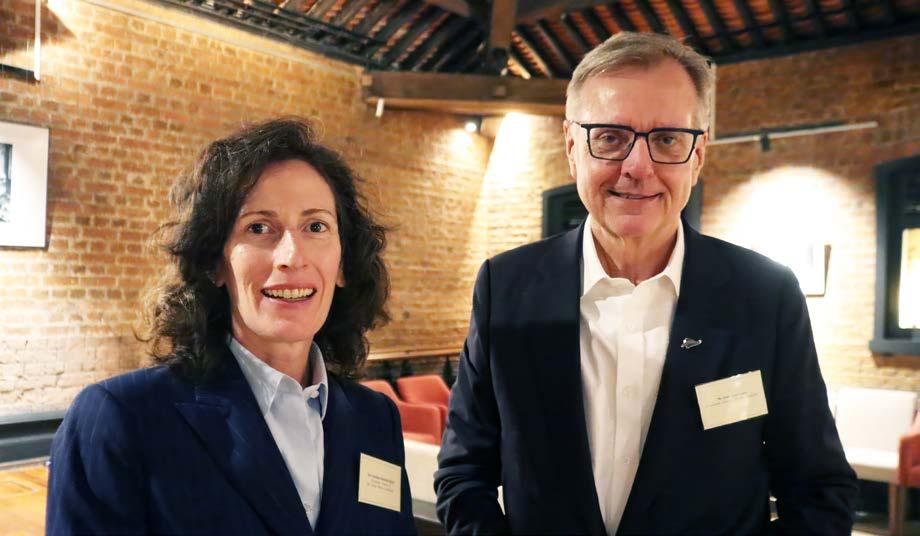
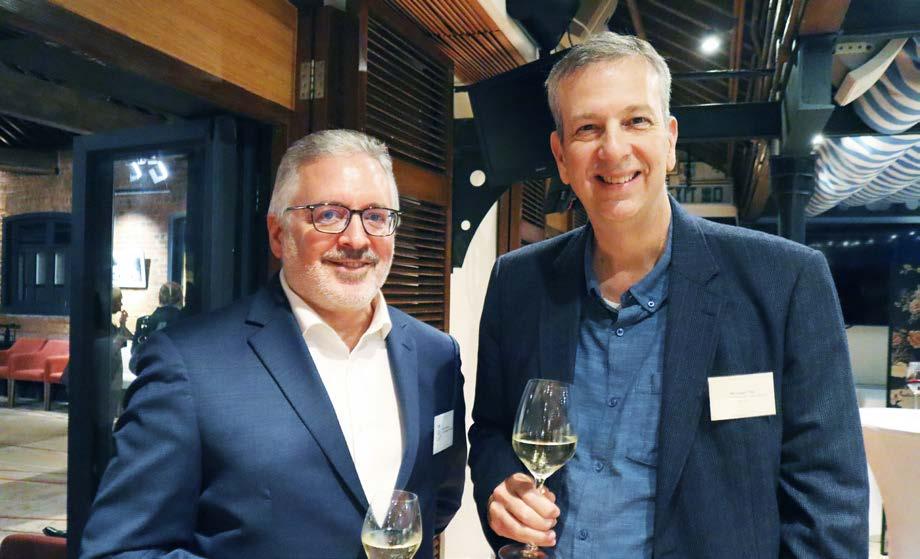
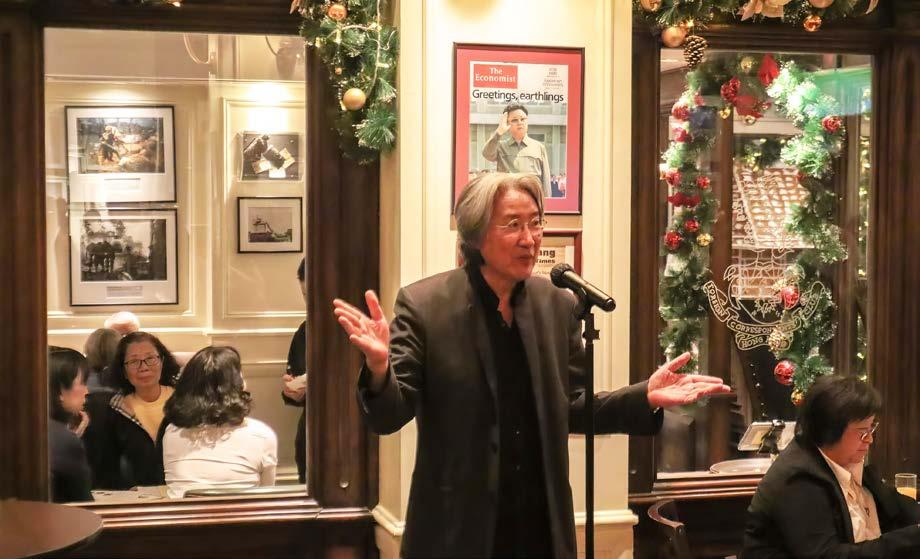
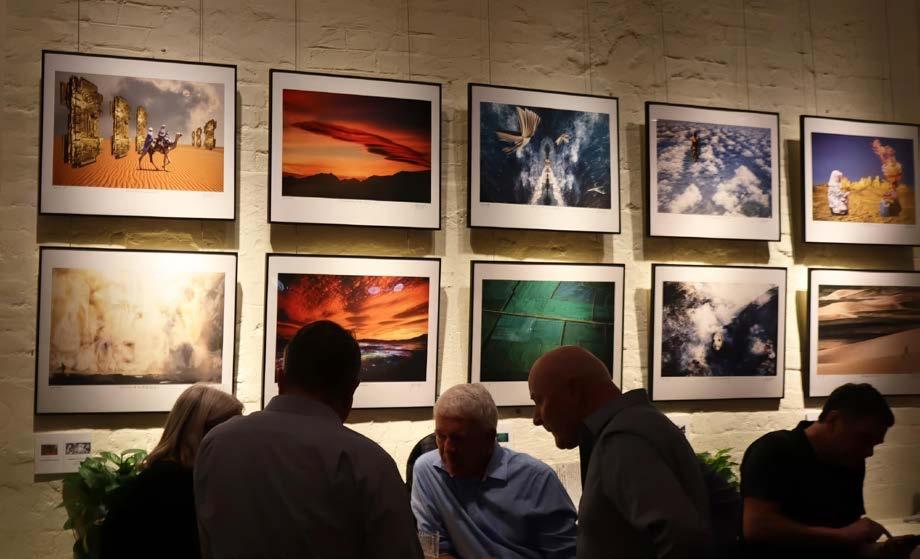
12 and 13 December welcomed Members and their guests to the FCC’s ever-popular Christmas Bazaar featuring unique gifts and delicious treats including wine, gourmet food items and glassware - perfect for the season of giving.
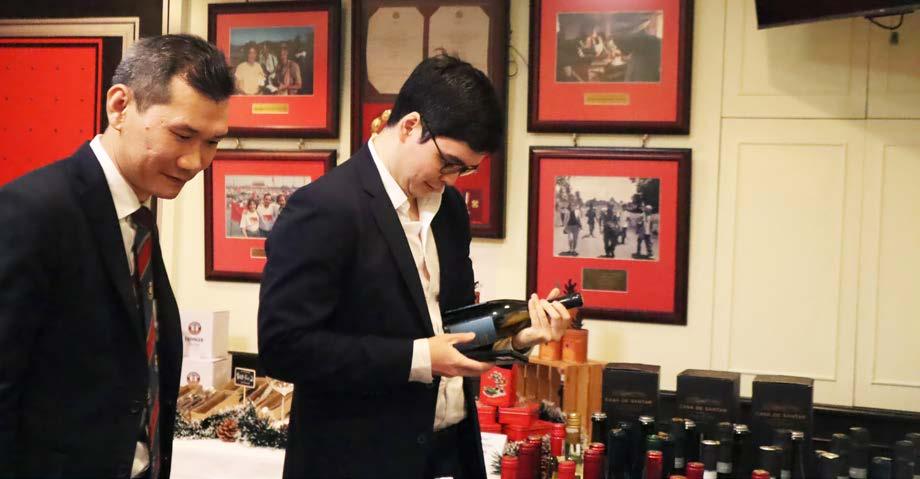
As is tradition at the FCC, on 18 December, the Hong Kong Welsh Male Voice Choir sang their hearts out at the Club, as the festive season moved into full swing. Members enjoyed an evening filled with the Choir’s repertoire of everyone’s favourite Christmas carols. The Hong Kong Welsh Male Voice Choir was founded in 1978 and is always keen to welcome new members to its ranks, Welsh or otherwise.
As always, Christmas Eve and Christmas Day saw the Club at full capacity as Members enjoyed the festive feasts conjured up by the culinary team. Highlights of the 5-course Christmas Eve Dinner included Kanak Blue Prawn Tartare with French Caviar, Crab Bisque with Spanish Chorizo and Sous-Vide and grilled Orange-Fed Wagyu Beef Chuck, topped off with a sensational, sweet Panetonne.
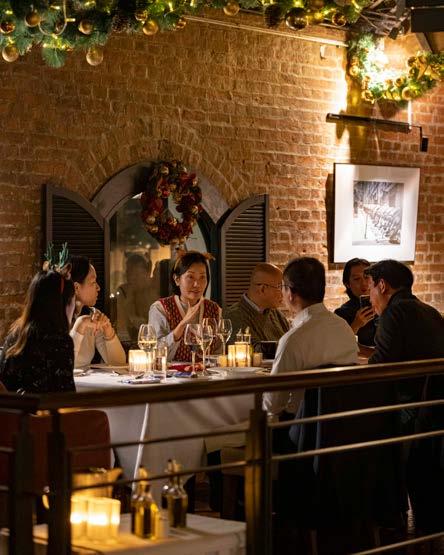
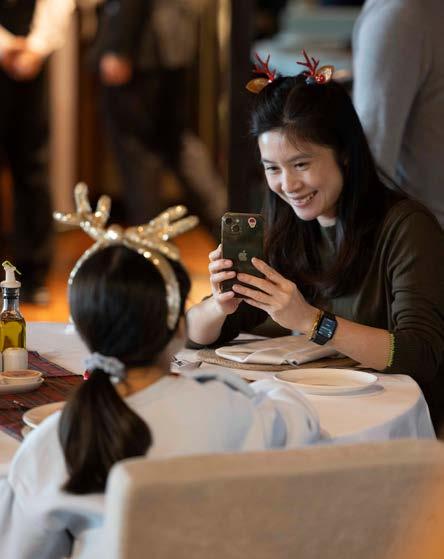

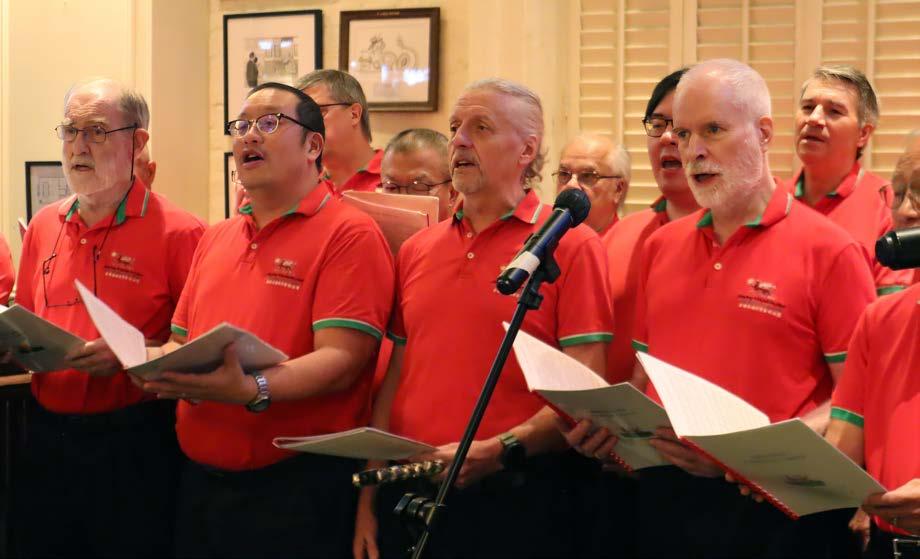
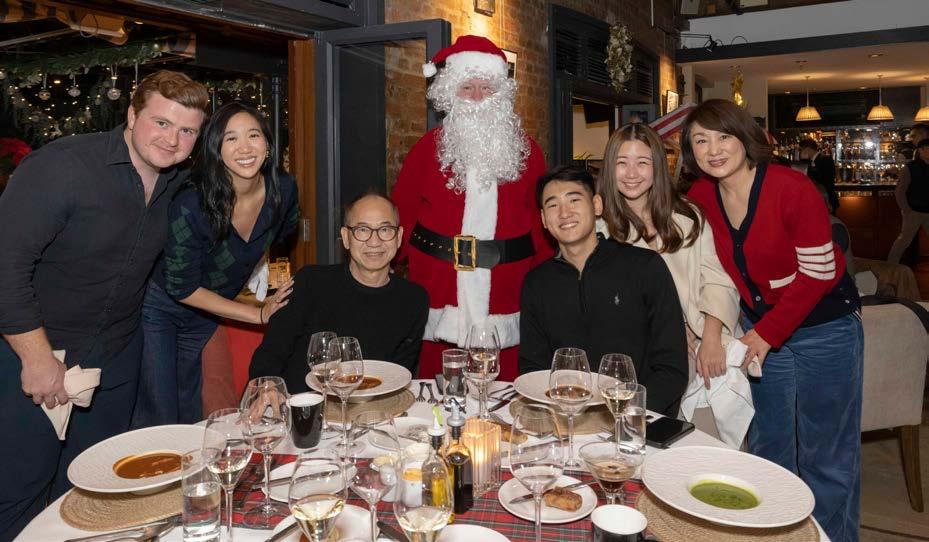
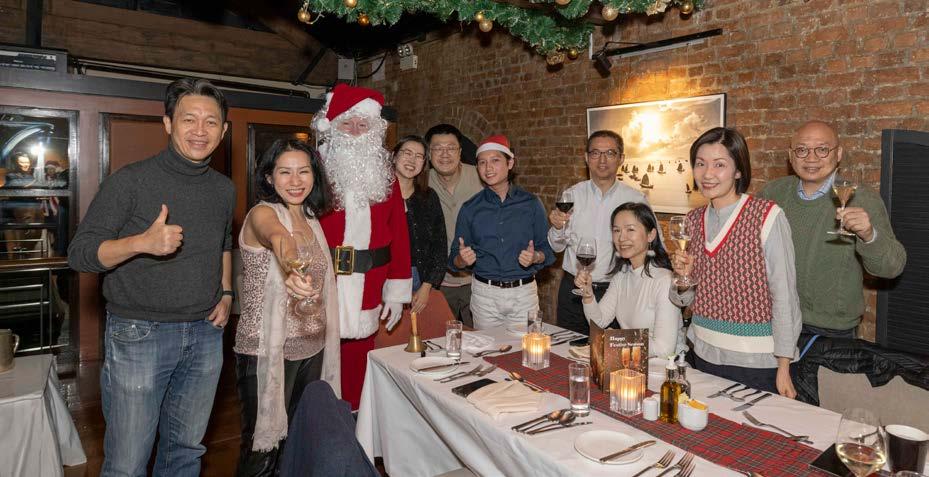
The Christmas Day buffet featured everyone’s traditional favourites including U.S. Butterball turkey with all the trimmings, freshly shucked oysters, a variety of fresh seafood and a special festive dessert station. A joyful time was had
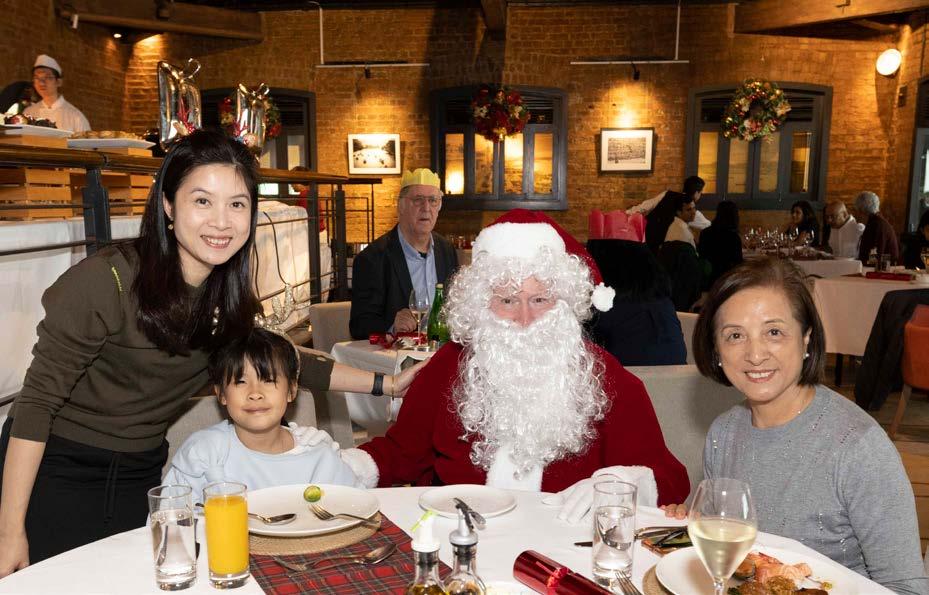
Members were given a ‘License to Thrill’ at the Club’s 007 themed New Year’s Eve extravaganza with a buffet dinner, live music and beats from DJ Mr Sit (his 25th year in a row!). Prizes were awarded for the best costumes and a memorable time was had by all.
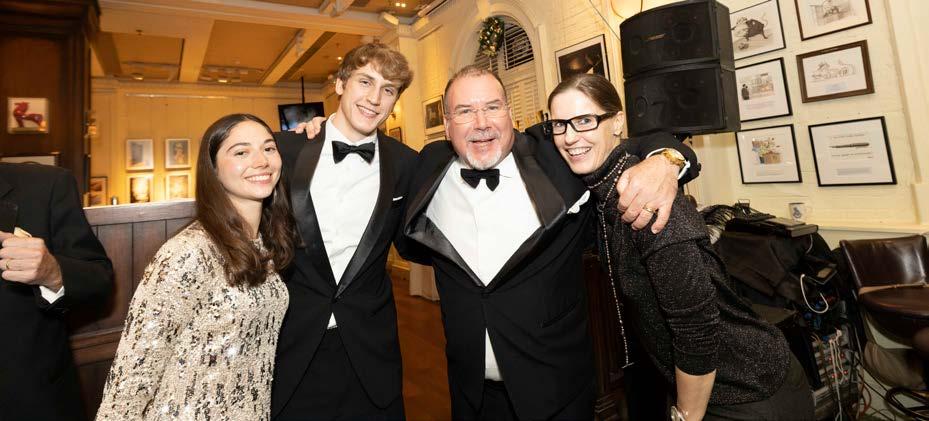
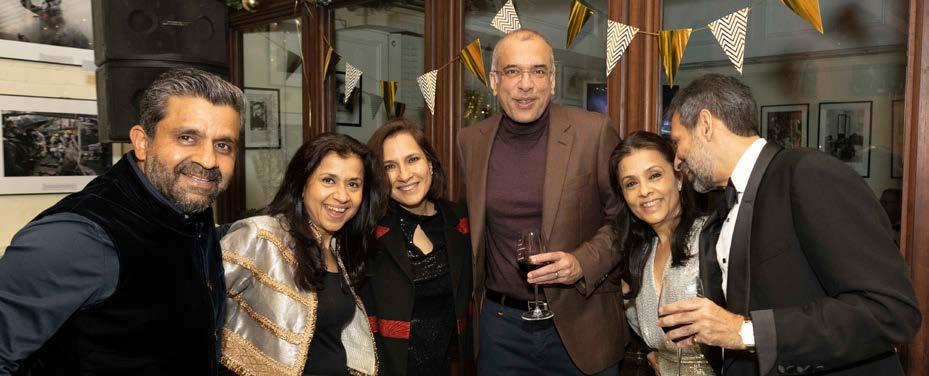
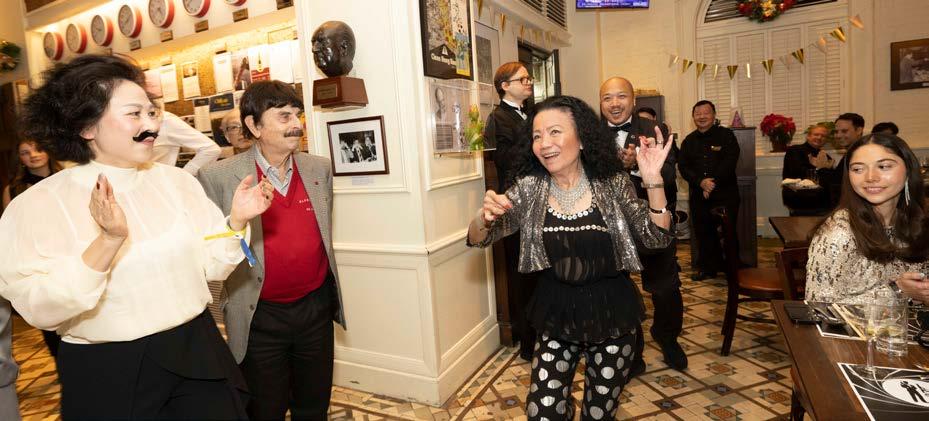
by all our guests, and we toast all of our hard-working staff, including Santa, who put every effort into making it truly the most wonderful time of the year.
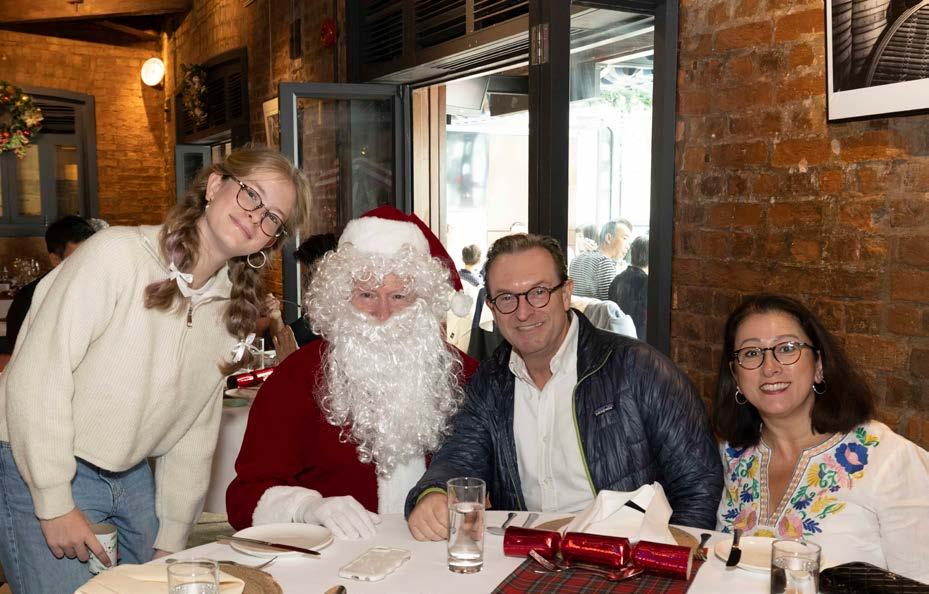
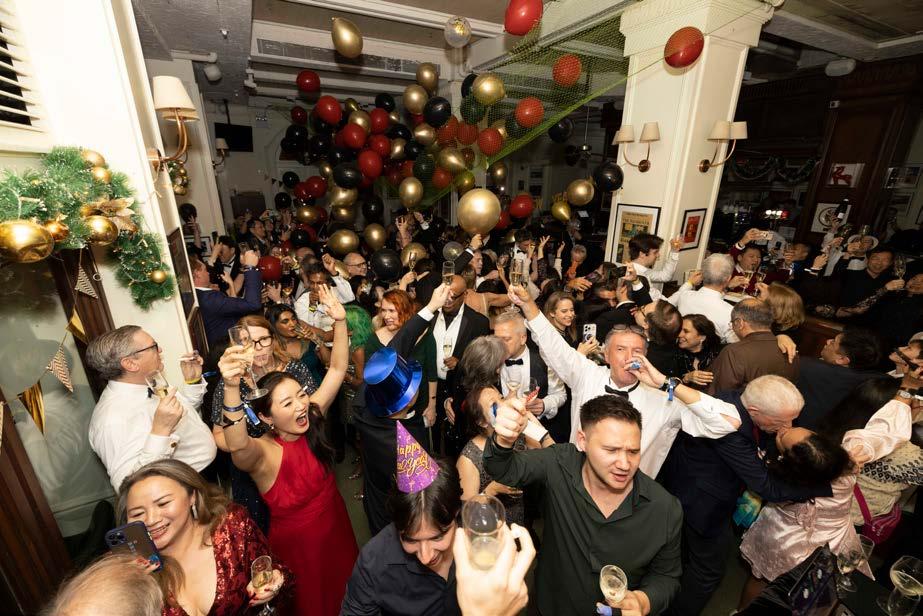
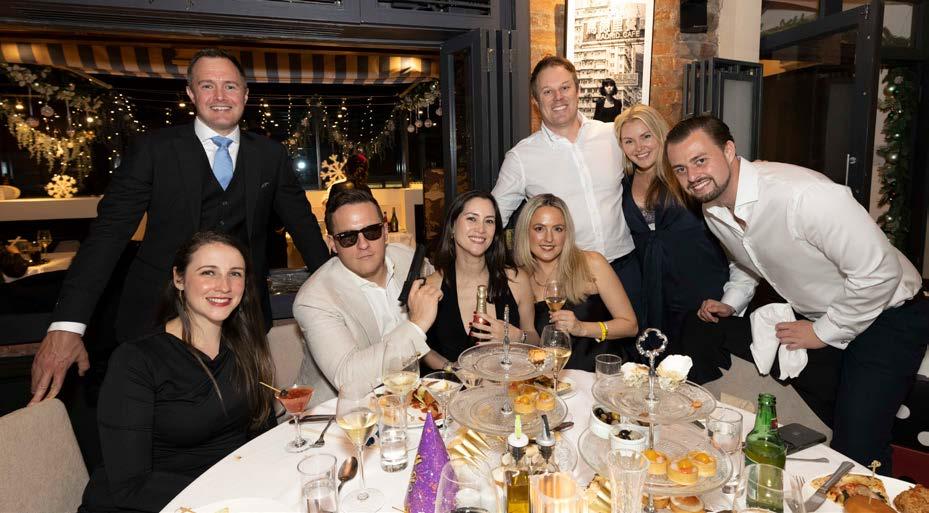
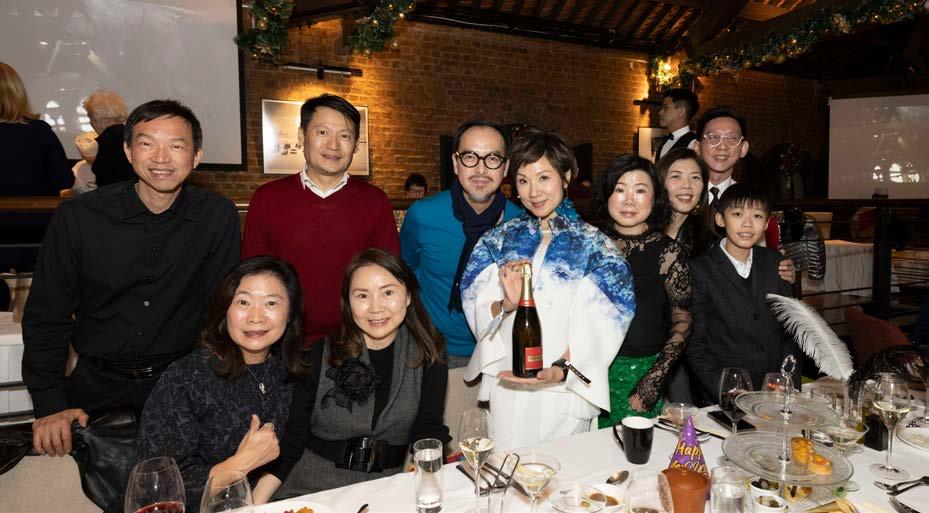
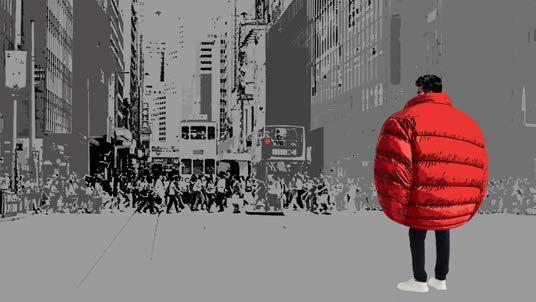
Wintertime in Hong Kong! A season many enjoy for the cool weather and low humidity. Not me, I’m no fan of the cold, so I’m sitting in the southern hemisphere writing this column as the temperature nears 35°C. But enough about my beach holiday…
The winter season in Hong Kong brings out one thing above all else; the quintessential Hong Kong auntie puffer jacket! Well before temperatures plummet (and I use that word loosely, we’re not in Harbin here), the Uniqlo and Uniqlo knock-off puffer jackets emerge from the closet, appear like frost on an English farm, swathes of aunties and uncles rugged up like they’re about to tackle Mount Everest. After years of non-expert study, I’ve found the tipping point is when the temperature hits 20°C, which in truth isn’t THAT cold!
And do you know who I blame for puffer jacket season in Hong Kong? The British of course! Like all weird and woeful things in the world, one can place the blame firmly at the feet of the British Empire. But why are they to blame for the seasonal auntie puffer jacket bloom? Hear me out.
I’ve mentioned previously how strange I find it that white-collar professionals in Hong Kong are predominantly required to wear business suits during the summer. It boggles the mind that people can even take two steps outside without fainting in July. So, this remnant of the colonial era is the start of the problem.
So that our dearly beloved banker bros and lasses don’t actually pass out from heat stroke being suited up to the nines, our not nearly as loved landlords gifted us the joy of air-conditioning. Apparently the air-cons don’t come with
an instruction manual, as every single building in Hong Kong has the temperature set to 16°C. I’ve been warmer on a ski trip to Japan in a blizzard than I have been waiting in a doctor’s surgery in Hong Kong. When the doctor asks why you’re shivering, it’s always difficult to know whether it’s from an ailment-induced fever or just because the airconditioning has been set to “Antarctica”.
So, my theory is, after everyone retires from their banking jobs or the civil service, all of a sudden they don’t need to wear a double-breasted suit, and a gentle November breeze chills everyone to their very core. Again, I’d like to point out, this is a very non-scientific study, but I stand by it.
While I joke about the puffer jacket obsession in our fair (weathered) city, it does have consequences. If you’re going to rug up like the Michelin Man when the temperature hits 19, what happens when we get that rare super cold spell, and the mercury hits mid-to-low single digits?
There is a simple fix here; let the great and noble Hong Kong workers wear shorts/skirts and short-sleeved shirts in the summer! Preferably Hawaiian shirts, but that’s just me. In a generation’s time, everyone will have acclimatised and when it would normally be puffer jacket season in the SAR, we may see the emergence of the “long sleeved top” season instead.
I hope you all had a marvellous festive season, and welcome to a new year! May it be a fantastic one for us all. n
Aaron can be found online on Twitter/Threads/Instagram at @tripperhead, and the free nightly Hong Kong news Substack at tripperhead.substack.com




Steve Vickers & Associates ("SVA") is a specialist risk mitigation, corporate intelligence and security consulting company. The company serves financial institutions, private equity funds, corporations, high net-worth individuals and insurance companies and underwriters around the world.
SVA exists to assist clients in mitigating risk and, where necessary to respond swiftly and effectively to incidents or crisis situations.


• Investigative Due Diligence
• Initial Public Offering & Reverse Takeover
• Political Risk Assessments
• Advice on Countering Staff Defections
• Supply Chain Risk, Decoupling & Derisking


• Corporate Investigations
• Financial Investigations
• Fraud Investigations
• Asset Searching Services
• Litigation Support Services
• Anti-Corruption Investigations



• Corporate Security and Technical Services
• Risk Assessment & Crisis Consulting Services
• Kidnap & Ransom Consulting & Response Services
• Aviation Consulting